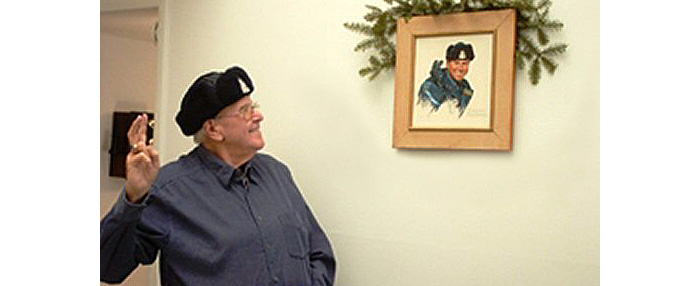Massachusetts State Police 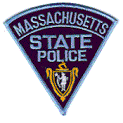
Massachusetts State Police 
From its inception in 1865 as a State Constabulary, The Massachusetts State Police has evolved into a modern full service law enforcement agency with a compliment of over 2300 officers.
Having the distinction of being the oldest state police organization in the United States, the Massachusetts State Police boast a rich history of service to the citizens of the Commonwealth of Massachusetts.
The actual beginning of the MSP as it is known by mandate today, began in 1921 and was called a "State Police Patrol". This force was comprised of 50 men who were stationed in barracks across the state with the primary mision to provide law enforcement to rural areas where service by local police departments was "undernourished". The MSP is an agency of the Commonwealth of Massachusetts Executive Office of Public Safety.
By the 1930's, the MSP had increased its ranks to around 250 officers. November 4, 1933 saw the first glimpse of the benchmark French and Electric Blue uniforms when the 25th MSP Recruit Class graduated. Those same distinctive colors adorned the patrol vehicles of the MSP as they still do to this day!
The 1940's saw the MSP trying to maintain its mandate with fewer officers as many had enlisted for service in the military theaters of World War II. Up until 1971, Officers of the MSP worked 84 hour weeks in live-in barracks. The Governor of the day saw fit to abolish the live-in barracks system and lowered the MSP trooper's work week to 40 hours.
On July 1 1992, a new Department of State Police was dramatically increased to absorb the Metropolitan District Commission, the Registry of Motor Vehicles and the Capitol Police. The MSP is comprised of the following Troop locations: Troop A (Northeast) Troop B (West) Troop C (Central) Troop D (Southeast) Troop E (Mass Turnpike) Troop F (Logan Airport) Troop H (Metro Boston)
Since its inception, Massachusetts State Police patrol cars used standard passenger license plates with no reserved number bloc until 1959.
We have commenced the display of license plates here at 1921, as that was the year of the formation of the Uniform Branch of the Massachusetts State Police. The stand-alone term "Massachusetts State Police" as we know it today actually commenced in 1933.
As outlined above, the Bay State also comprised of other state-level policing in the form of the Registry of Motor Vehicles Police, the Metropolitan District Commission Police and the Capitol Police. These agencies will be discussed further down the page.
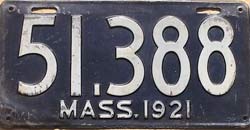 |
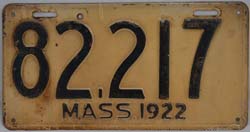 |
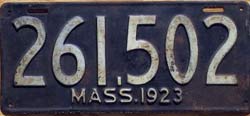 |
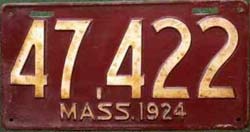 |
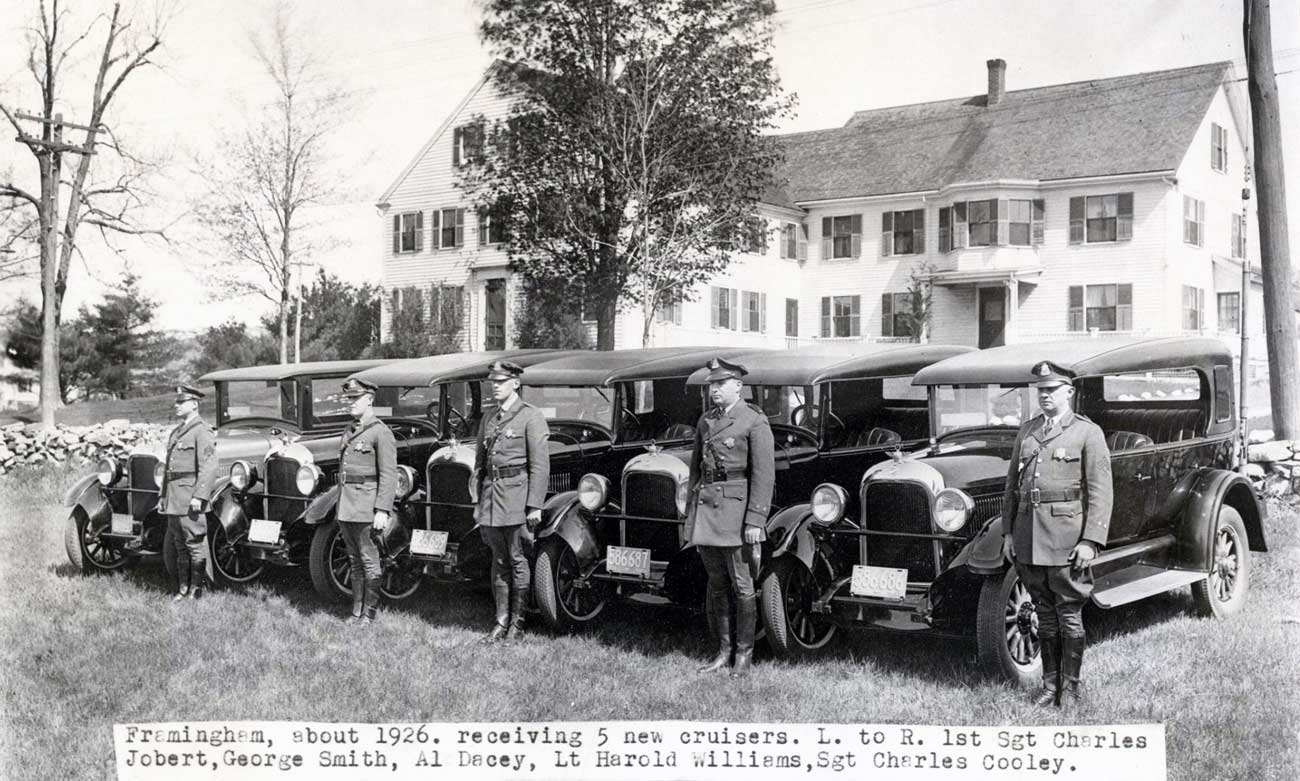 Five brand new 1926 Studebaker Duplex Phaeton Touring Sedans ready for patrol!
Five brand new 1926 Studebaker Duplex Phaeton Touring Sedans ready for patrol!
(Courtesy of Mike Slepetz)
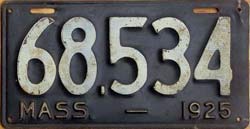 |
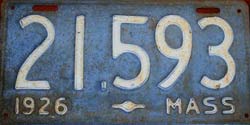 |
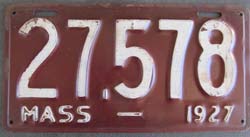 |
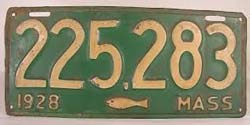 |
 1926. Courtesy of Massachusetts State Police Museum & Learning Center
1926. Courtesy of Massachusetts State Police Museum & Learning Center
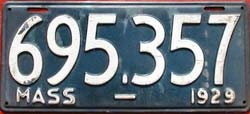 |
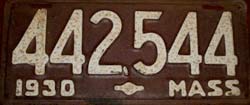 |
 |
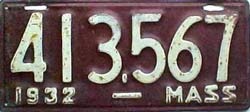 |
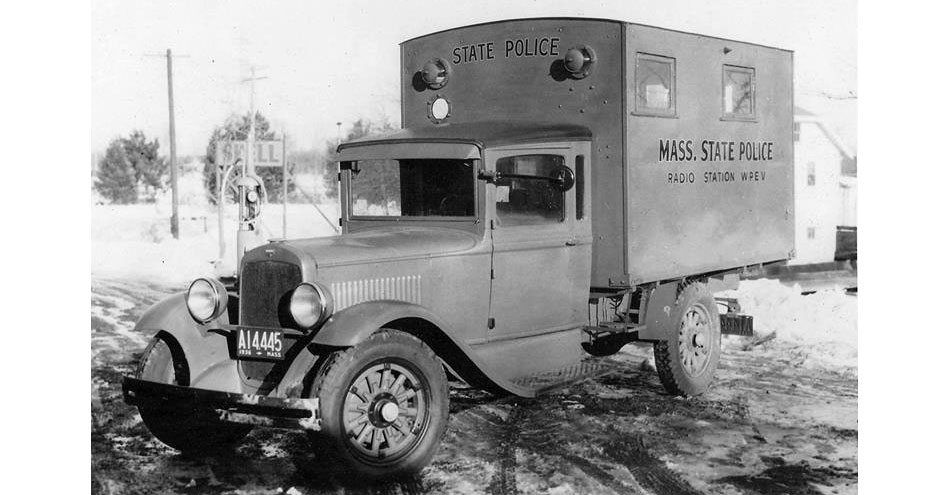 Radio Wagon-1930 with standard commercial series license plate.
Radio Wagon-1930 with standard commercial series license plate.
(Courtesy Jim Aitken)
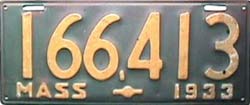 |
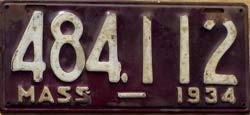 |
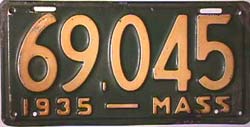 |
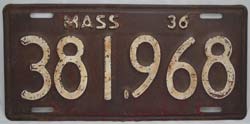 |
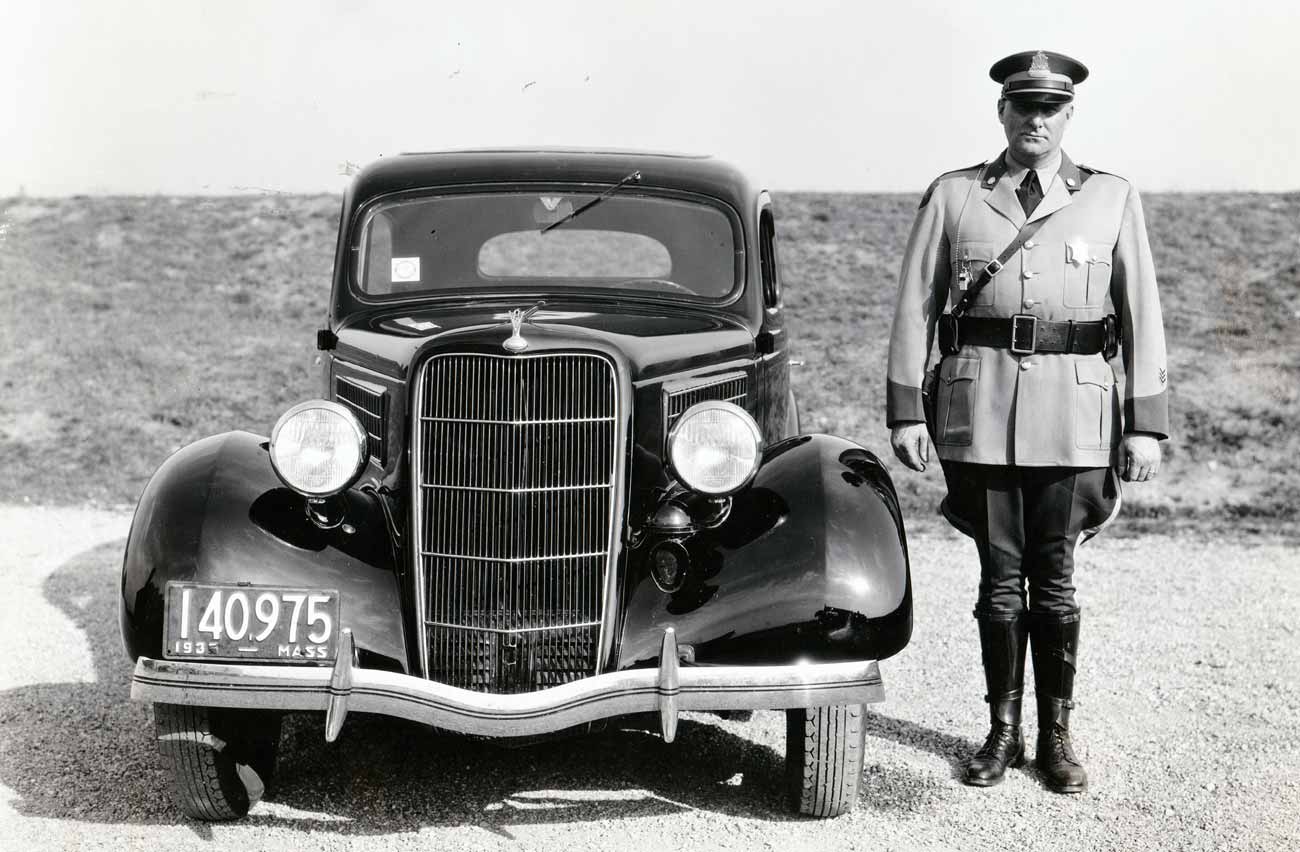 1935.
1935.
(Courtesy Mike Slepetz)
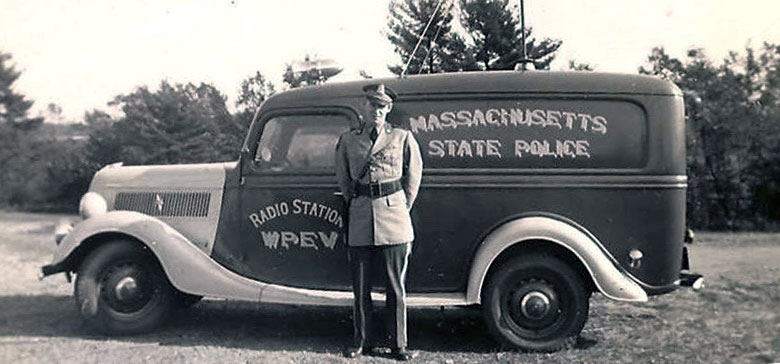 1937 Radio Wagon.
1937 Radio Wagon.
(Courtesy Jim Aitken)
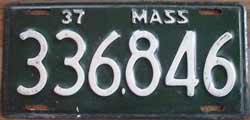 |
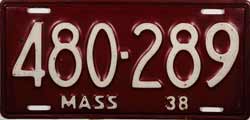 |
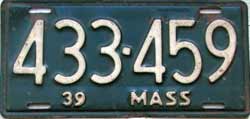 |
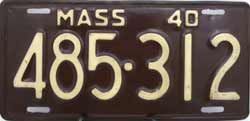 |
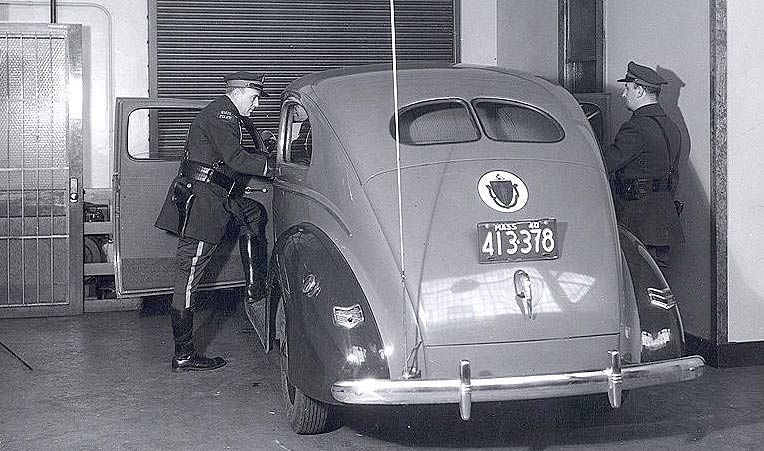 1940- Standard passenger series license plate used.
1940- Standard passenger series license plate used.
( Courtesy Norman Rhoades)
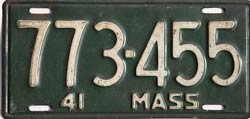 |
 |
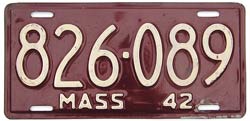 |
 |
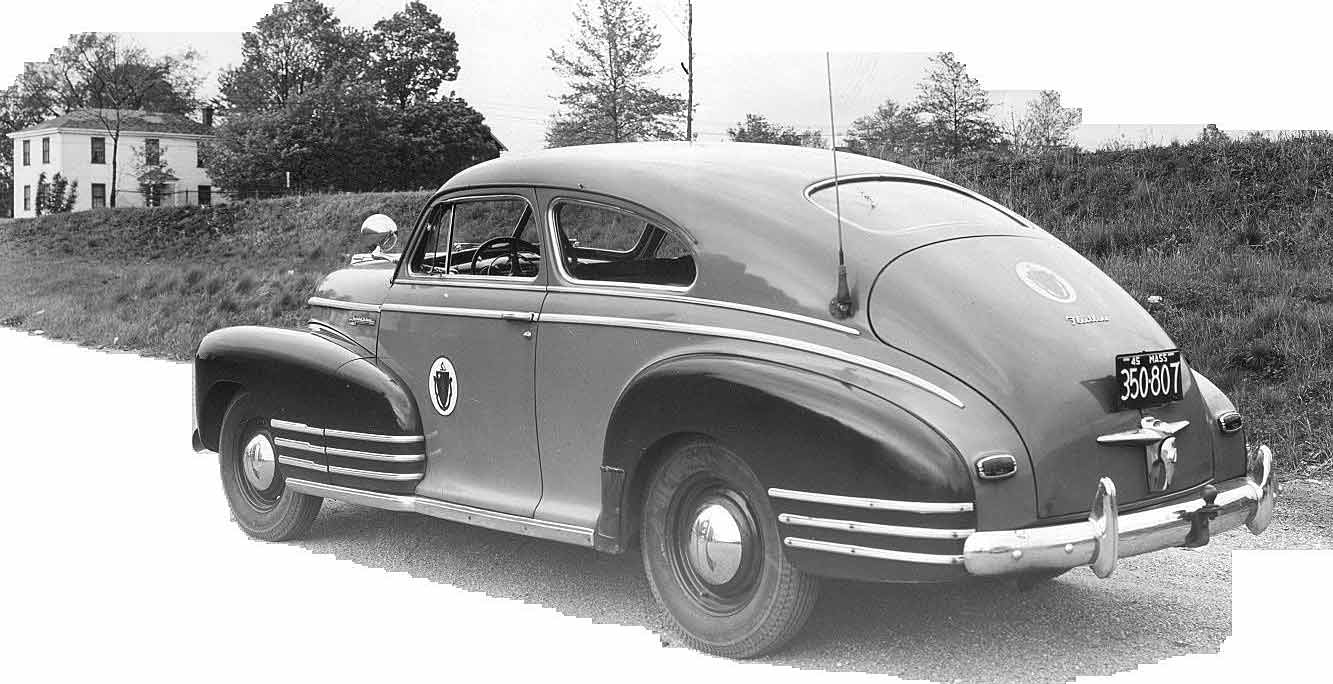 1945- Standard passenger series license plate used.
1945- Standard passenger series license plate used.
(Photo courtesy Hervey P. Coté)
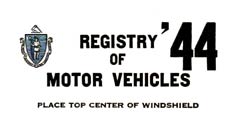 |
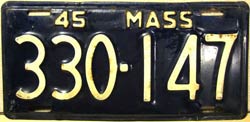 |
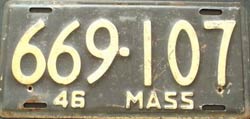 |
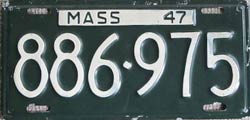 |
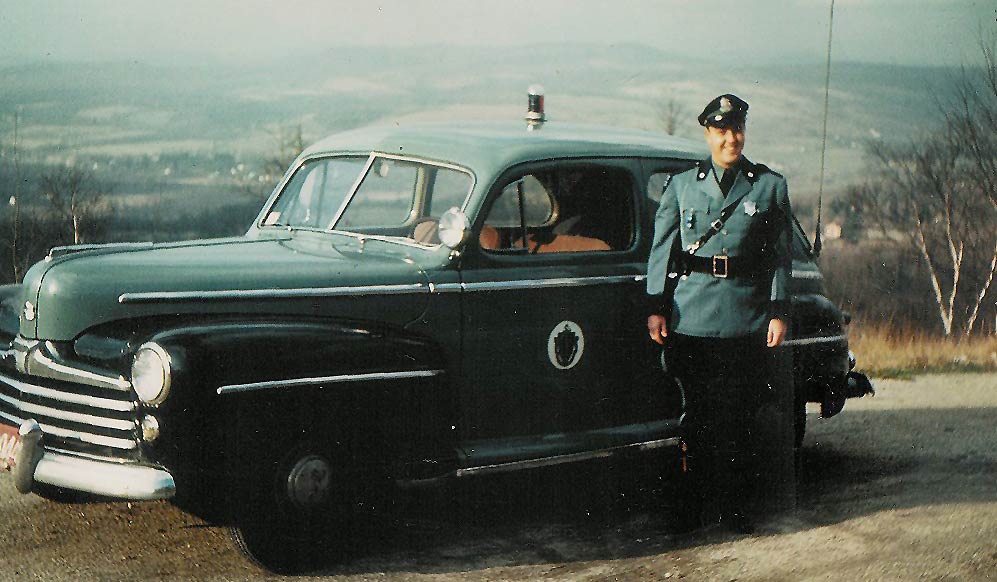 1948 Ford
1948 Ford
(Courtesy Bob Bricker)
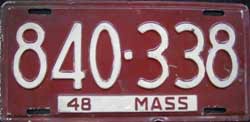 |
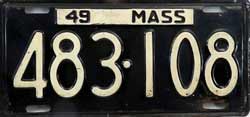 |
 |
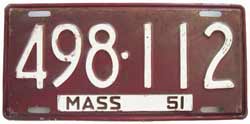 |
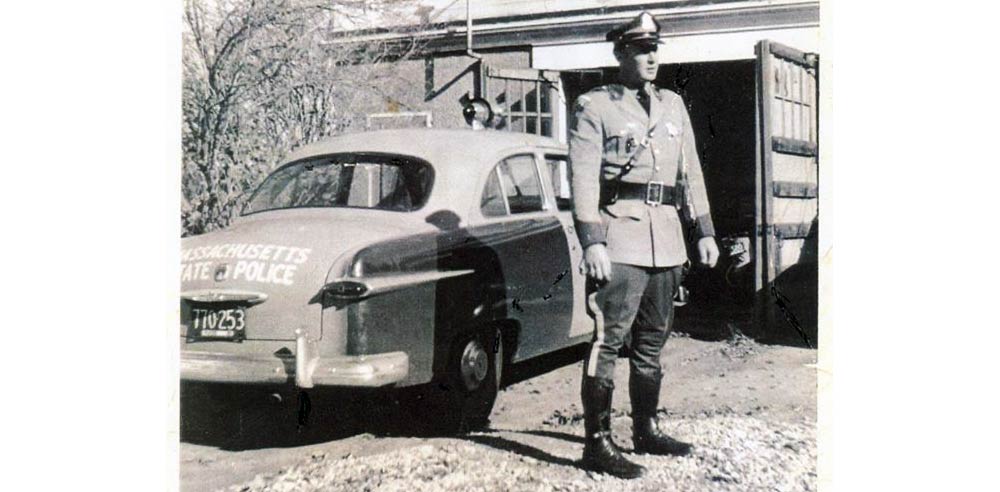 1952- Tpr Donald MacDonald- North Dartmouth.
1952- Tpr Donald MacDonald- North Dartmouth. 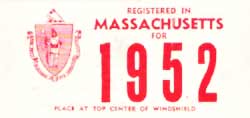 |
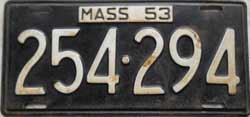 |
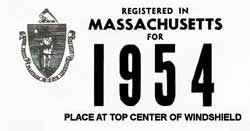 |
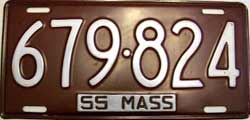 |
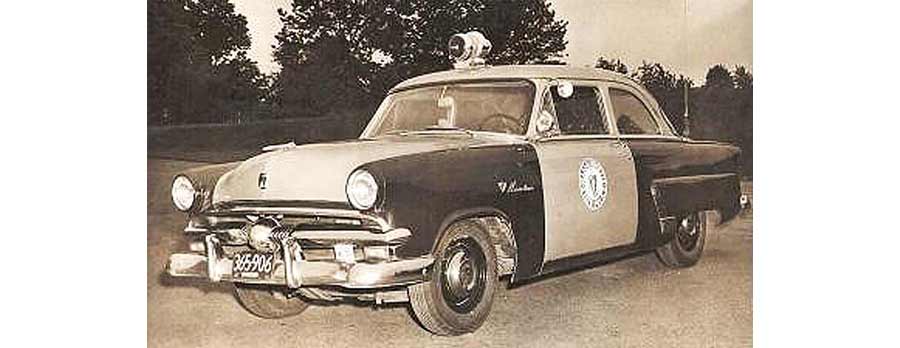 1954 MSP Ford Mainliner displaying white over maroon 1955 passenger license plate.
1954 MSP Ford Mainliner displaying white over maroon 1955 passenger license plate. 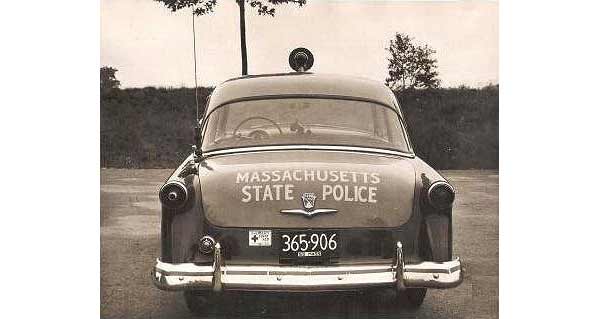
 1955 State Vehicle issue. Approx. 10" x 6 1/2". Embossed steel. It is believed by some that a small number of these State Vehicle license plates were used on MSP patrol vehicles of the day. The photographic evidence gathered thusfar does not corroborate this notion.
1955 State Vehicle issue. Approx. 10" x 6 1/2". Embossed steel. It is believed by some that a small number of these State Vehicle license plates were used on MSP patrol vehicles of the day. The photographic evidence gathered thusfar does not corroborate this notion. 
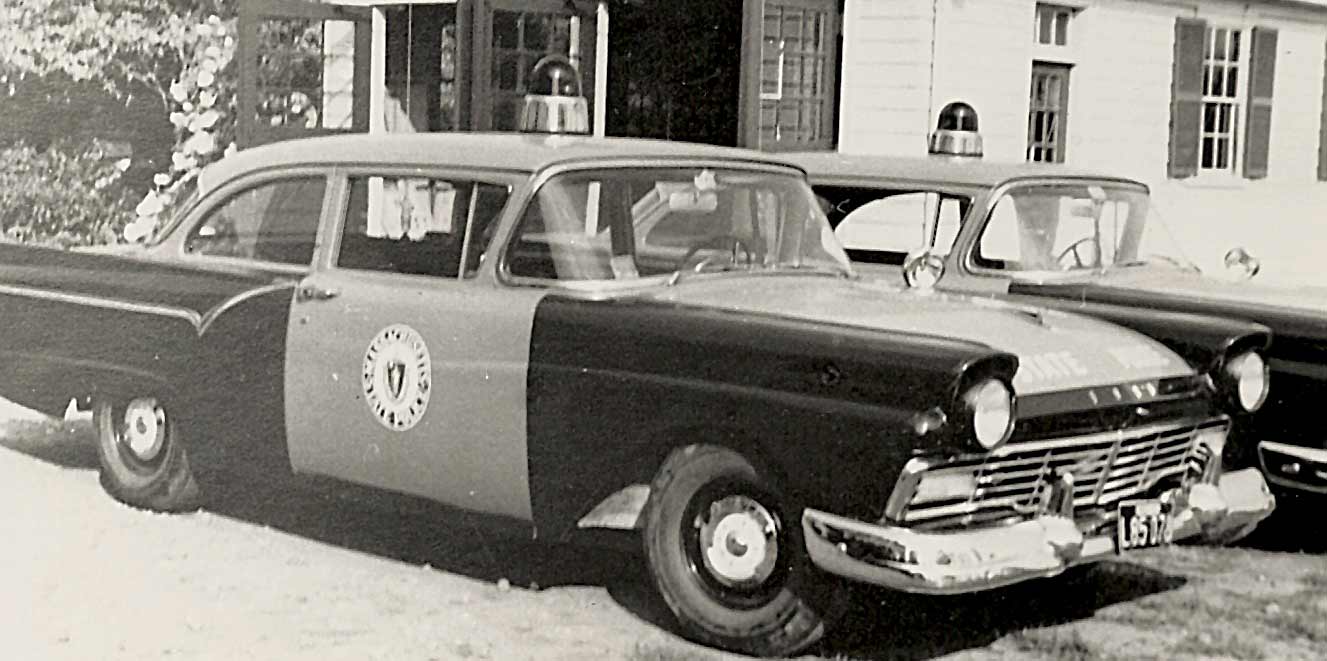
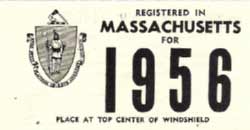 |
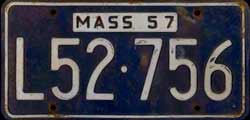 |
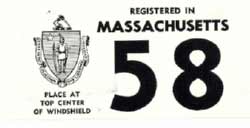 |
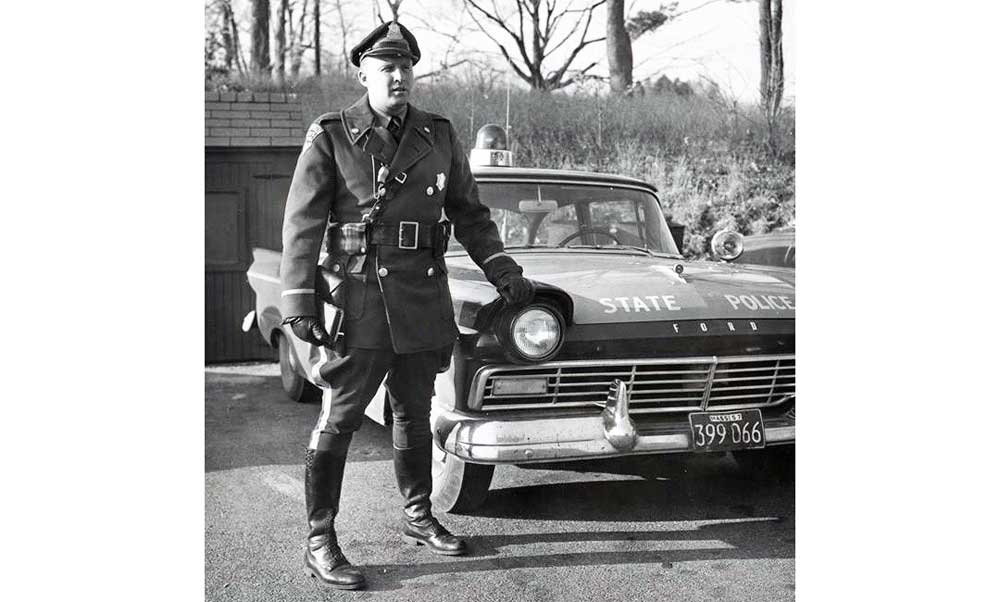 1957- Tpr Donald MacDonald- North Dartmouth.
1957- Tpr Donald MacDonald- North Dartmouth.
Standard passenger series license plate used.
(Courtesy Ron Guilmette)
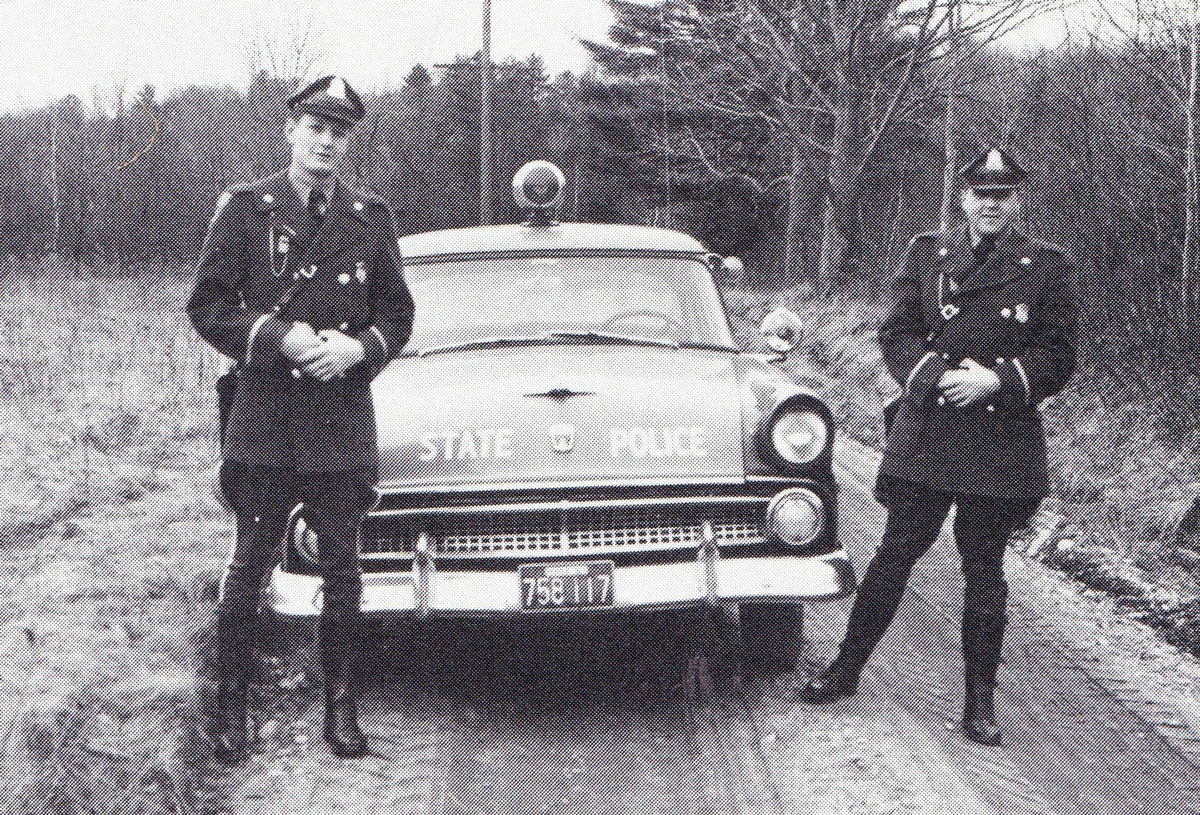 1957- The famed Norman Rockwell subject, Trooper Richard "Dick" Clemens at right the year before "The Runaway".
1957- The famed Norman Rockwell subject, Trooper Richard "Dick" Clemens at right the year before "The Runaway".
(Courtesy Mike Slepetz)
It is believed that in 1955, an "essay plate" with STATE over POLICE was made, however there are no records including photographs to confirm this belief.
In early 1959 and for the first time in their history, the Massachusetts State Police began issuing titled State Police license plates to replace the use of regular passenger license plates on their marked patrol vehicles.
The 1959 Massachusetts State Police license plate was first announced on August 15, 1958 in an internal RMV memo from William H. Bartlett to Mrs. Helen Sughrue, where the inaugural MSP titled license plates were described in paragraph B seen here: Click here to see the 1958 RMV document announcing the first MSP license plates. Provided courtesy of Henry Diorio. One hundred sets of the new plates were to be numbered between 23 and 232 at that time.
The plates were made of embossed steel and made in the color scheme as passenger car license plates of white over maroon and the same format using the "white rectangle box" with MASS 59 debossed inside in maroon situated between the upper mounting holes. The title STATE embossed over POLICE was placed on the left center field of the plate followed by an embossed number up to 3 digits. The numbers were issued in sequence with the lowest numbers reserved for ranking command staff. License plate #1 was believed at first to have been issued to MSP Commissioner Otis M. Whitney, however photographic proof from the Massachusetts State Police Museum & Learning Center shows that the #1 MSP plate MAY have been used on the limousine of Governor Foster Furcolo in tandem with the Governor's plate affixed to the front grille of the car. There is debate as to whether the Lincoln shown in the photo is that of the Governor of the state or the Commissioner of the MSP. Any confirmation either way would be welcomed.
All 1959 Massachusetts license plates were validated for 1960 by means of a windshield decal, however by March of 1959, the paint on the relatively new plates began to peel off causing the new plates to rust prematurely. A letter was penned on March 18 1959 by the MSP Lieutenant in charge of Supply Bureau to the Deputy Registrar of the RMV bringing the problem to his attention for remedy. By March 25th of that year, 109 brand new 1959 Massachusetts State Police license plates were manufactured and ready for pick-up by MSP.
Within a month, the 109 original run of rusty 1959 license plates were returned to the Registry and the improved versions had been affixed to the affected fleet.
Click here to see the correspondence between MSP and RMV outlining the problems with the original 1959 MSP license plates. Provided courtesy of Henry Diorio.
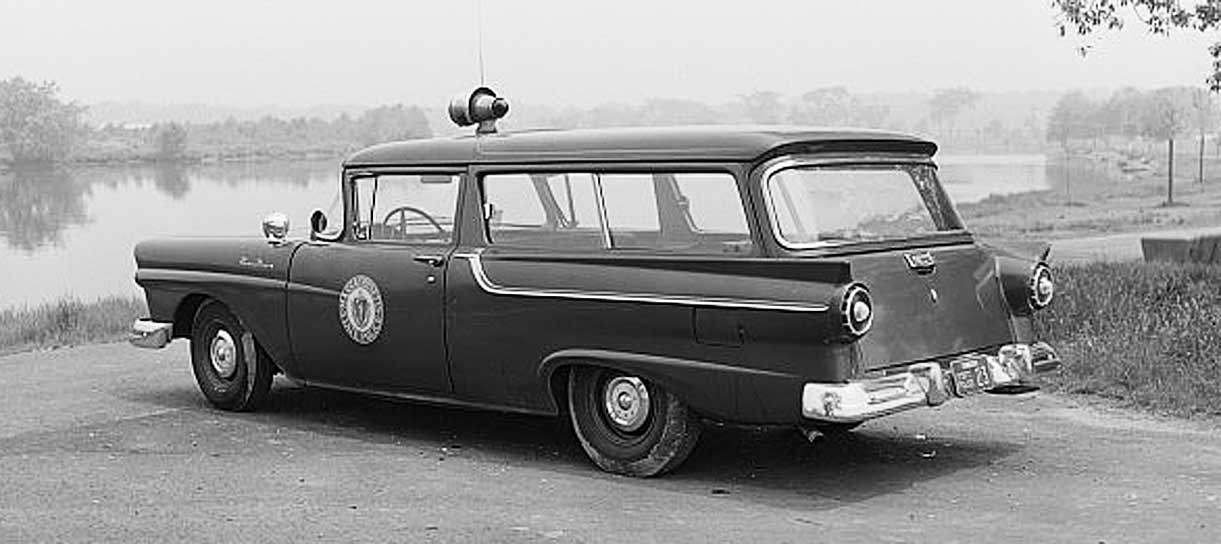 1957- Photo courtesy of Massachusetts State Police Museum & Learning Center
1957- Photo courtesy of Massachusetts State Police Museum & Learning Center
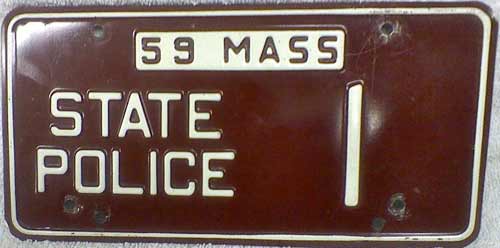
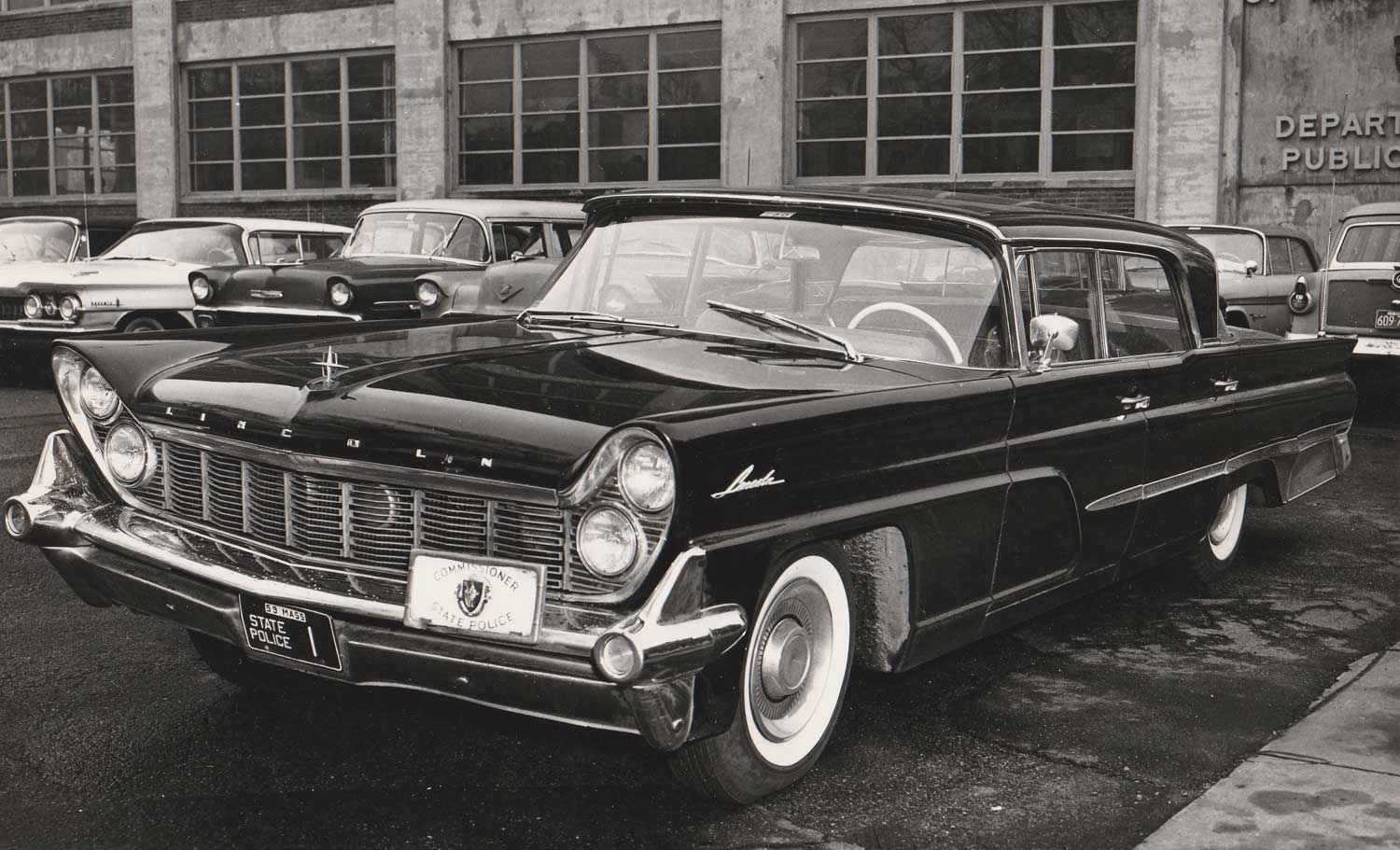
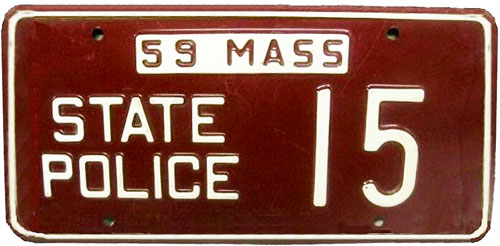 1959-1960 issue. First titled SP issue. Embossed steel.
1959-1960 issue. First titled SP issue. Embossed steel.  1958 Ford
1958 Ford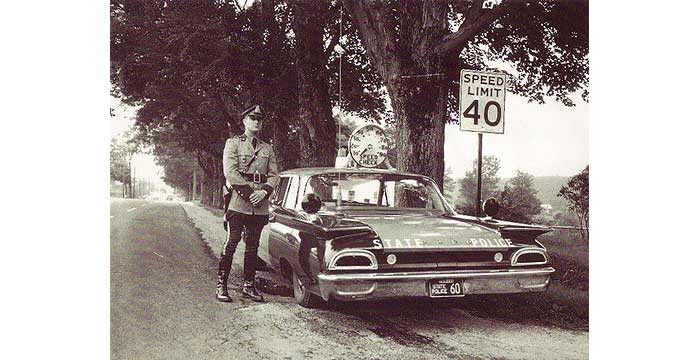 (Courtesy Bob Bricker)
(Courtesy Bob Bricker)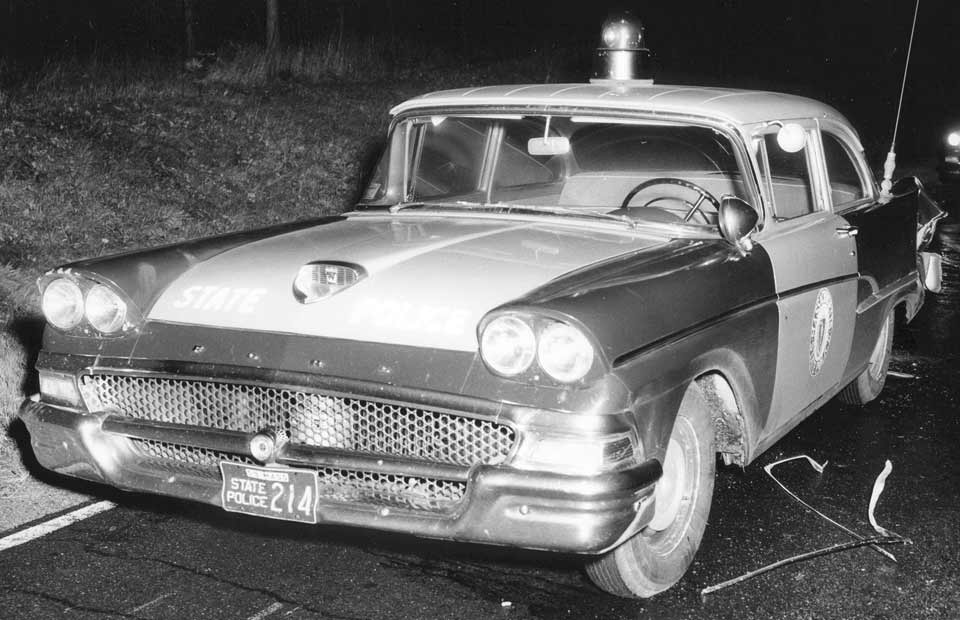 1958 MSP Ford displaying white over maroon MSP license plate.
1958 MSP Ford displaying white over maroon MSP license plate. 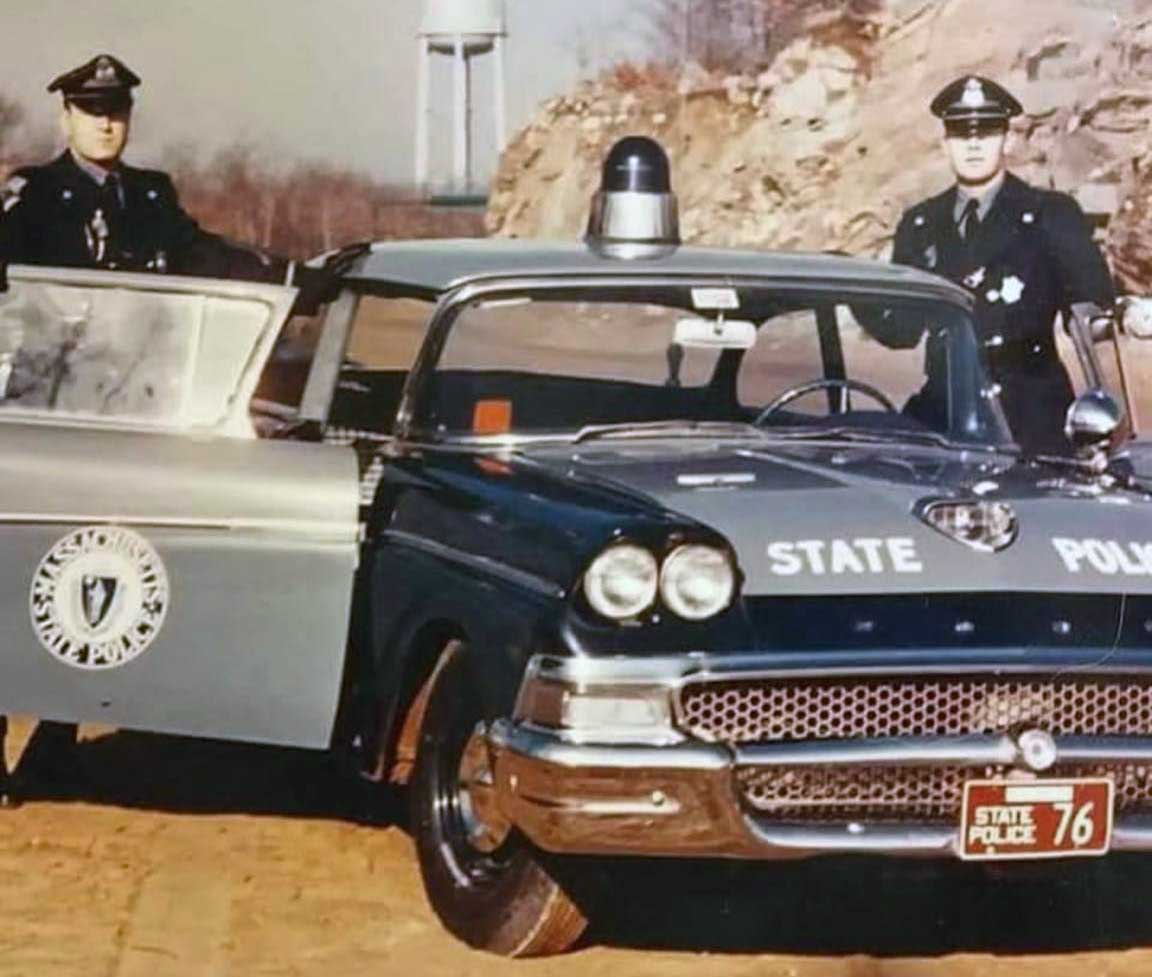 1958 Ford Custom 300
1958 Ford Custom 300 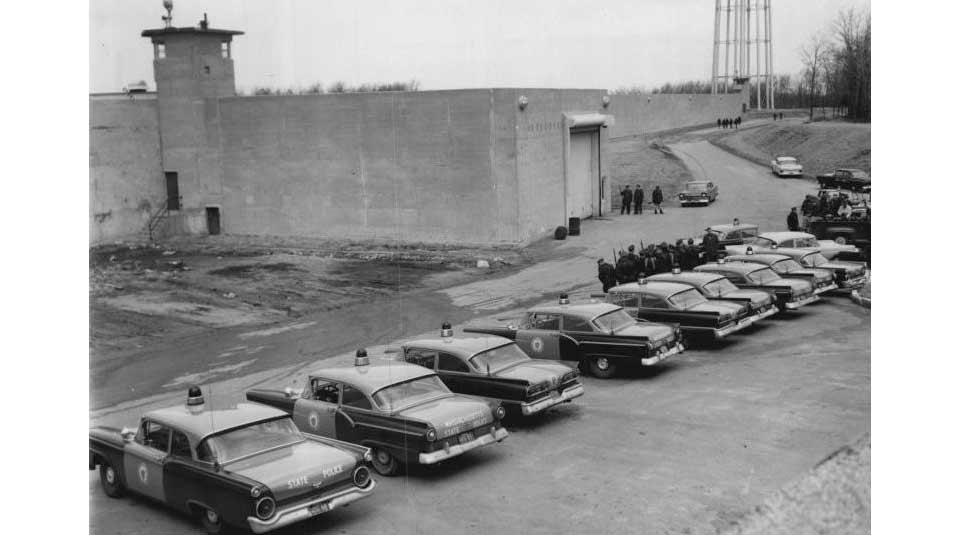 1959 Walpole Prison Riot
1959 Walpole Prison Riot 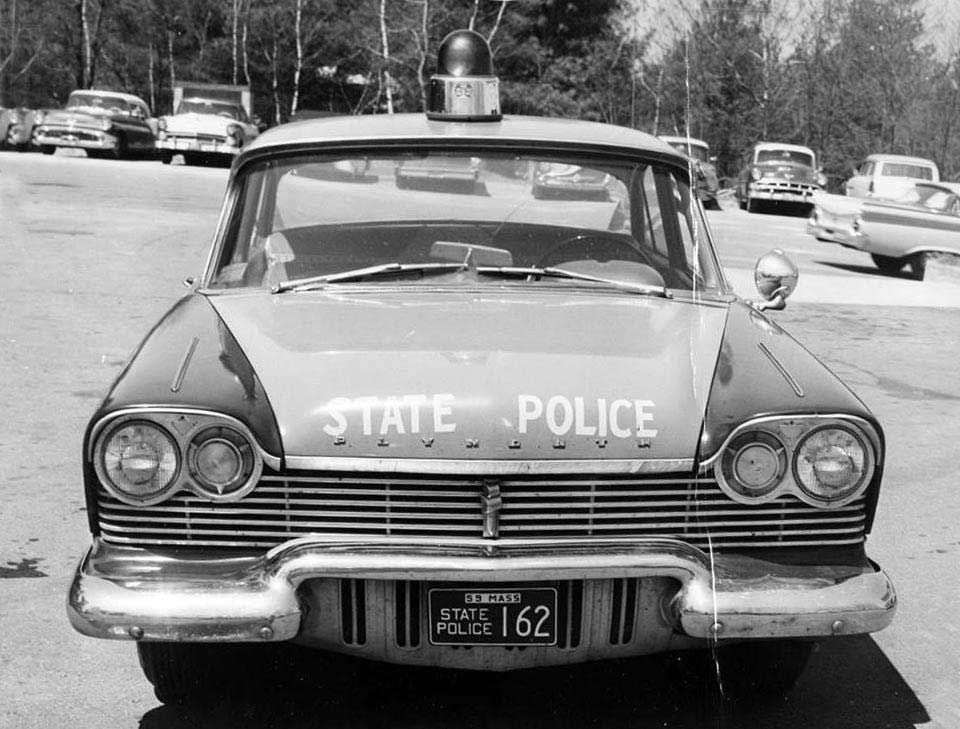 1957 Plymouth Savoy.
1957 Plymouth Savoy.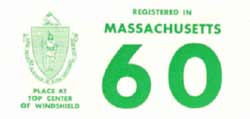 1960 Windshield Decal-Validated 1959 license plate
1960 Windshield Decal-Validated 1959 license plate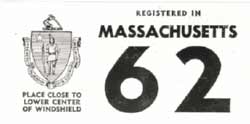 1962 Windshield Decal- Validated 1961 license plate
1962 Windshield Decal- Validated 1961 license plate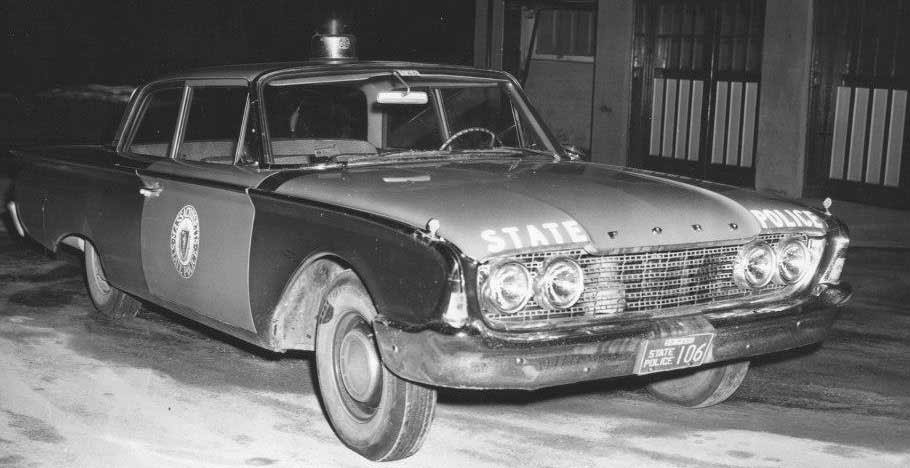 1960 MSP Ford displaying white over maroon 1959 MSP license plate.
1960 MSP Ford displaying white over maroon 1959 MSP license plate. 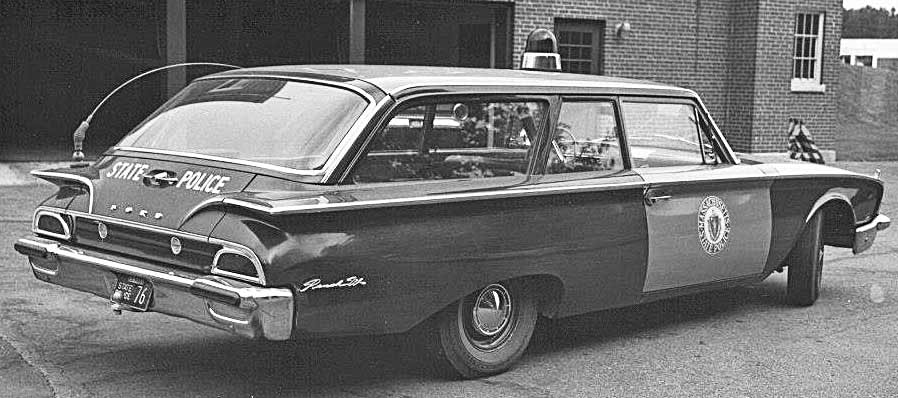 1960 MSP Ford Wagon displaying white over maroon 1959 MSP license plate.
1960 MSP Ford Wagon displaying white over maroon 1959 MSP license plate. On May 11, 1960, 109 new Massachusetts State Police license plates were ordered for the 1961 production run intended to replace the 1959 license plates.
The 1961 license plates followed the same format as the 1959 issue, but were colored white over green with MASS 61 in the white rectangle box in the top center of the plate. According to the order document, several numbers were omitted similar to the 1959 order. These plates were validated for 1962 by means of a windshield decal.
Click here to see the correspondence between MSP and RMV outlining the ordering and receipt of 1961 MSP and RMV license plates. Provided courtesy of Henry Diorio.
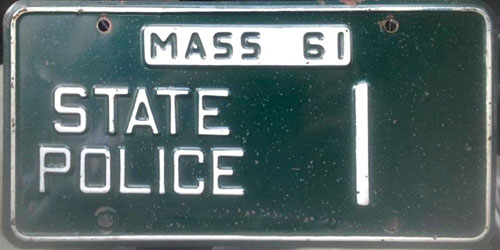 1961-1963 issue. Embossed steel.
1961-1963 issue. Embossed steel. 
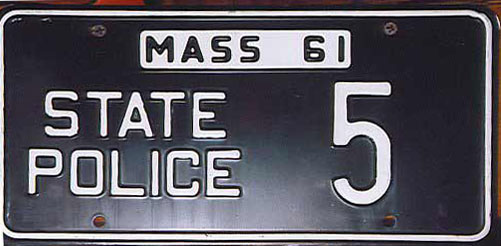 1961-1963 issue. Embossed steel.
1961-1963 issue. Embossed steel. 
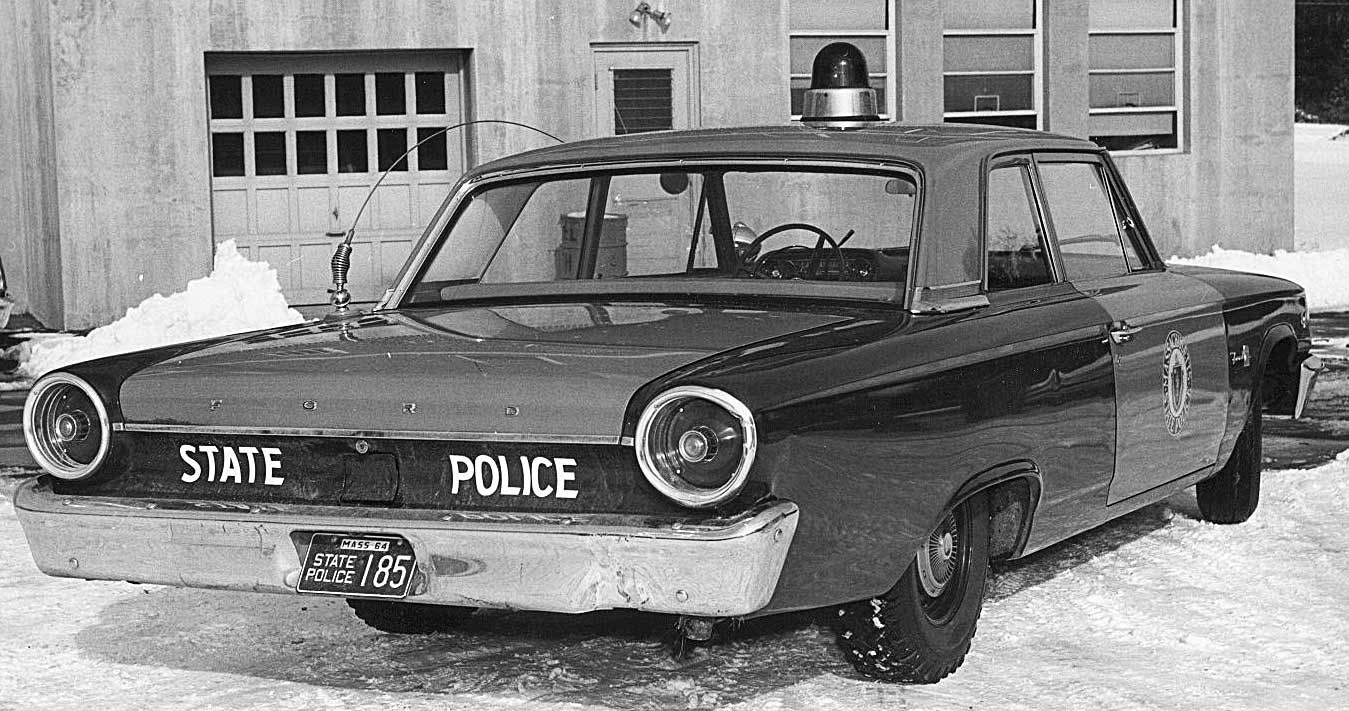 1963 MSP Ford displaying white over maroon 1964 MSP license plate.
1963 MSP Ford displaying white over maroon 1964 MSP license plate. 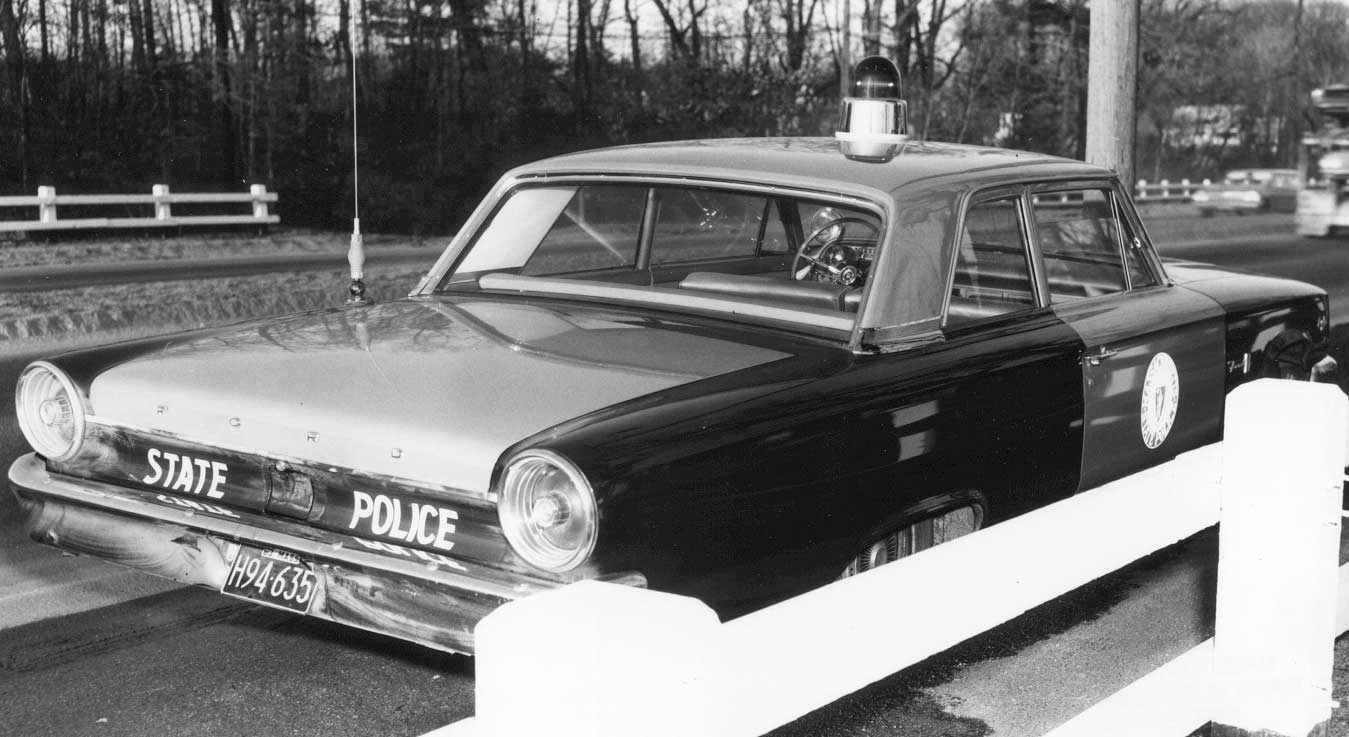 Marked MSP Ford bearing white/black 1963 PASSENGER CAR license plate.
Marked MSP Ford bearing white/black 1963 PASSENGER CAR license plate. On March 27th, 1963, 115 new Massachusetts State Police license plates were ordered for the 1964 production run intended to replace the 1961 license plates.
The 1964 license plates followed the same format as the 1961 issue, but were colored white over maroon with MASS 64 in the white rectangle box. According to the order document, much like previous orders, several numbers were omitted for unknown reasons. Some MSP cars were issued with 1963 passenger car license plates as an interim measure until a titled state police license plate could replace it.
In December of 1964, the Massachusetts Registry of Motor Vehicles requested for the MSP to test run 60 sets of "permanent" license plates on their "high speed cruisers" throughout the state from January 1 1965 until April 1 1965.
Although there is no record or personal recollection of what these test plates looked like, here is the breakdown of how the test license plates were deployed on New Years Day 1965:
Troop A (Framingham) ran numbers 42, 45, 46, 51, 52, 53, 56, 57, 58, 66, 67, 68, 75, 76 and 88.
Troop B (Northampton) ran numbers 104, 105, 107, 108, 109, 112, 113, 114, 117, 118, 119, 121, 122, 124, and 127.
Troop C (Holden) ran numbers 136, 139, 141, 149, 150, 154, 155, 156, 159, 160, 161, 162, 164, 165 and 166.
Troop D (Middleboro) ran numbers 185, 187, 188, 190, 204, 207, 208, 209, 210, 214, 217, 218, 221, 223 and 226.
The test plates were used on MSP cars until April 1 1965, and on April 7th of that year, all sixty sets of MSP test license plates were returned to the Deputy Registrar of the RMV for examination and disposal.
A complete breakdown for each involved cruiser with its start and end mileage during the three month period was compiled by Lt. Robert Tabaroni. Some cruisers logged an excess of 22,000 miles during that time while others didn't even get far out of the gate, like cruiser SP 187 that wrecked out on the first day of trial at 182 miles.
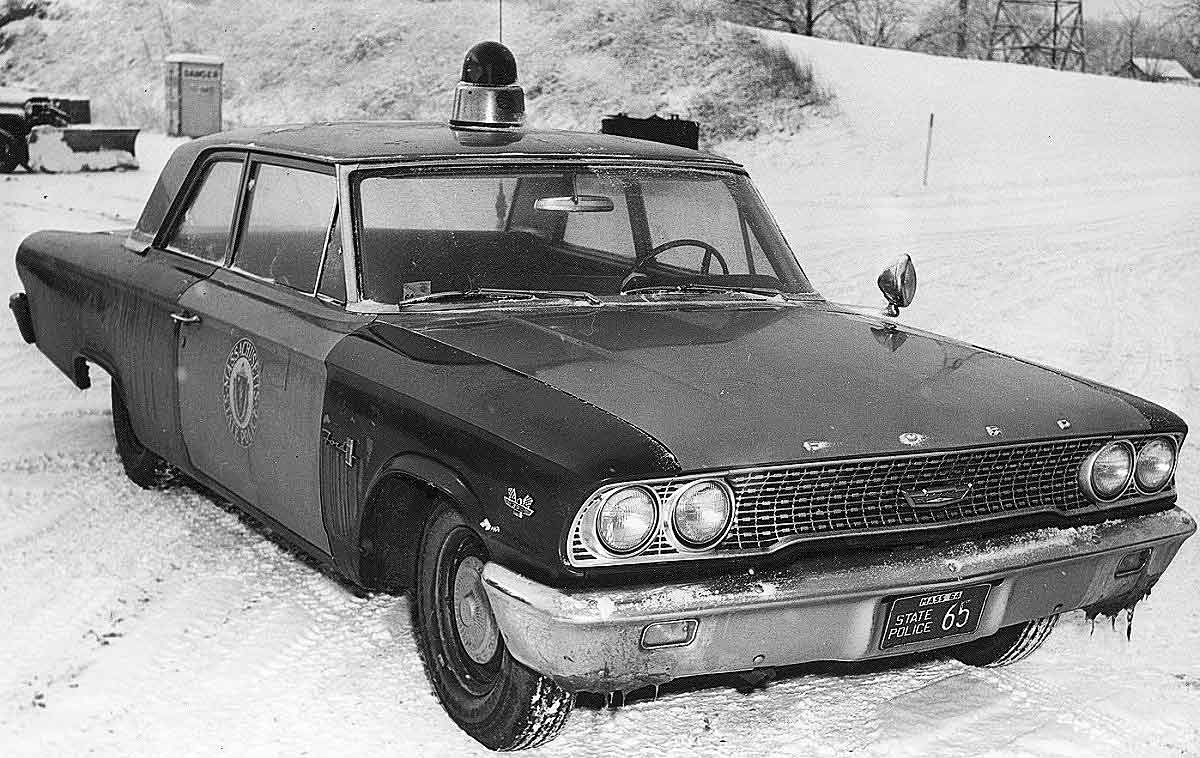 1963 MSP Ford displaying white over maroon 1964 MSP license plate.
1963 MSP Ford displaying white over maroon 1964 MSP license plate.
(Courtesy Hervey P. Coté)
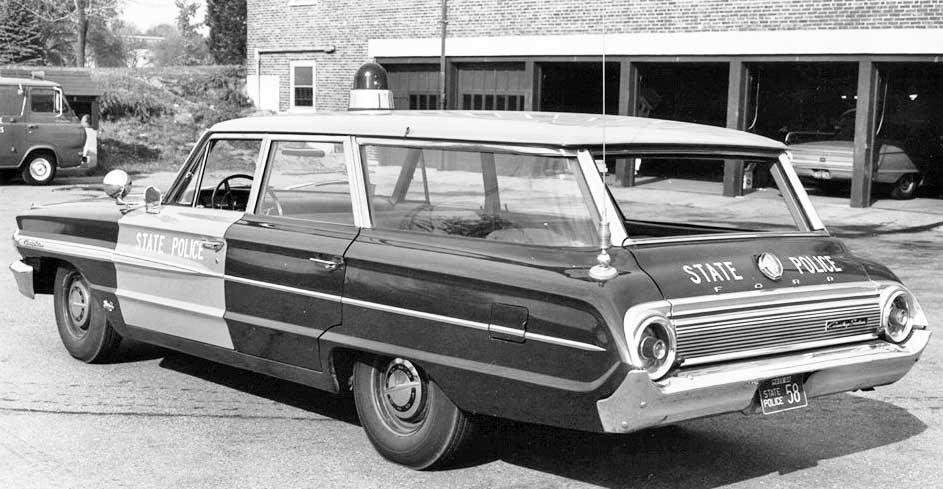 1964 Ford station wagon. Some MSP vehicles during this time did not use MSP door emblems.
1964 Ford station wagon. Some MSP vehicles during this time did not use MSP door emblems.
(Courtesy Michael Slepetz)
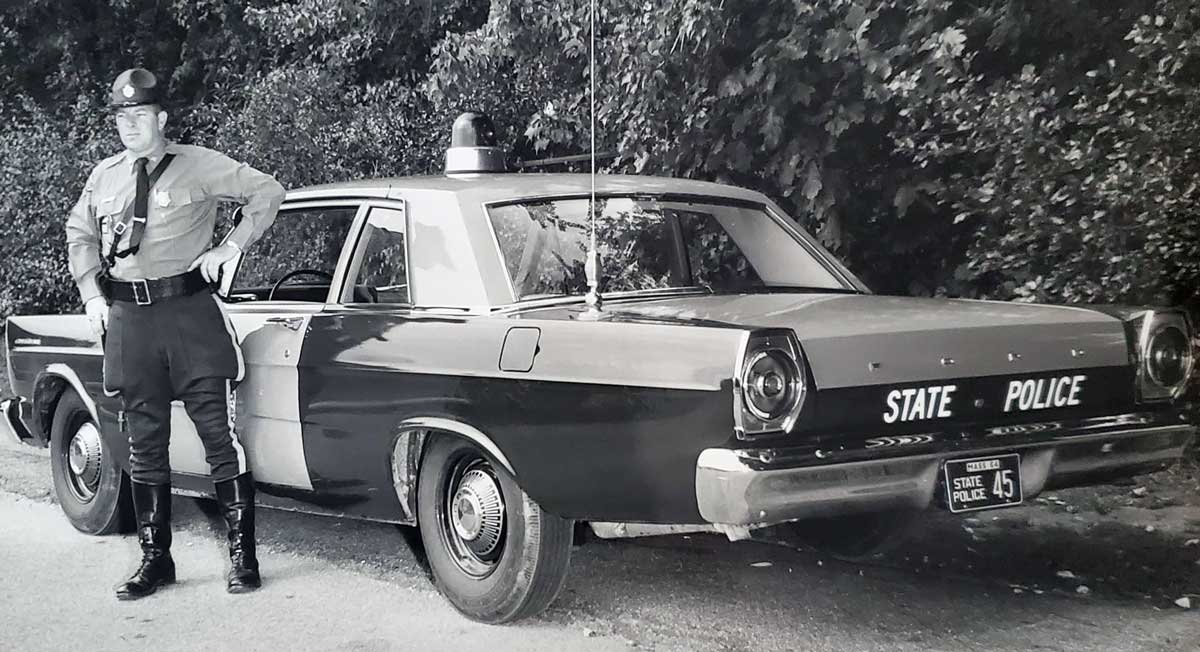 1965 MSP Ford displaying white over maroon 1964 MSP license plate.
1965 MSP Ford displaying white over maroon 1964 MSP license plate.
(Courtesy Nick Leary)
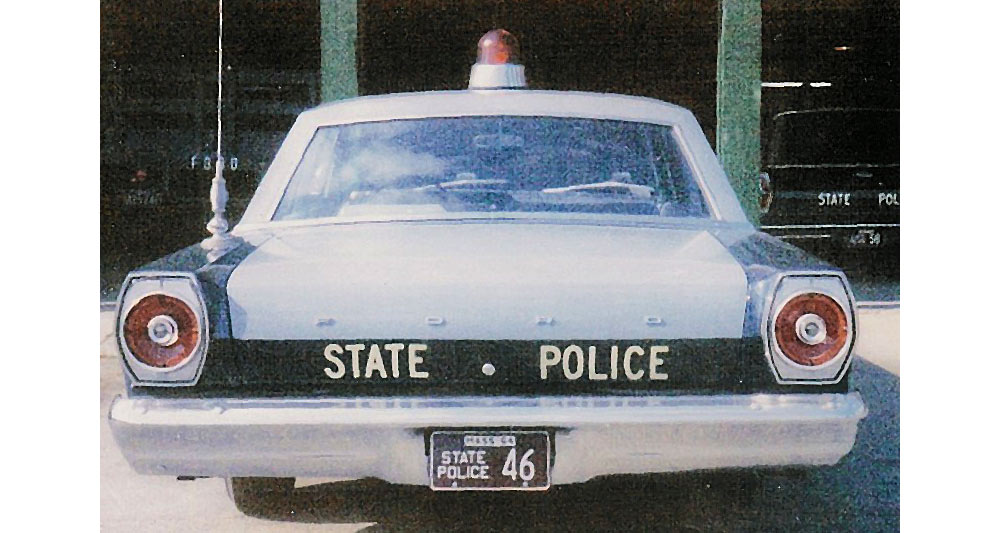 1965 MSP Ford displaying white over maroon 1964 MSP license plate.
1965 MSP Ford displaying white over maroon 1964 MSP license plate.
(Courtesy Bob Bricker)
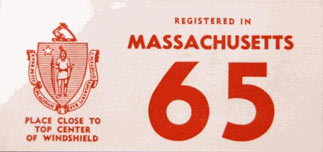 |
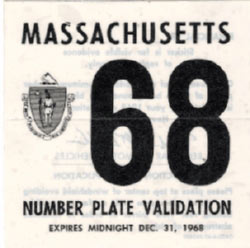 |
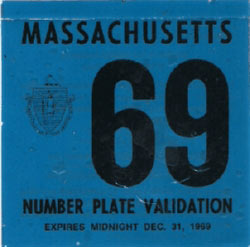 |
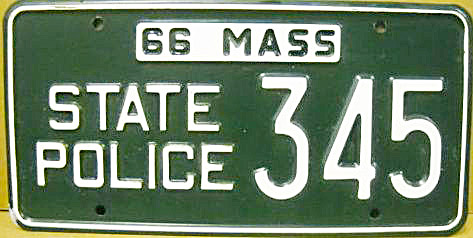 1966 issue. Embossed steel.
1966 issue. Embossed steel. 
In late 1966/early 1967, the Massachusetts State Police began issuing titled State Police license plates on embossed aluminum with blue characters over a reflective white background. The plate had an embossed border like the previous issue, but the state name was embossed in full at the top with no year appearing on the plate. The title STATE over POLICE still occupied the left center field of the plate followed by an embossed number up to 3 digits, but with no other features.
It is believed that these plates were used up until late 1970 when new titled MSP license were issued for the fleet.
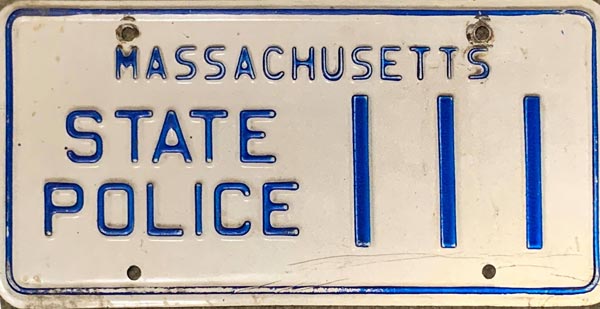 1967-1970 issue. Embossed aluminum.
1967-1970 issue. Embossed aluminum.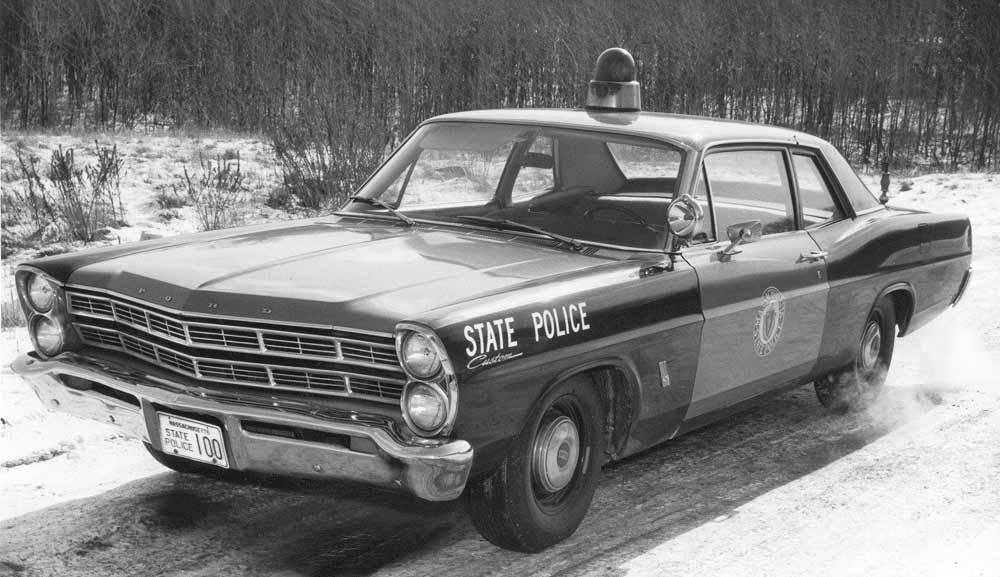 1967 MSP Ford displaying undated blue over reflective white MSP license plate number 100
1967 MSP Ford displaying undated blue over reflective white MSP license plate number 100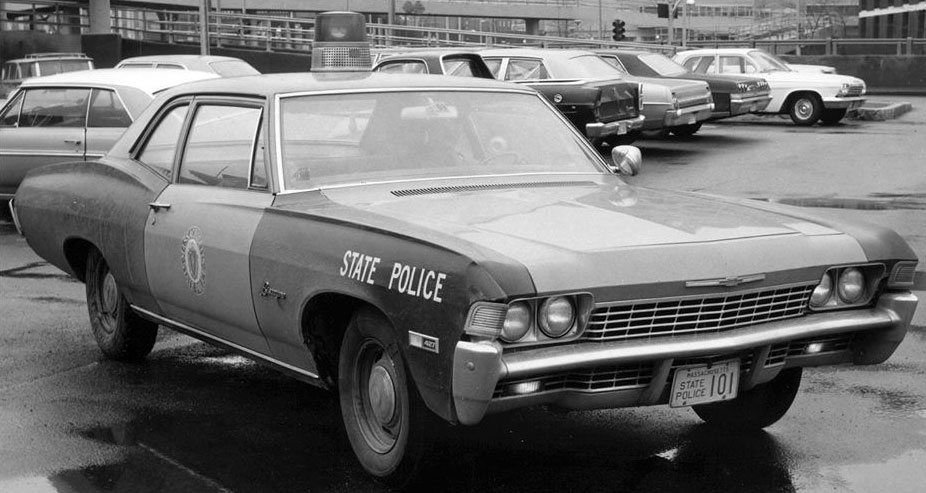 1968 MSP Chevy Biscayne displaying undated blue over reflective white MSP license plate.
1968 MSP Chevy Biscayne displaying undated blue over reflective white MSP license plate.
(Courtesy Bob Bricker)
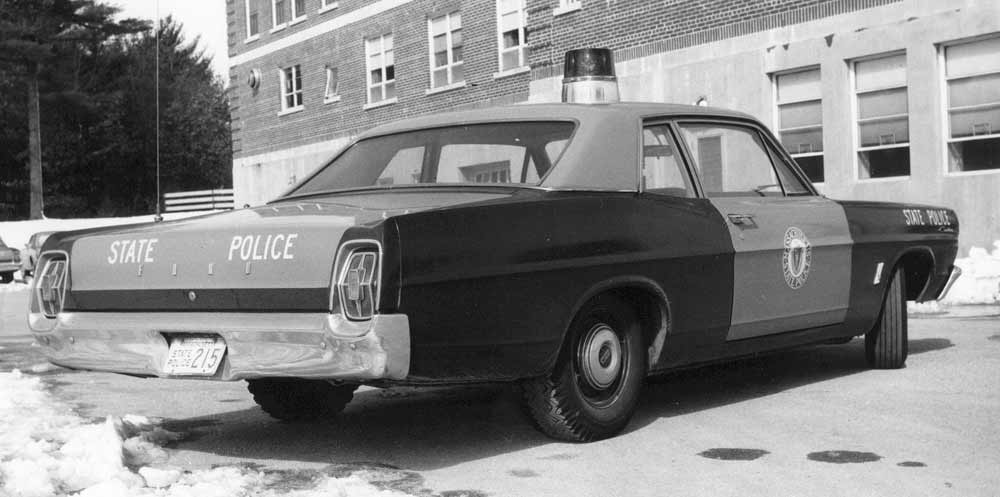 1967 MSP Ford displaying undated blue over reflective white MSP license plate.
1967 MSP Ford displaying undated blue over reflective white MSP license plate.
(Courtesy of Hervey P. Coté)
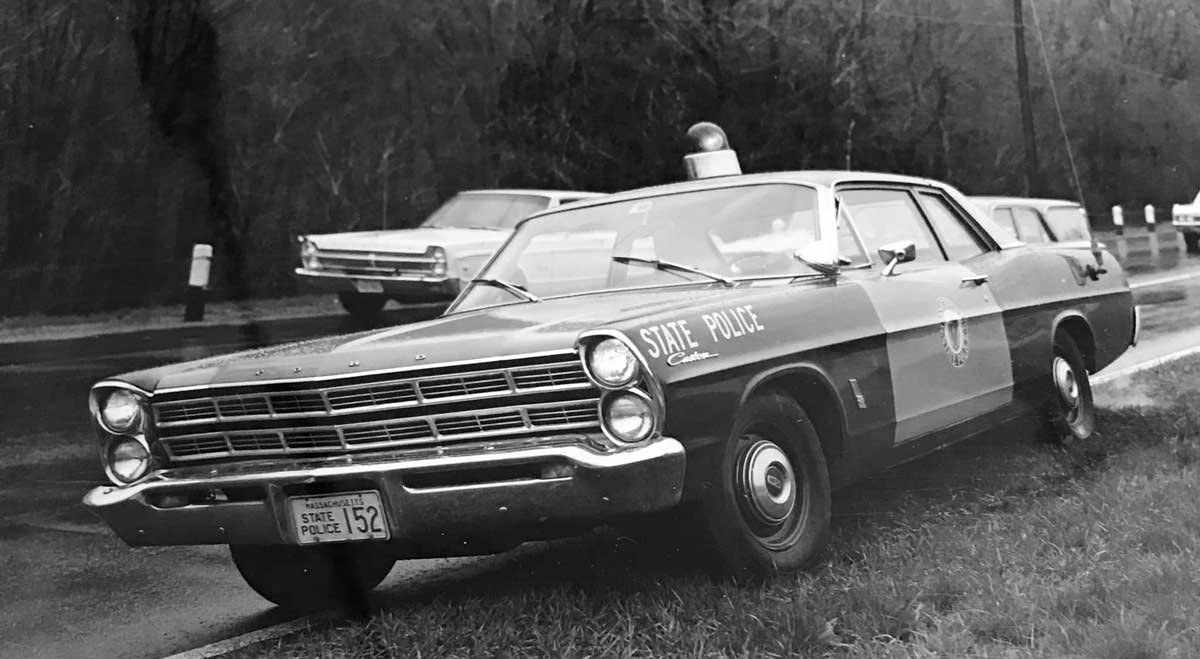 1967
1967
(Courtesy James Aitken)
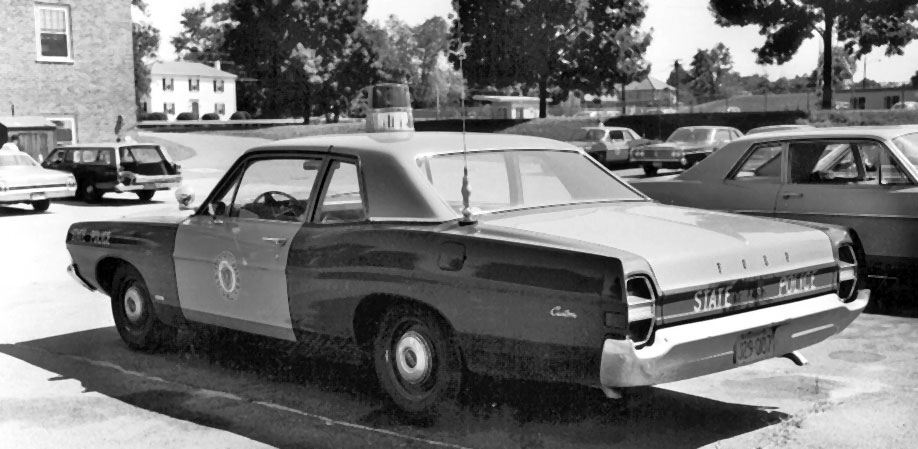 1968 Ford "Blue Bird" running passenger car license plate number J29-007-
1968 Ford "Blue Bird" running passenger car license plate number J29-007-
(Courtesy James Aitken)
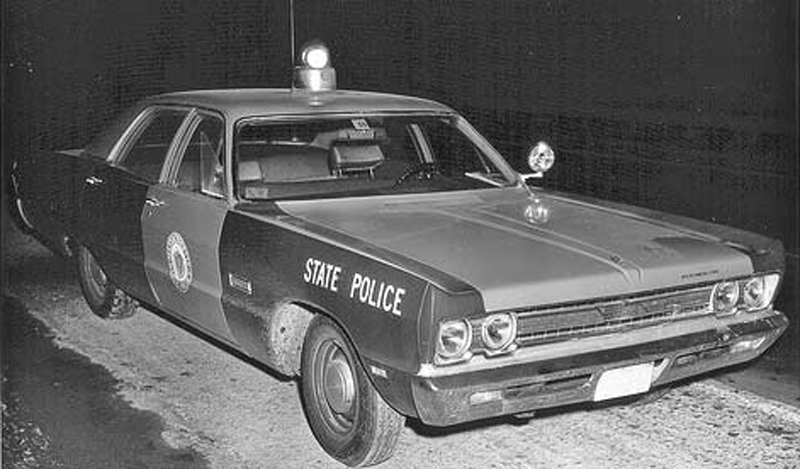 1969 MSP Plymouth
1969 MSP Plymouth
(Courtesy Hervey P. Coté)
1970 is believed to be the year that the Massachusetts State Police completely revamped their marked fleet license plate issuance. Once again, embossed aluminum license plates were used and were colored white over reflective medium blue. The plates had MASSACHUSETTS embossed along the top just below the upper mounting holes. STATE over POLICE still occupied the left center field of the plate, and the word OFFICIAL was embossed in the lower center of the plate just above the border.
The number up to 3 digits occupied the center right field of the plate as it had done since 1959, however the number for this issuance was an assignment number based on the Troop allocation. These troop allocations are outlined below the troop map.
License plate numbers from 1 to 199 were assigned to general headquarters in Framingham.
These license plates were validated for 1971 with a reflective white over red decal that was affixed in the upper right hand corner of the plate. The decals expired on December 31 of each year.
The decal had the state name inscribed at the top followed by DEC-71 over a white rectangle featuring a serial number in red preceded by the prefix No.
Decals for 1972 followed the same format, but were white over blue with DEC-72 over a white rectangle featuring a serial number in blue preceded by the prefix No.
Decals for 1973 followed the same format as well but were white over black with DEC-73 over a white rectangle featuring a serial number in black preceded by the prefix No.
These decals appear the most prominent on these MSP license plates as it was the last year this base was used.
The white paint used on the embossed portions of these plates proved to be easily compromised by the elements and repeated car washes.
Many are found with no paint left on the raised portions.
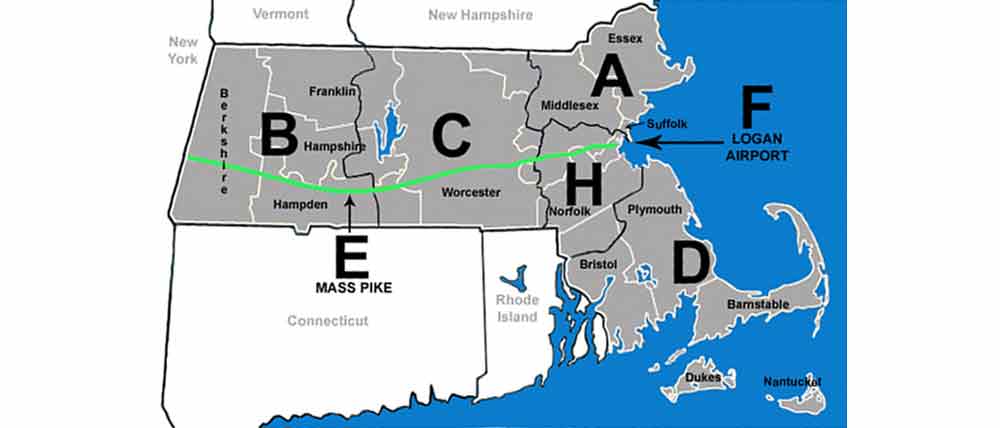 Current Troop Map. Troop H did not exist until 1992.
Current Troop Map. Troop H did not exist until 1992. Plates Numbered 200- 399:A-Troop HQ-Framingham
|
Plates Numbered 400-599:B-Troop HQ Northampton
|
Plates Numbered 600-799:C-Troop HQ-Holden
|
Plates Numbered 800-999:D-Troop HQ- Middleboro
|
Plates With Numbers and E-Troop (Massachusetts Turnpike) HQ-Boston
|
Plates With Numbers and Letter F Suffix:F-Troop(Logan International Airport) HQ Logan Airport Sub-station F-1 in same building. |
 1972
1972 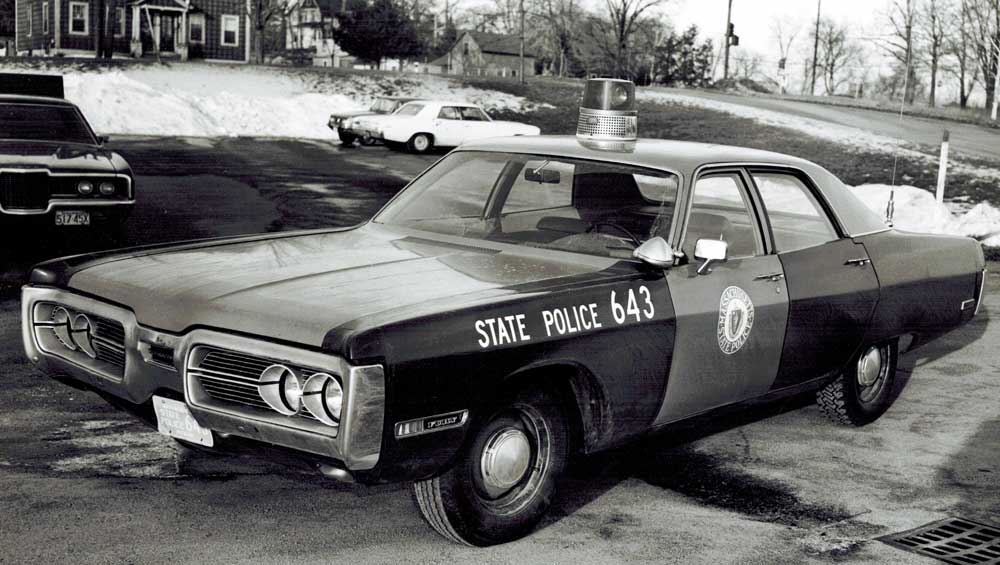 Car 643 (Holden HQ) photographed by Cpl. HC Scott in Leominster MA- February 14 1972.
Car 643 (Holden HQ) photographed by Cpl. HC Scott in Leominster MA- February 14 1972.
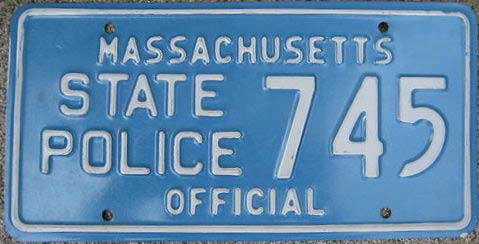 1970-1973 issue. Embossed aluminum. Troop C (HQ Holden)
1970-1973 issue. Embossed aluminum. Troop C (HQ Holden)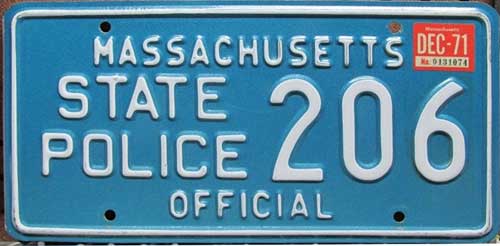 1970-1973 issue. 1971 decal.
1970-1973 issue. 1971 decal.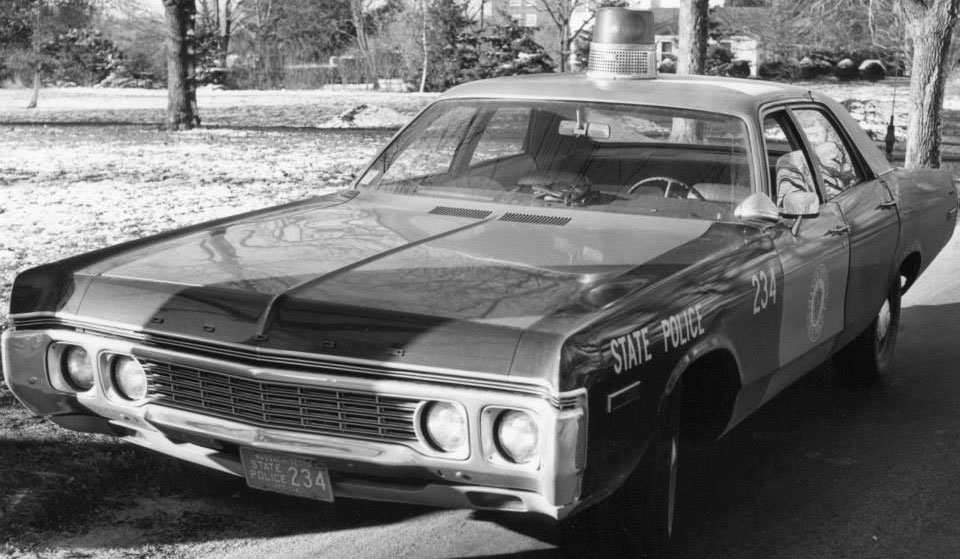 1972- Troop A. Car 234- Validation decal used on front plate.
1972- Troop A. Car 234- Validation decal used on front plate.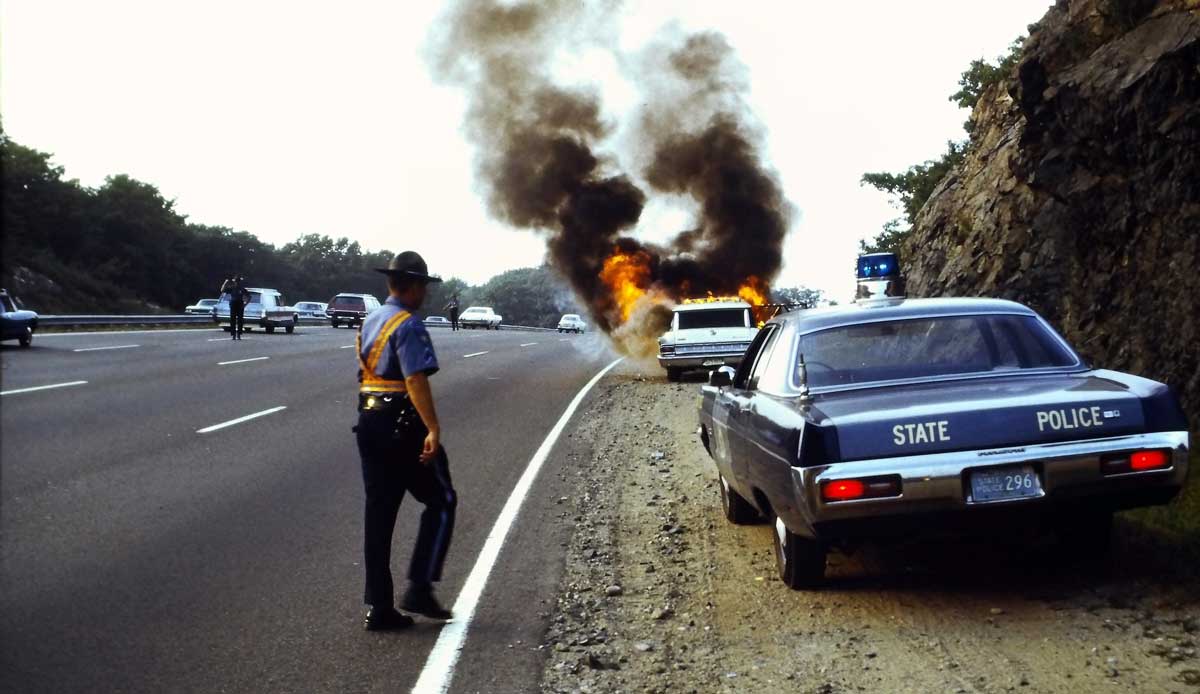 1972 Car 296
1972 Car 296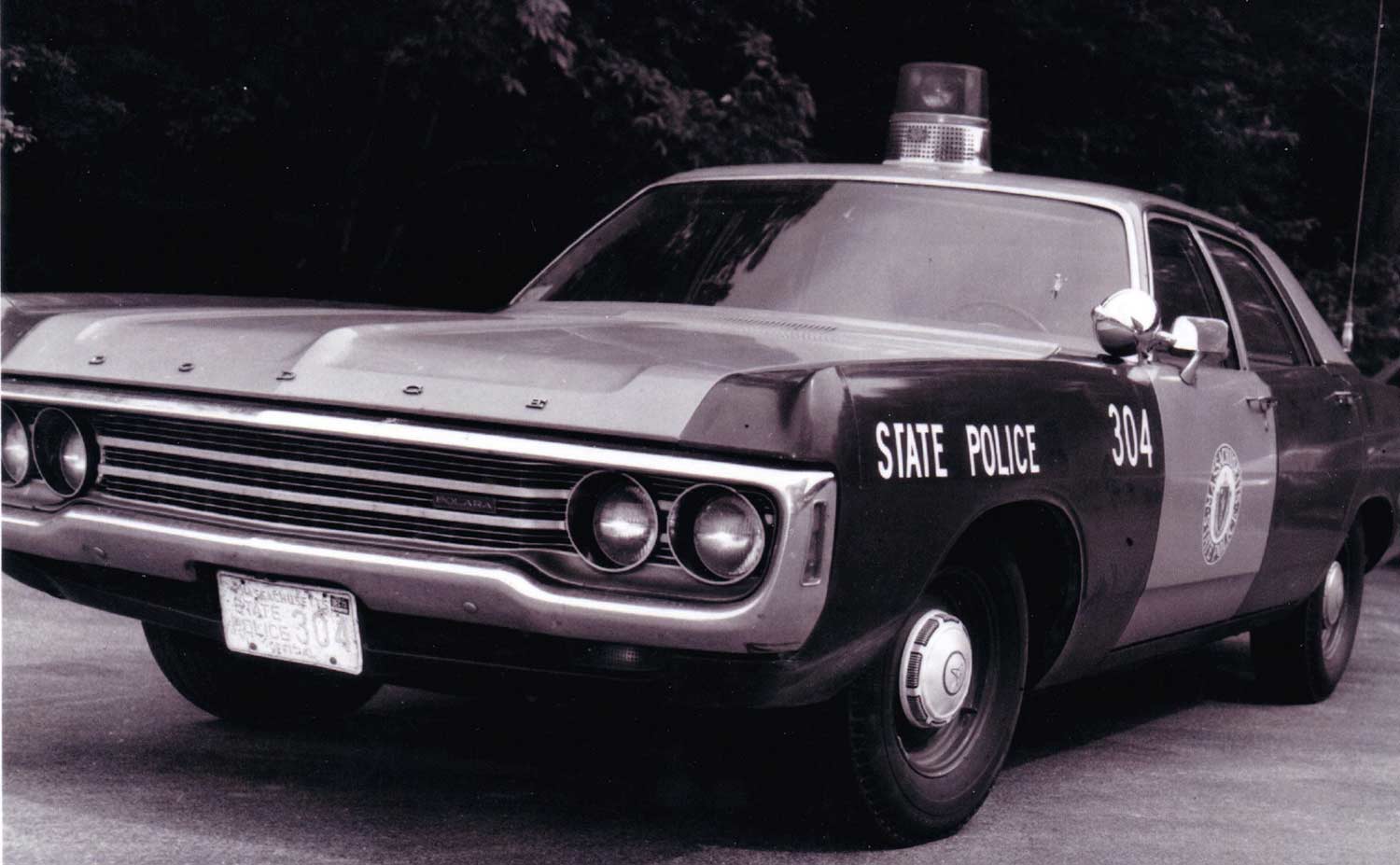 Circa 1972 Troop A. Car 304- Validation decal used on front plate.
Circa 1972 Troop A. Car 304- Validation decal used on front plate.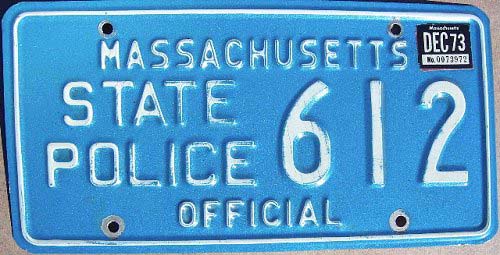 1970-1973 issue. 1973 decal.
1970-1973 issue. 1973 decal.
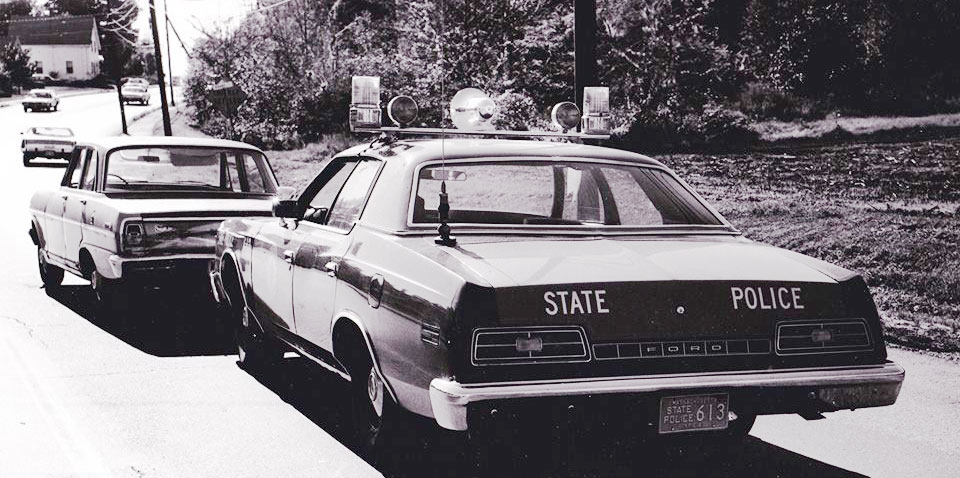 1973- Troop C car 613- Just one number off from plate seen above at left.
1973- Troop C car 613- Just one number off from plate seen above at left. 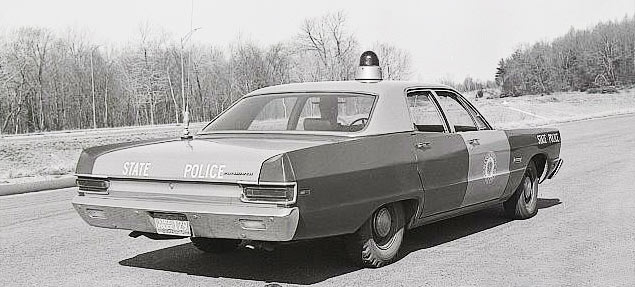 1973- Car 129-Headquarters (Framingham) (Courtesy of Massachusetts State Police Museum & Learning Center
1973- Car 129-Headquarters (Framingham) (Courtesy of Massachusetts State Police Museum & Learning Center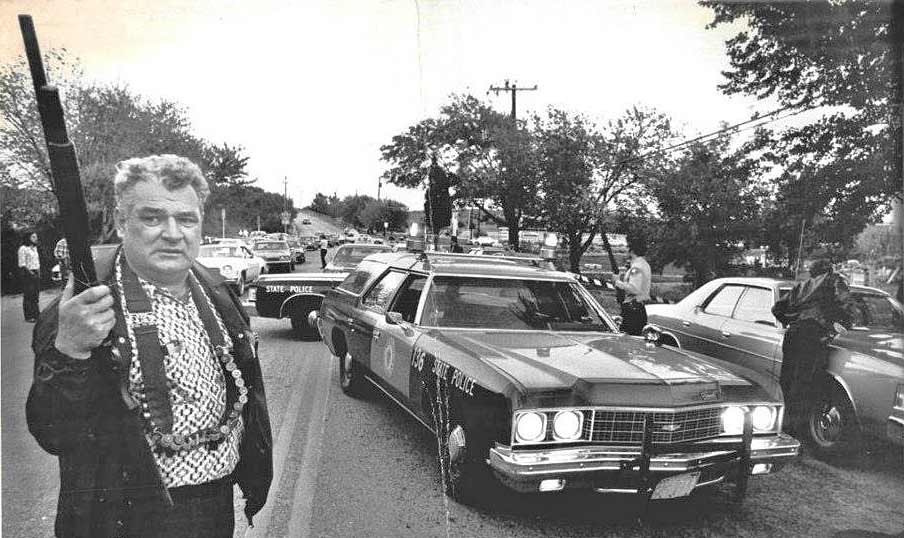 1974 Roadblock
1974 Roadblock In 1974, the Massachusetts State Police once again "re-plated" their marked fleet. The new plates were also embossed aluminum and were painted dark blue over reflective white. The same format as the 1970-1973 license plates were used, however the bottom title of OFFICIAL was replaced with the word VEHICLE embossed in the same location at the lower center of the plate.
The earlier versions of this plate had a reflective white background that yellowed as it aged. Newer versions employed a background that was brighter white.
These license plates were issued until approximately 1981 and still utilized Troop allocation numbers.
These license plates were also validated for 1975 with reflective white over red decals with DEC-75 expiry. This was the last time for validation decals to make an appearance on MSP license plates as someone within the organization finally must have realized the uselessness of placing expiry decals on permanent license plates.
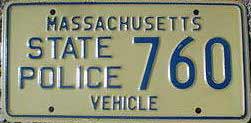 1974-1981 issue. Embossed aluminum.
1974-1981 issue. Embossed aluminum. 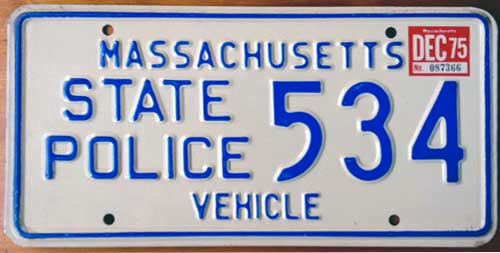 1974-1981 issue. Embossed aluminum.
1974-1981 issue. Embossed aluminum. 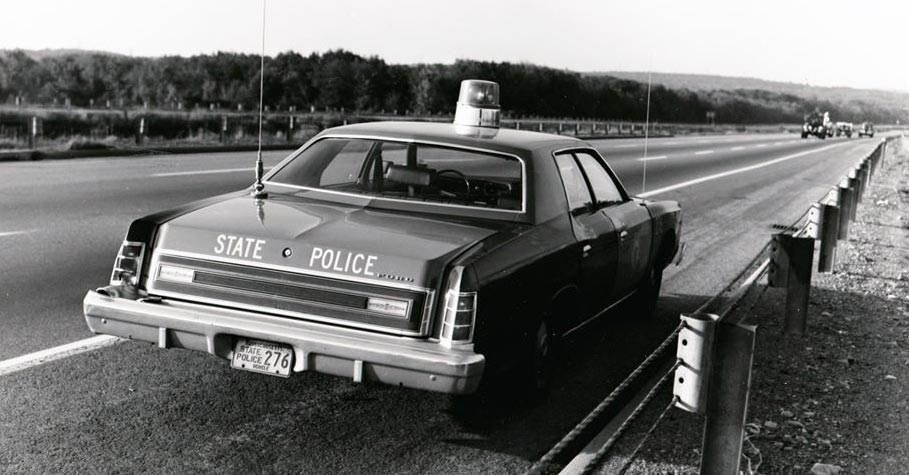 Troop A -Car 276
Troop A -Car 276 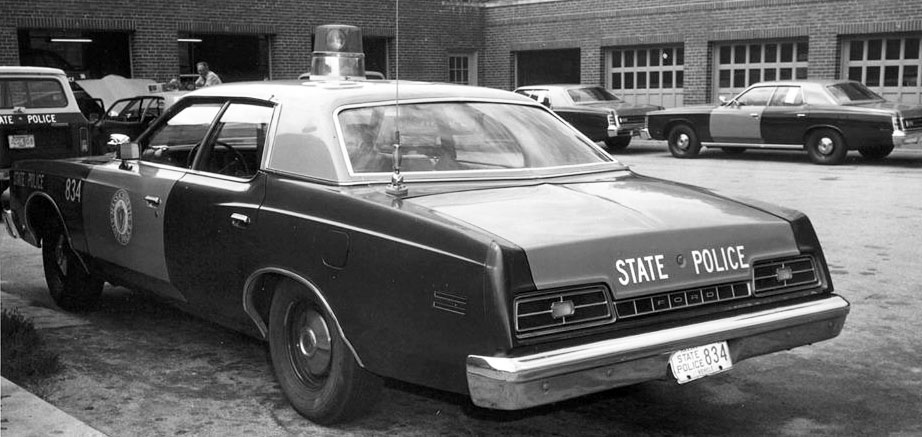 1975- Troop D HQ in Middleboro. Car 834
1975- Troop D HQ in Middleboro. Car 834 October 23 1977- Tpr Bob McKeon and Tpr Mike Crosby. Route 1 and Old Post Rd. Troop A.
October 23 1977- Tpr Bob McKeon and Tpr Mike Crosby. Route 1 and Old Post Rd. Troop A. 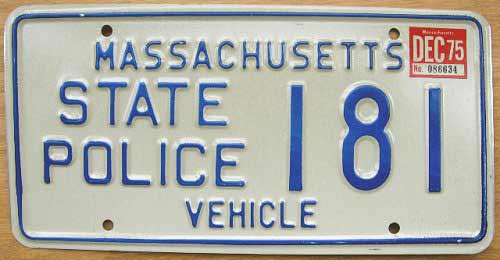 1974-1981 issue. Embossed aluminum.
1974-1981 issue. Embossed aluminum. 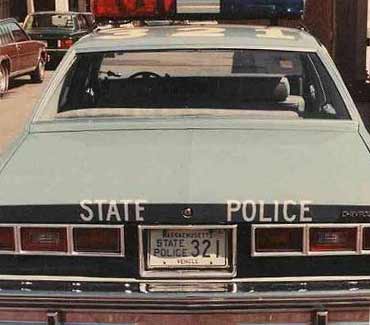 Troop A (HQ-Framingham)
Troop A (HQ-Framingham)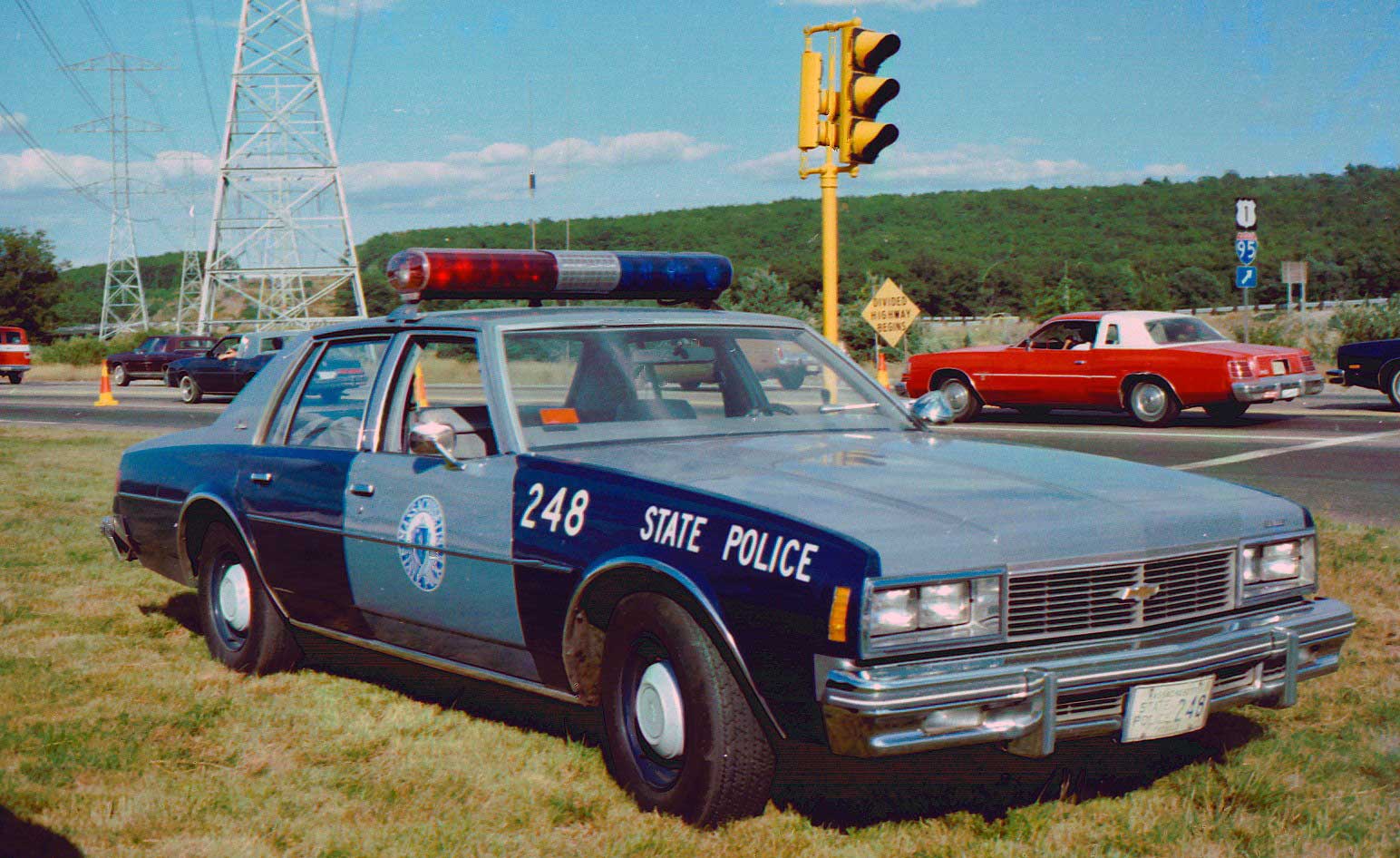 Troop A -Car 248.
Troop A -Car 248.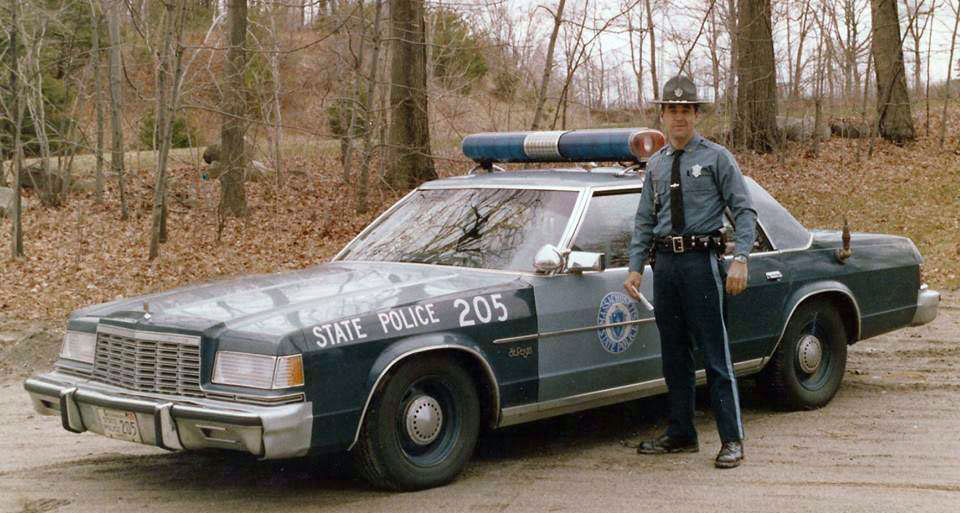 1980- Tpr Jim Jaworek. Front plate still had December 1975 validation decal affixed.
1980- Tpr Jim Jaworek. Front plate still had December 1975 validation decal affixed.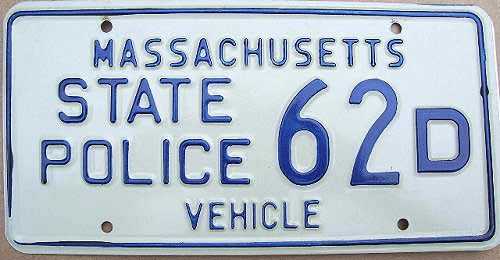 1974-1981 issue. Embossed aluminum.
1974-1981 issue. Embossed aluminum. 
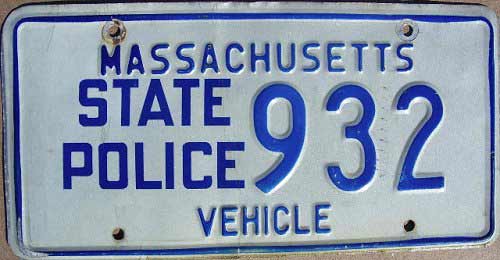 1974-1981 issue. Embossed aluminum.
1974-1981 issue. Embossed aluminum. 
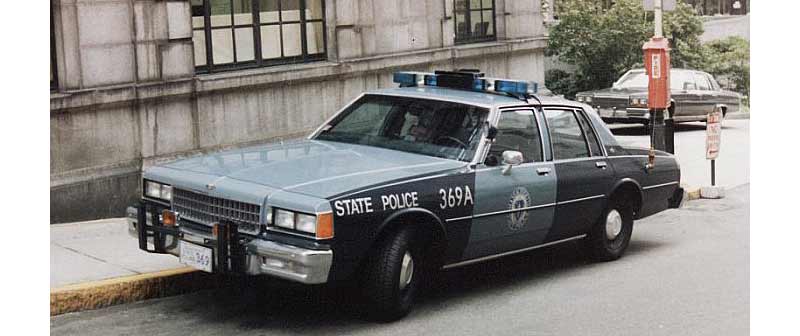
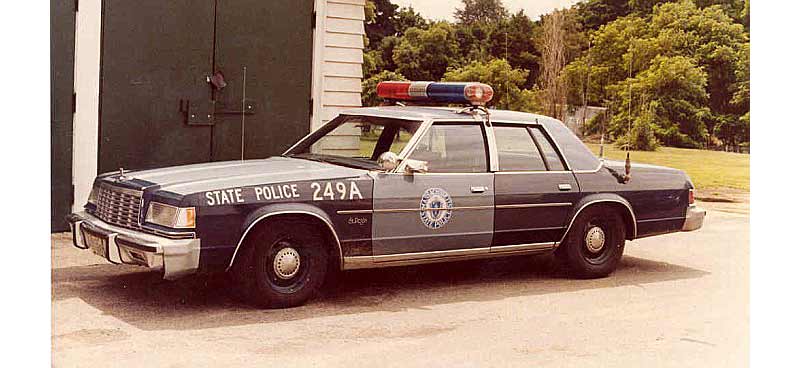 (Courtesy Bob Bricker)
(Courtesy Bob Bricker)In 1981, another replating of the MSP marked fleet took place. This time, the change was subtle. The same color and format used on the 1974-1981 issue was maintained, however the word VEHICLE was replaced with the word OFFICIAL just as was used on the 1970-1973 issue license plates.
The reflective white material used was of better quality and maintained its brightness better than the older issues. Some of the later ones incorporated circular holograms in the background sheeting showing the state silhouette and the last two digits of the year of manufacture ie: 86 for 1986.
The Troop allocation numbers continued until the size of the fleet increased more and more.
By the late 1980's the fleet numbers exceeded 1000. It was around that time that MSP license plate numbers were issued sequentially and with no Troop designation.
These license plates were issued and displayed on marked MSP fleet vehicles until 1989.
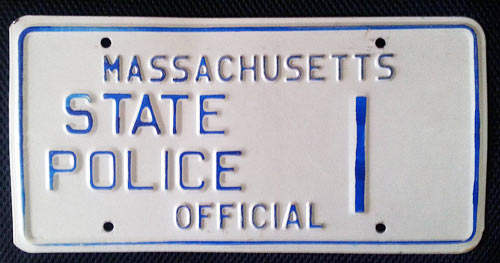 1981-1989 Superintendent's issue.
1981-1989 Superintendent's issue.
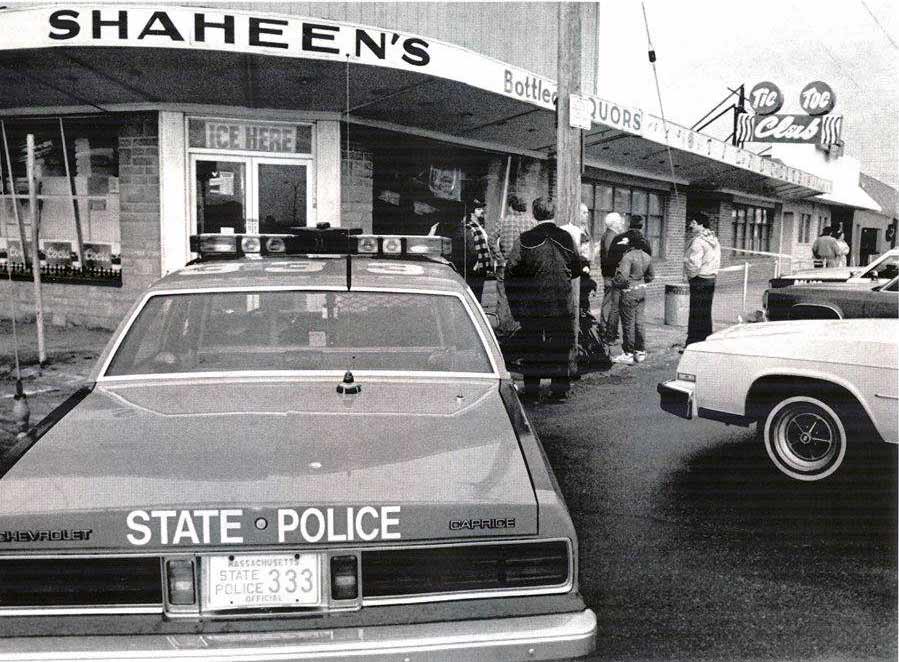 1986. Car 333
1986. Car 333 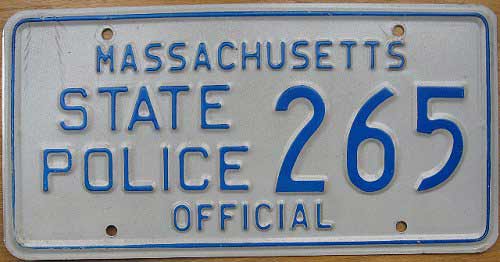 1981-1989 issue. Troop A (Framingham)
1981-1989 issue. Troop A (Framingham) 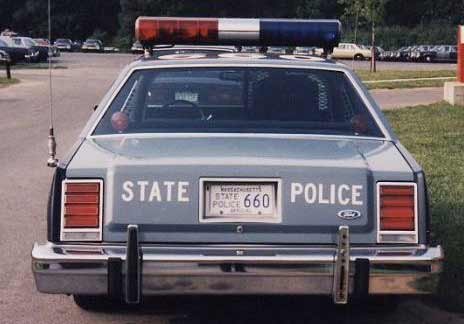 Troop C (HQ- Holden)
Troop C (HQ- Holden)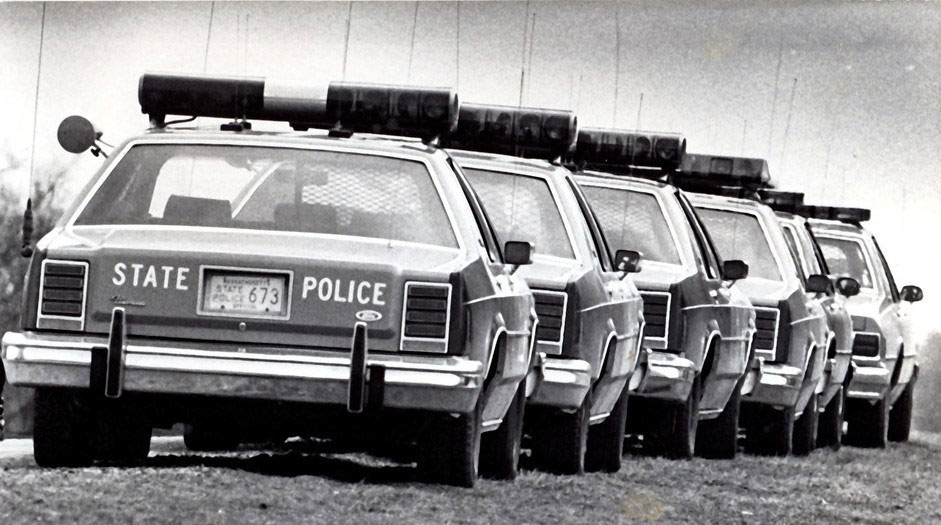 Troop C cars ready for deployment.
Troop C cars ready for deployment.Some people get into collecting license plates because they like the different styles and features that attract them to a familiar place and a familiar time. Some because they like old cars and motoring history. Then you have some, like our good friend Michael Crosby who started an interest in collecting license plates when his MSP license plate # 329 stood in the way of a bullet fired by a desperate criminal and terrorist who was trying to kill him during a shoot-out at a highway rest-stop in the early Winter hours of 1982.
Here's the fascinating story:
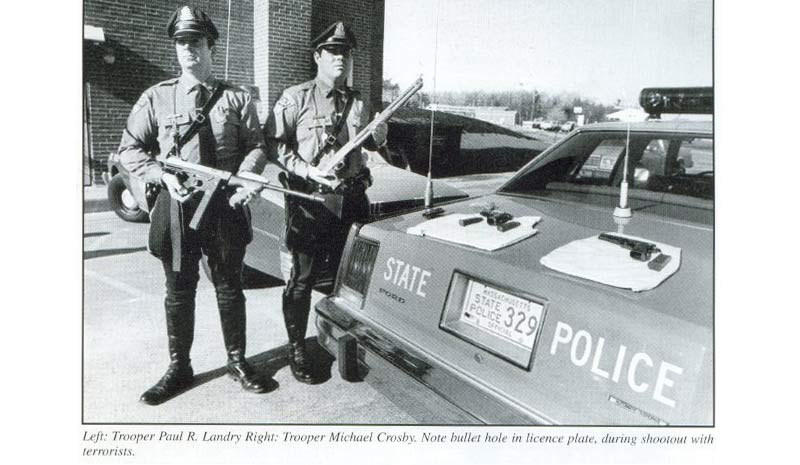
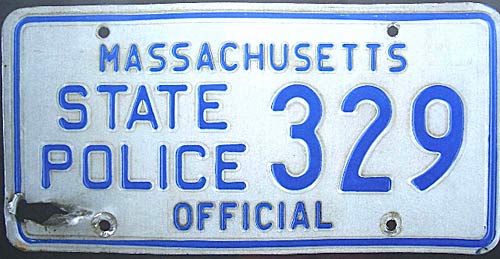 The license plate damaged by a bullet strike that was aimed at Trooper Michael Crosby during a February 7th 1982 shoot-out he had with domestic terrorists of the "Ohio 7".
The license plate damaged by a bullet strike that was aimed at Trooper Michael Crosby during a February 7th 1982 shoot-out he had with domestic terrorists of the "Ohio 7".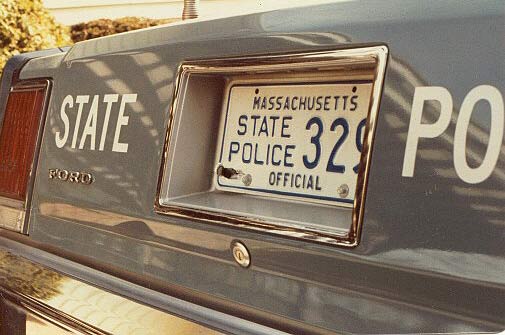 Proof how important cover is during such an incident.
Proof how important cover is during such an incident.Just before 2:00 AM on the night of February 7th 1982, a green station wagon is parked with its lights off at a rest-stop off I-95 in North Attleboro. Inside are two male occupants. MSP Trooper Paul Landry is on site and commences his observations on the vehicle and the men inside it.
Thirty-one year old Trooper Michael Crosby, a proud member of the Massachusetts State Police since 1975 was also on patrol in the area in his marked Ford Crown Victoria bearing license plate # 329. It wasn't long before the young trooper responded to a call for assistance from Trooper Landry who had observed one of the men in the green car conceal something under his coat.
Despite identification checks for the occupants coming back negative, there was still something "not right" with the actions and responses of these two men.
Tpr. Crosby aimed his spotlight into the car interior and both officers ordered the men out of the vehicle. Tpr. Landry pat-frisked the passenger in the area of his coat where he had seen something concealed earlier only to have his hands pushed-away by the jittery man. Tpr. Landry was of the belief that the man was wearing body armor. Tpr. Crosby covered the driver while Landry told the passenger to place his hands over his head and move no further. The man not only refuted these repeated demands, but pushed-away Landry and reached into his coat. Both Troopers drew their service revolvers and ordered the man to freeze. They recovered a 9 mm semi-automatic pistol from the man's waistband.
It was at this time when the focus was on the passenger's gun, that the driver of the station wagon bolted and took-up a position behind the car. The Troopers ordered the driver to come out with his hands up, but instead, the driver fired three shots at the officers. Tpr Landry pulled the passenger down to the ground, handcuffed him and returned fire at the driver. Tpr. Crosby realized that in order to call for back-up, he had to make it to the radio inside the patrol car. He made a mad dash across the parking lot and dove for cover behind a garbage dumpster, not before seeing the muzzle-flash of the driver's gun go off at him.
Crosby was able to finally get to the radio to call for much needed back-up while the driver was kept pinned-down by the two officers firing back at him. Troopers, local police, even units from nearby Rhode Island State Police converged upon the scene to render assistance.
The driver had escaped into some nearby woods and a search began in earnest.
The true identity of these two men eventually became discovered. They were domestic terrorists belonging to a criminal group known as the "Ohio 7", United Freedom Front and Sam Melville-Jackson Brigade. This group of anti-establishment bandits bombed banks, military and corporate facilities as well as nineteen courthouses in the U.S. northeast.
These were members of the same group who had murdered New Jersey State Police Trooper Phillip J. Lamonaco just 4 days before Christmas of 1981 along a stretch of Route 80 near the Delaware Water Gap. A search of the green station wagon discovered an array of drugs and a cache of more firearms and ammunition.
Once the dust had settled, Tpr Crosby observed a single bullet hole that tore through the bottom left corner of his rear license plate.
He was permitted by his superiors to keep the license plate as a memento of his lucky night where the bullet meant for him was caught by this tin rectangle instead. In the years that followed, Trooper Michael Crosby became Sergeant Michael Crosby and fostered an interest in license plate collecting. It was as a result of his hobby pursuits that the writer and "Mike" became fast friends.
How bittersweet is the irony that such a near-death experience so many miles away and so long ago, would have evolved into such a friendship that seems like family.
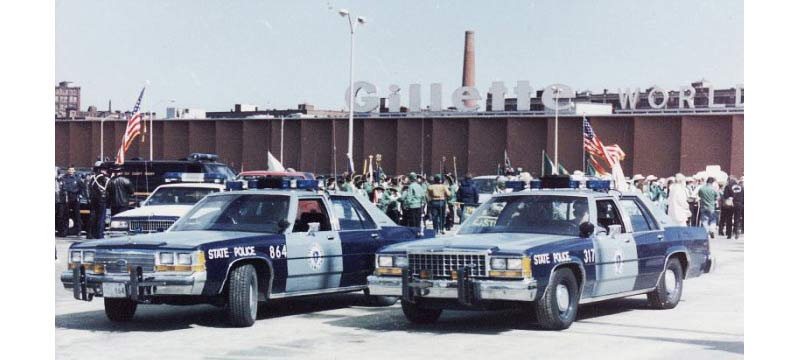
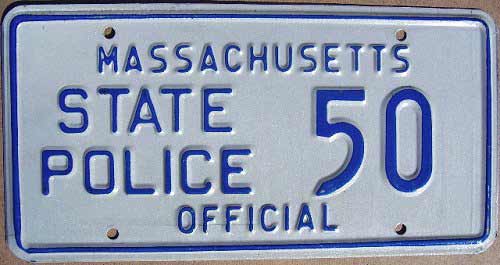 1981-1989 issue. Headquarters.
1981-1989 issue. Headquarters.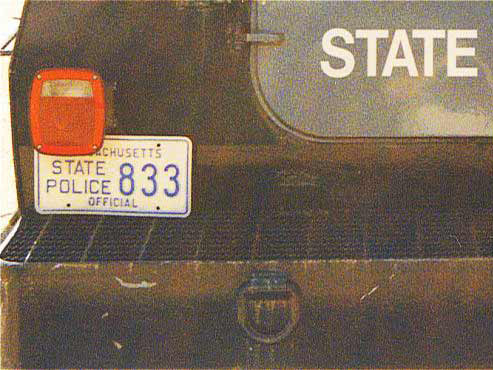
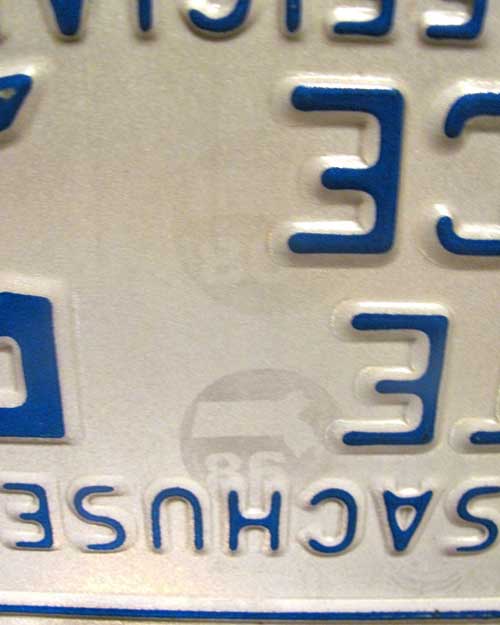 1986 holograms as seen in bachground sheeting (inverted)
1986 holograms as seen in bachground sheeting (inverted)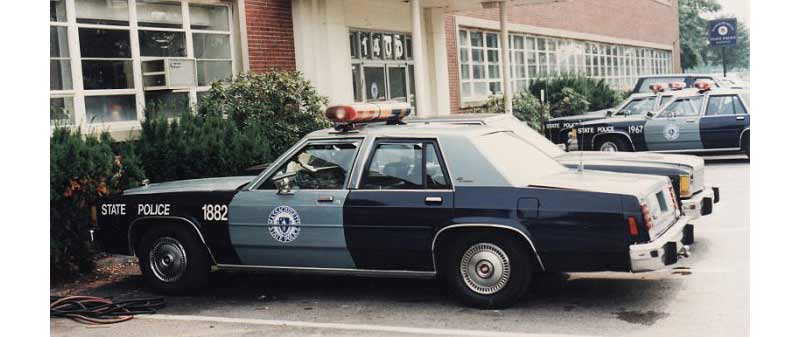
In January of 1989, the Massachusetts State Police unveiled a ground-breaking and revolutionary change in the design of their agency-specific license plates. Perhaps one of the most recognizable and distinctive designs for any state police or highway patrol agency at the time.
The design was based on an extension of the state's new "Spirit of America" graphic license plates that commenced issuance to Bay State motorists in early 1988. The plate was made of aluminum with a step-border. The background was reflective white with the state name spelled in full stylized navy blue font over embossed numerals up to four digits painted in red. The MSP "door seal" emblem occupied the center left field of the plate in blue silkscreen and the word "Official" was silkscreened in italic dark blue font at the bottom center of the plate.
What made this bold and attractive distinction that was showcased on every marked vehicle in the MSP fleet even more interesting, was the man behind the idea and the design: an MSP garage mechanic by the name of James Aitken.
Better known as Jim, Jimmy or "Ace".
 James G. Aitken
James G. AitkenJames had been employed as a mechanic by the MSP for almost 10 years by that time, and had always felt a deep pride and a true sense of belonging to this hallowed organization.
I had asked Jim about the origins of his idea and concept for the first MSP graphic license plate and figured that it would be best to leave it to his own words he had written to me:
"I remember back in early spring of 1987, I had been ordered on a tow job to pick up a cruiser that had broken down at then MSP Headquarters at 1010 Commonwealth Avenue in Boston.
The Headquarters garage/ yard had very little room for anything that resembled an out of service cruiser as it was the strict parking domain of the MSP upper brass. The cruiser had to go. As I was preparing the loading of the cruiser on the MSP ramp truck for transport back to then A-troop Framingham, I saw a white cruiser parked on the sidewalk just outside the gate of HQ 1010. It was a RMV (Registry of Motor Vehicles) police cruiser. I noted that it had a new type of plate I had never seen up until that point in time. The plate had the RMV police arm patch logo on it as well as the cruiser number. As I drove back to SP Framingham, I thought that the MSP should have license plates of this kind too. So with a lot of selfishness to the MSP, I didn't want the RMV police to have a better plate than the MSP.
When I got back to Fleet Framingham, I started to cut and paste hand-cut MSP logos I found around the office. Not having computers back then, it took a lot of scotch tape and forgotten numbers of trips to the Fleet section photo copier to come up with a few good looking designs.
Once I had some designs I liked, I presented my thoughts, reasonings and designs to the Fleet Section commanding officer (then) Lt. Walter Pomerleau who was Fleet Administrator from October 1985 to May 1989.
He can not recall the exact date I came to him about my idea for a plate change but agreed it was around early part of 1989. Walter said by my forethought of a new plate and with coincidence, it fit perfectly as the MSP saw a need to add a fourth digit to the plate. The fleet was growing and would need this four number plate down the road. Lt. Pomerleau wrote a letter to the commissioner of Public Safety, Frank J. Trabucco around the early part of 1989, about the need for a plate change. Trabucco then gave his blessings and contacted the registrar of Motor Vehicles which put the change into motion.
The new MSP plate run was ordered from the RMV main office on Nashua Street Boston.
Once the plate run was complete, I and a Trooper from Fleet went to Nashua Street and picked the plates up. The plate change took place as the cruisers came in for work or as the new cruisers were set up for service with the MSP.
In a nutshell, I thought the MSP should have a plate just as nice or even better than the RMV police. Jealousy on my part all the way. The MSP brass gave me plate number one for my trouble."
These novel and attractive new plates began to be assigned to the remainder of the MSP fleet by January 15 of 1989 beginning with Troop E and Troop F cars. As Jim had stated, these plates were deployed during service and replacement rotations.
Originally, these plates were run rear-only with the spare plate kept in storage at the MSP garage in Framingham. By the Summer of 1989 the MSP Commissioner ordered that MSP license plates were to be run front and rear. It was also deemed in these earliest days of this issue that plates numbered from 200 thru 999 were to be assigned to line cars, and numbers 1000 and up were to be used on unmarked and non-patrol vehicles. Ten # 1 license plates were made for dignitaries.
Most of these early issues have circular holograms in the background sheeting running down the center of the plate showing the state silhouette with 88 indicating the year of manufacture.
Numeral positioning on the plate varies, and some numerals begin with a lead zero while most others do not.
These plates were issued with sequential numbers with no particular Troop allocation and were issued until 2007.
James Aitken retired from the Massachusetts State Police on 2015 after 36 years of dedicated service to the French & Electric Blue. He began his career in 1979 at CHQ Holden and moved to the brand new Fleet Section in Framingham in 1980.
He spent his last nine years as Senior Mechanic and was Foreman of the Fleet for the last three.
The MSP and this hobby owes Jim a great deal of gratitude and recognition for playing such a pivotal role in providing one of the most distinctive and ubiquitous identifiers in the moving history of the oldest state police agency in the United States of America.
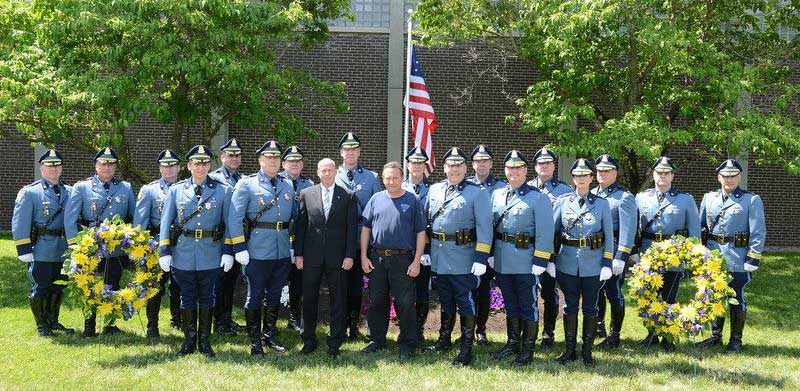 Command Staff's respects paid to James Aitken after 36 years of dedicated service to the Massachusetts State Police.
Command Staff's respects paid to James Aitken after 36 years of dedicated service to the Massachusetts State Police.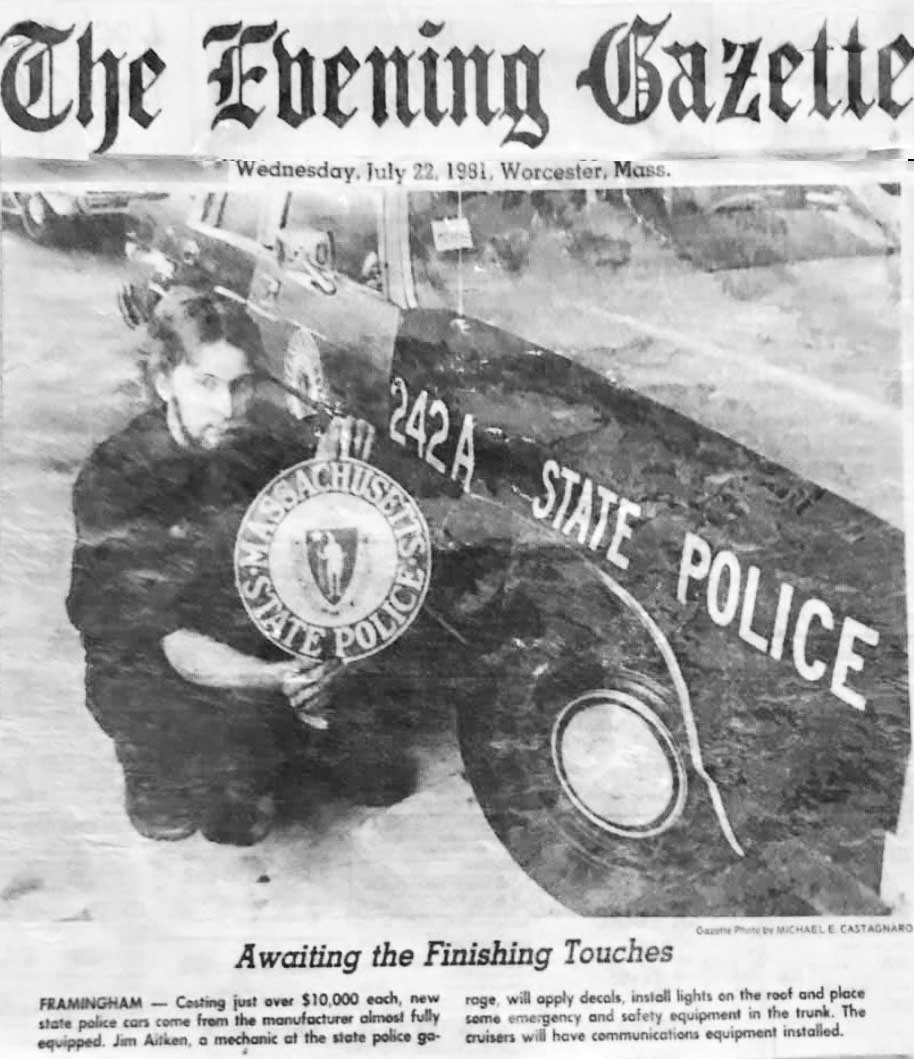 1981 news article featuring our superior contributor, Jim Aitken !
1981 news article featuring our superior contributor, Jim Aitken !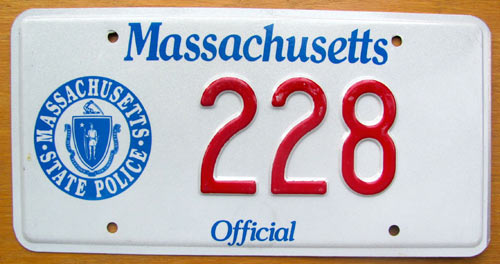 1989-2007 issue.
1989-2007 issue. 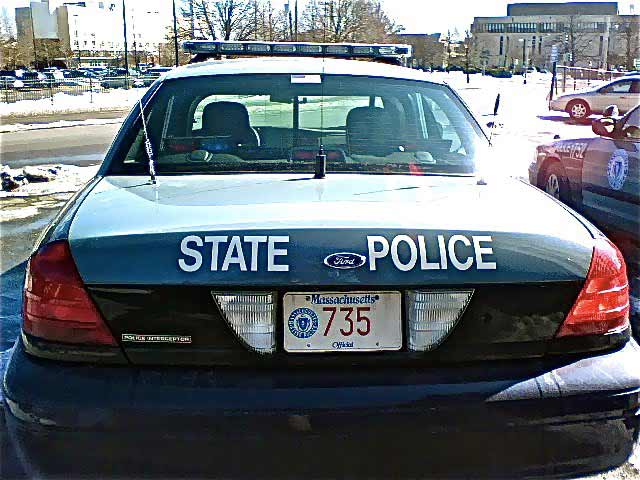
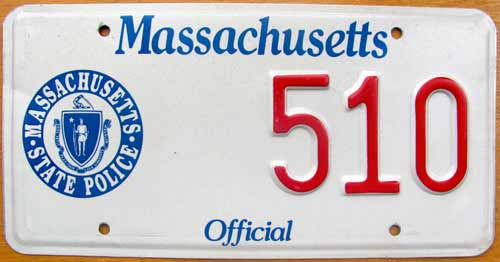 1989-2007 issue.
1989-2007 issue. 
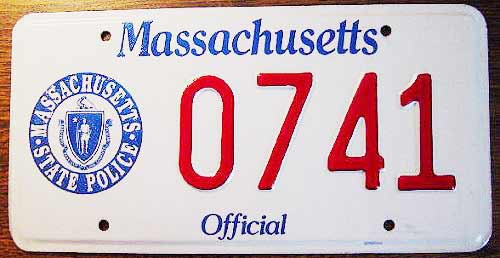 1989-2007 issue.
1989-2007 issue. 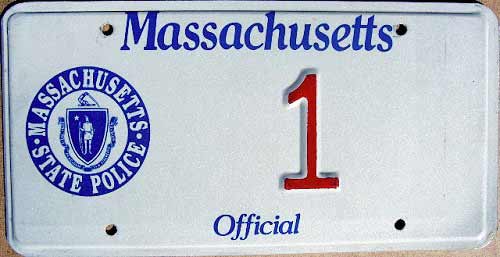 1989-2007 issue. Number 1. One of ten such number 1 plates issued as a presentation keepsake for officials of the Registry of Motor Vehicles and other dignitaries associated to the state police.
1989-2007 issue. Number 1. One of ten such number 1 plates issued as a presentation keepsake for officials of the Registry of Motor Vehicles and other dignitaries associated to the state police.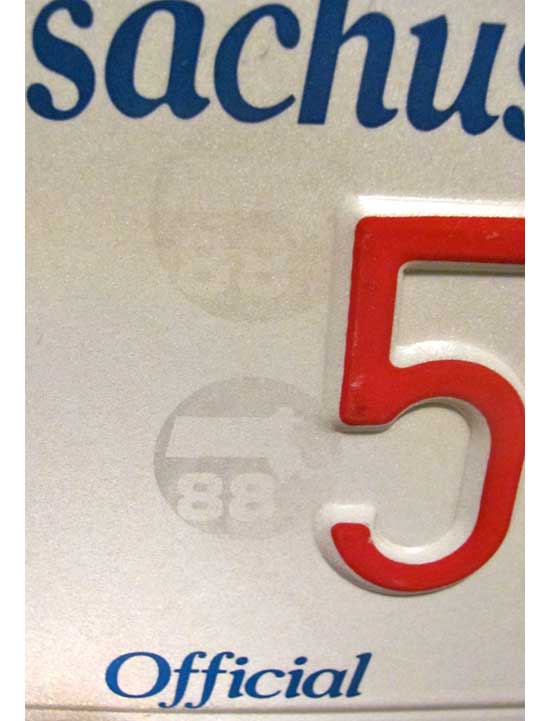 1988 holograms as seen in background sheeting from initial run of new base in January of 1989.
1988 holograms as seen in background sheeting from initial run of new base in January of 1989.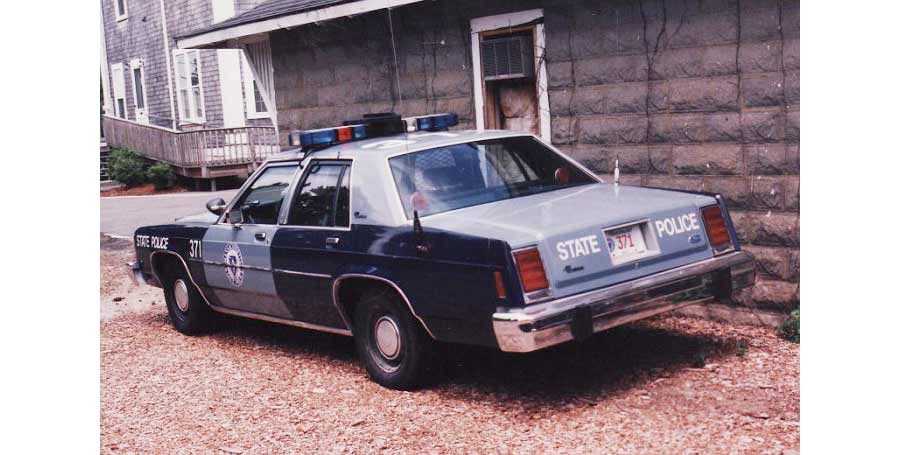
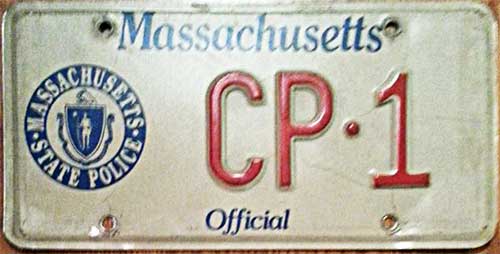 1989-2007 Command Post issue.
1989-2007 Command Post issue.
 1989-2007 Command Post issue.
1989-2007 Command Post issue.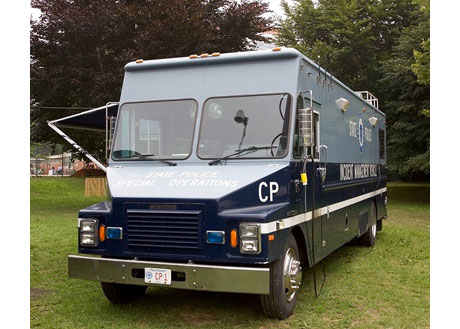
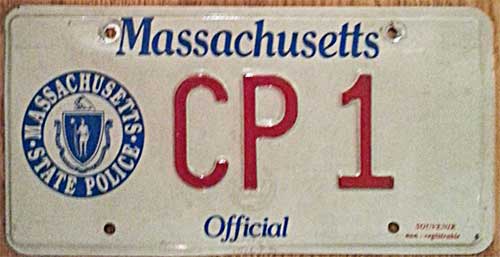 1989-2007 Command Post issue. Later version. No separator.
1989-2007 Command Post issue. Later version. No separator.
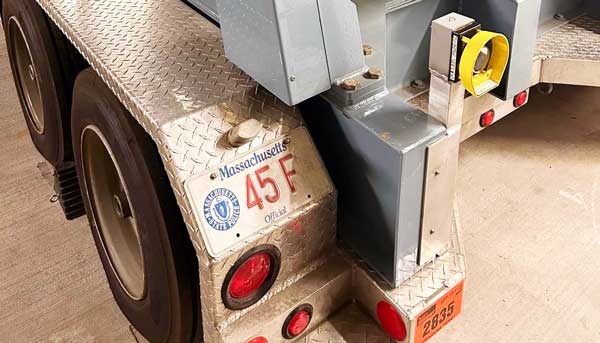 Troop F (Logan Airport) bomb trailer.
Troop F (Logan Airport) bomb trailer.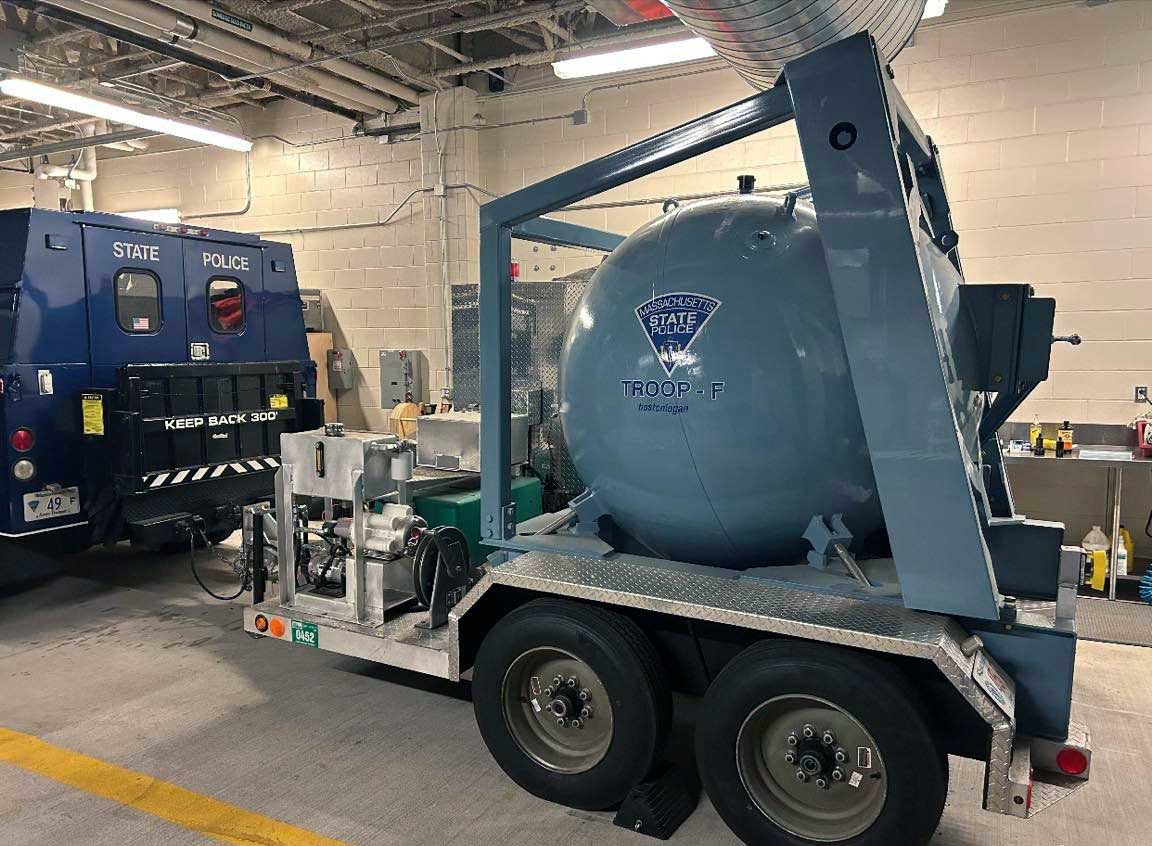 The Bomb Ball
The Bomb Ball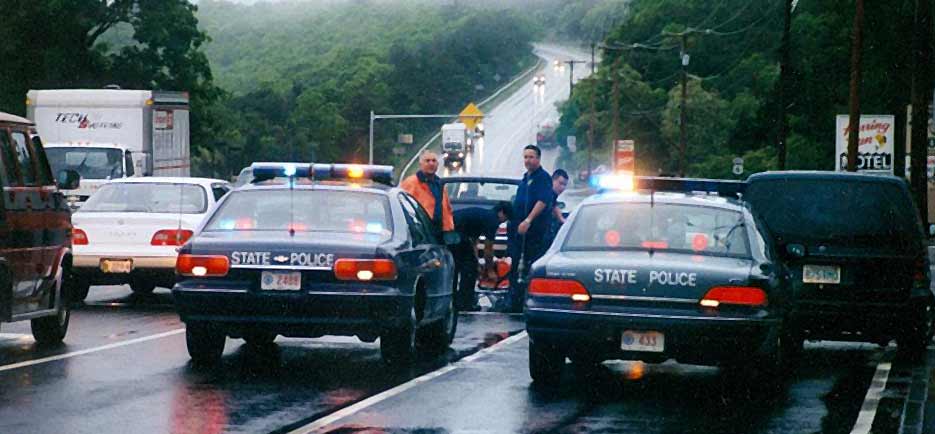 (Courtesy Tom Constantine)
(Courtesy Tom Constantine) 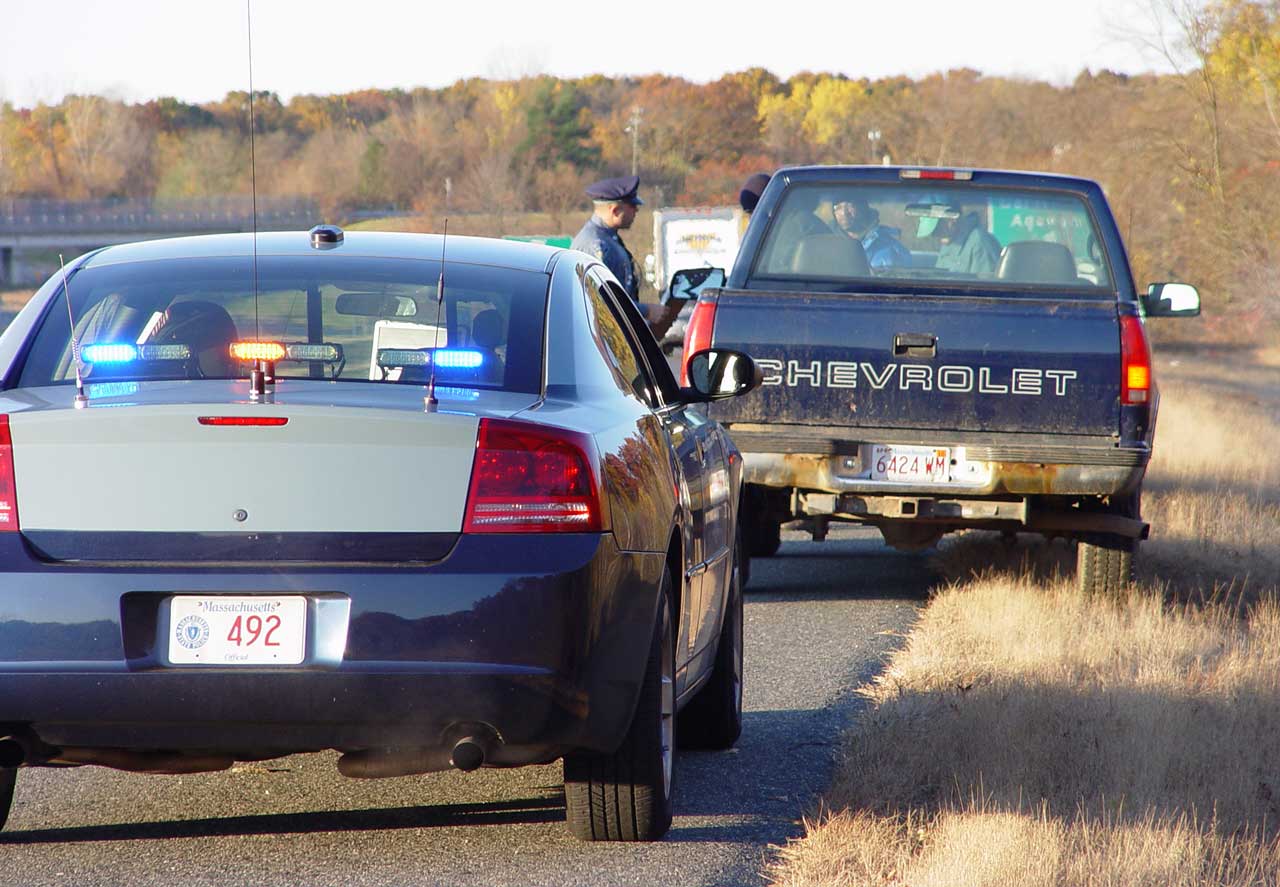 Clean-roof Mopar
Clean-roof Mopar In late 2006, the MSP had released an image of a new license plate design for use beyond 2016. The new license plate began issuance to marked vehicles in the MSP fleet by early 2007. The new design was once again a reflective white embossed aluminum plate with a step-border. The use of the stylized dark blue MASSACHUSETTS used on the previous issue continued. The door seal emblem was replaced with the shoulder patch emblem, and the title "State Trooper" was inscribed with the same color and font as the state name on the bottom center of the plate. A small flag of the USA occupied the top right corner of the plate and the numerals up to four digits was painted in medium blue.
These plates were issued with sequential numbers with no particular Troop allocation and are still being issued as of this writing.
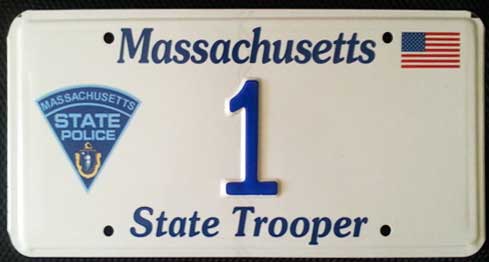 2007-Current Superintendent's issue.
2007-Current Superintendent's issue.
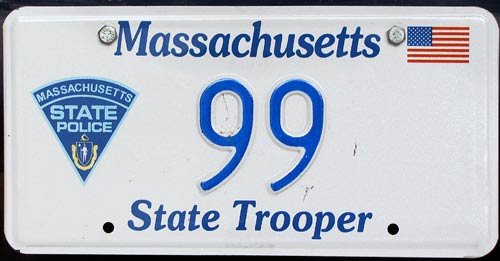 2007-Current issue.
2007-Current issue. 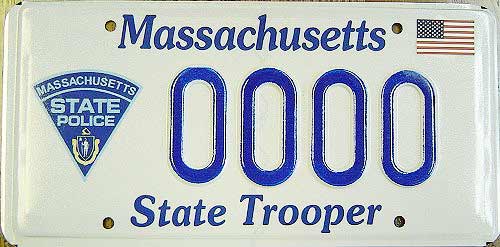 2007-Current issue. Sample.
2007-Current issue. Sample.
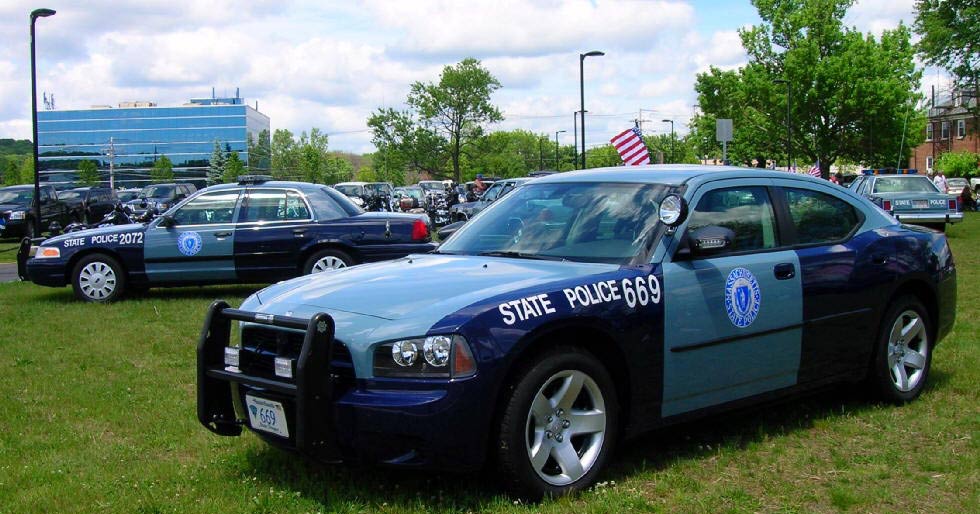
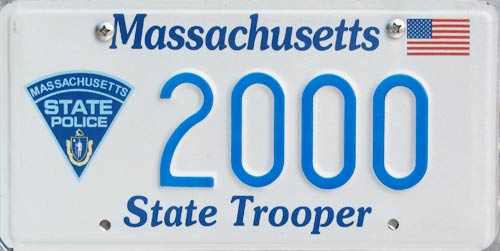 2007-Current issue.
2007-Current issue.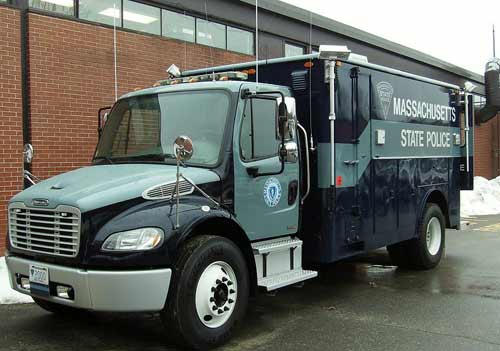 Vehicle assigned # 2000
Vehicle assigned # 2000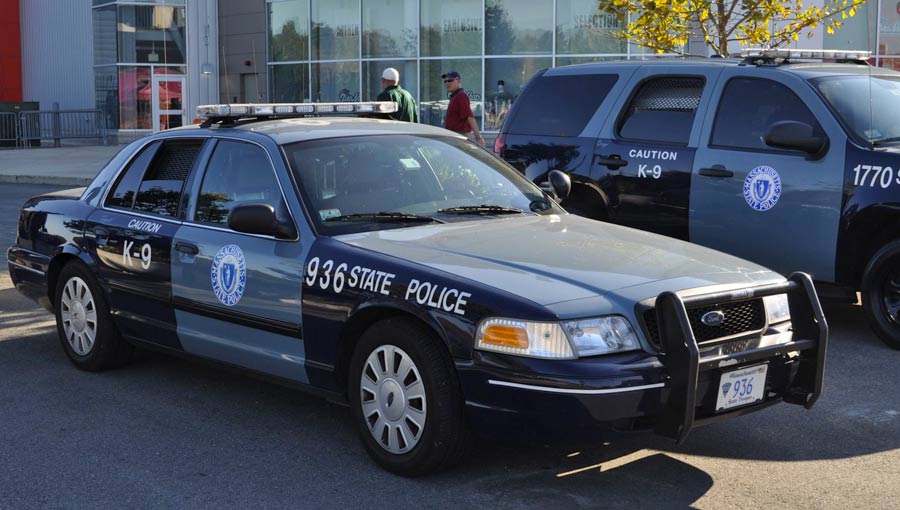

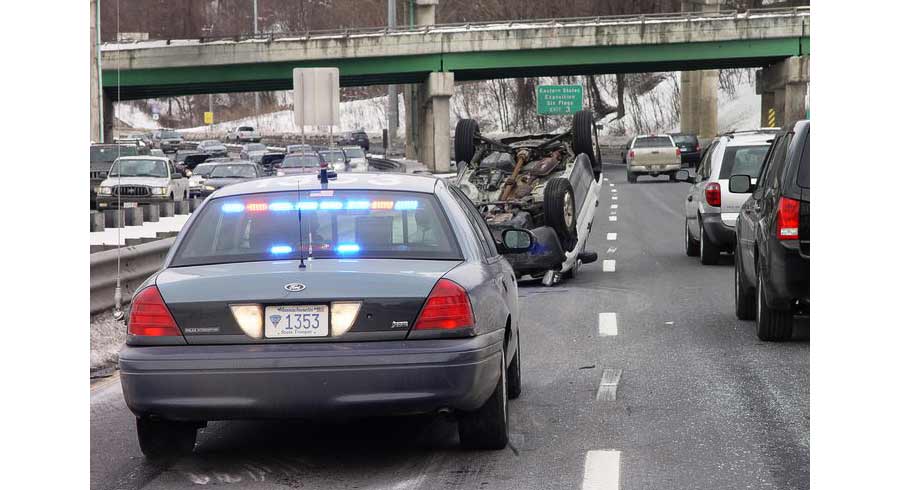 blabla drunk
blabla drunk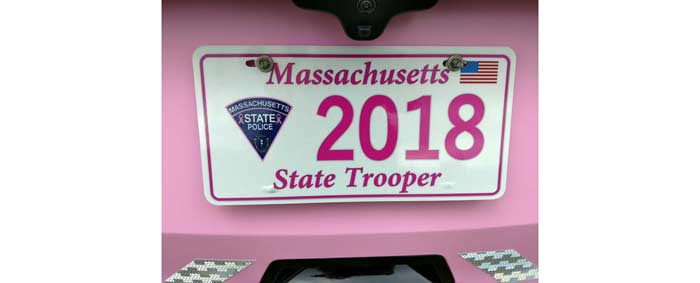 Special "all-screened" issue for Pink Ribbon Campaign against breast cancer 2018.
Special "all-screened" issue for Pink Ribbon Campaign against breast cancer 2018.
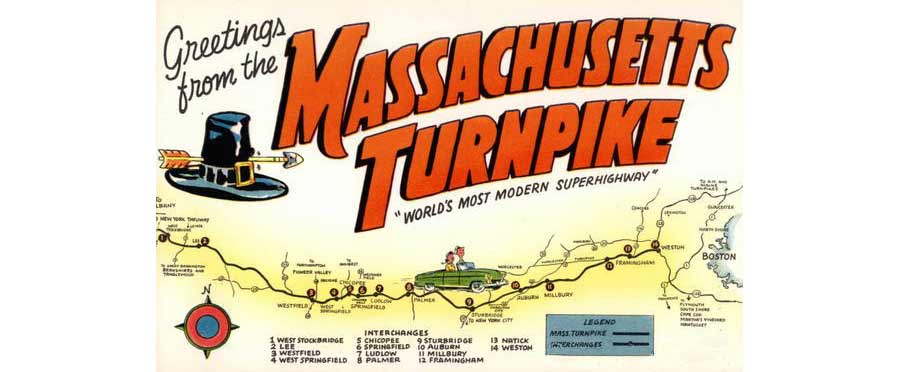
On May 15th 1957, the Massachusetts Turnpike was opened for cross-state highway traffic from West Stockbridge in the western part of the state to Weston on the distant outskirts of Boston. The Massachusetts State Police was contracted to perform patrol and enforcement duties on the new Turnpike, however in patrol vehicles owned and operated by the Turnpike Authority.
These earliest patrol vehicles were Chrysler station wagons with 440 ci engines and painted in Kelly green and white. The vehicles were outfitted with a variety of equipment to assist motorists on the new highway, including a stretcher to transport the sick and injured to local hospitals. These green and white Chrysler wagons displayed standard Massachusetts passenger license plates and were operated by MSP Troopers until 1970. Beginning around 1968, the Chryslers were ordered painted in the French & Electric blue of the MSP and Ford sedans began to be added to the fleet. These patrol vehicles used red emergency lights to the front and rear.
The transition to Troop E will be outlined further down in the chronology.
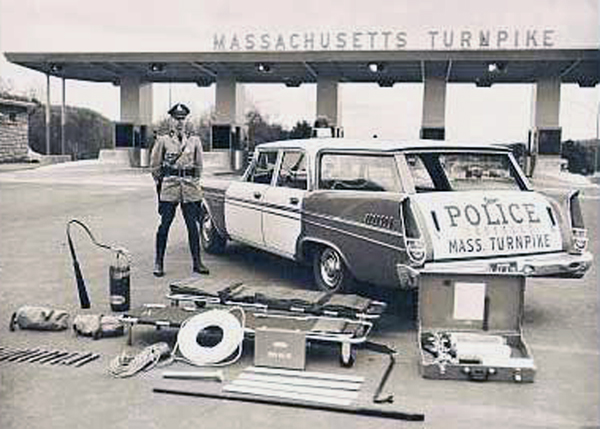 (Courtesy Hervey P. Coté)
(Courtesy Hervey P. Coté)
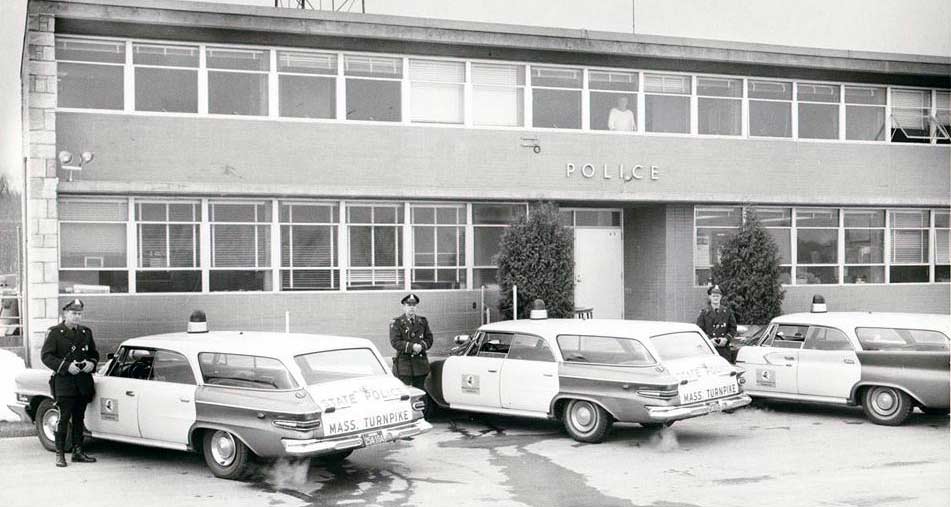 1962 Turnpike Troopers.
1962 Turnpike Troopers.
(Courtesy Mike Slepetz)
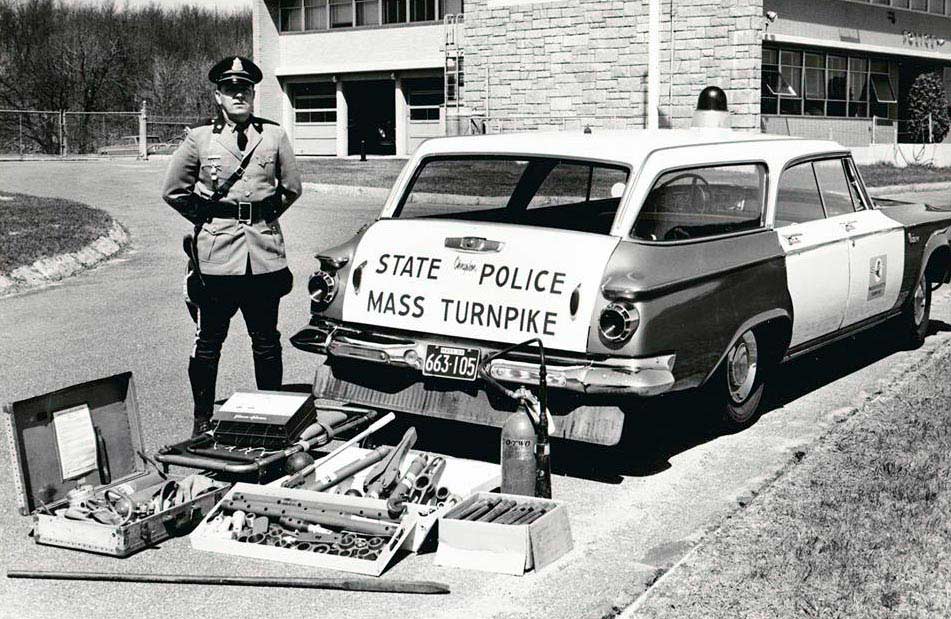 (Courtesy Mike Slepetz)
(Courtesy Mike Slepetz)
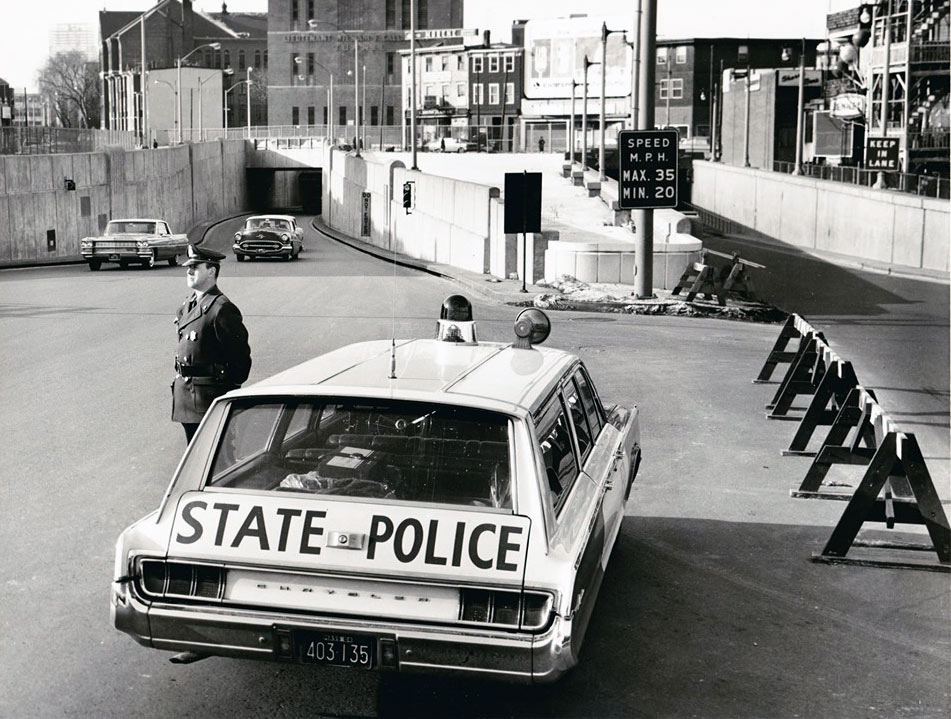 1965 Turnpike Authority Chrysler station wagon displaying a 1964 white over maroon standard passenger plate
1965 Turnpike Authority Chrysler station wagon displaying a 1964 white over maroon standard passenger plate
(Courtesy Mike Slepetz)
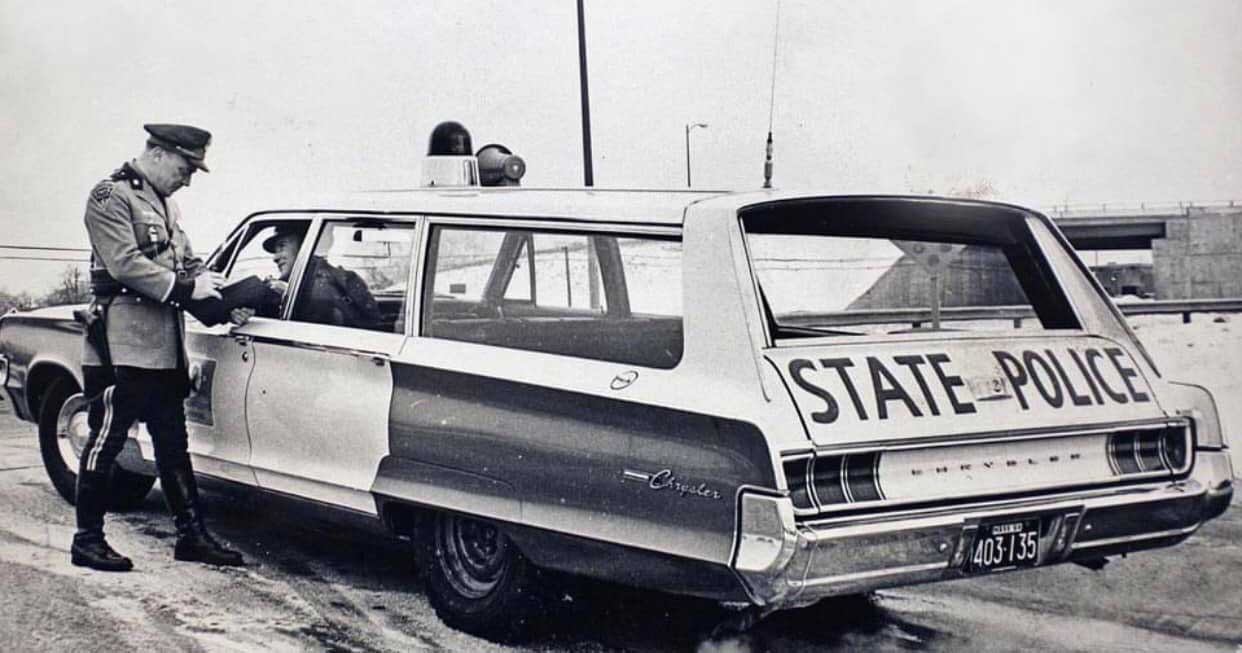 Same Turnpike Wagon as seen above.
Same Turnpike Wagon as seen above.
(Courtesy Jim Aitken)
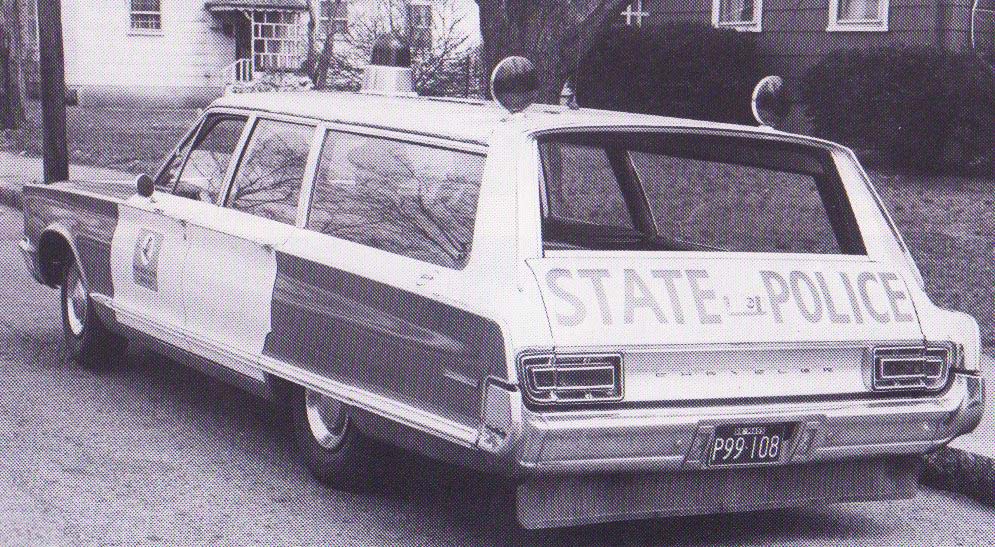 Green and white MSP Turnpike Authority Chrysler station wagon with standard white over green passenger series license plate for 1966
Green and white MSP Turnpike Authority Chrysler station wagon with standard white over green passenger series license plate for 1966

As already outlined further up the page, the Massachusetts State Police has been contracted by the Massachusetts Turnpike Authority to conduct proactive and reactive enforcement activity on their tollway since 1957 when the Mass Pike opened.
Troop "E" is unique in that it does not encompass a section of the commonwealth, but only responsible for the 138 mile Turnpike, which stretches from Boston to the New York border at the west end of the state.
E Troop headquarters are located in Boston. E troop also patrols Interstate 93 North and South from the Tip O'Neill Tunnel over the Zakim Bridge to Rutherford Avenue.
MSP Troop E patrol vehicles since the "Kelly green and white station wagon days" have been more recently made distincve by the E suffix on their license plates and fender numbers, but also by the MASS PIKE decal found on the front quarter panel face closest to the turn signal light of their patrol vehicles.
As you will see in this section, some MSP Troop E cars have even been issued with Massachusetts Turnpike license plates similar to those used by Mass Pike administration and maintenance vehicles.
One other item of note: the earlier Mass Pike license plates and signs used the emblem of the pilgrim hat and the arrow which pierced through the top of the hat. Since the early 1990's, the emblem had to be changed where the arrow was removed from the image as to be more "culturally sensitive" towards native Americans.
Troop E Barracks are located in: E-1 Weston, E-2 Charlton, E-3 Westfield, E-4 Tunnels.
Sadly, on May 2nd 2018, Troop E was disbanded, and the four barracks were taken over as such:
E-1 (Weston) Now part of Troop H
E-2 (Charlton) Now part of Troop C
E-3 (Westfield) Now part of Troop B
E-4 (Tunnels) Now part of Troop H.
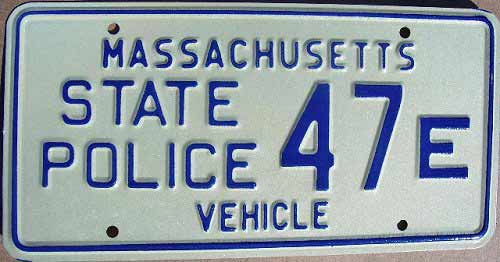 1974-1981 issue. Troop E-
1974-1981 issue. Troop E- 
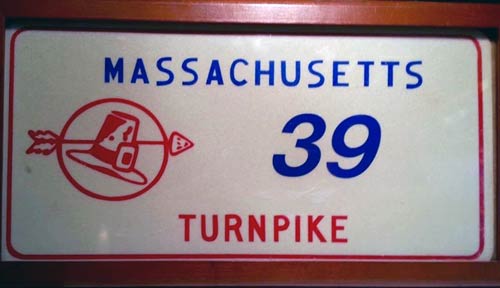 Early prototype Turnpike Authority plate. Circa 1975.
Early prototype Turnpike Authority plate. Circa 1975.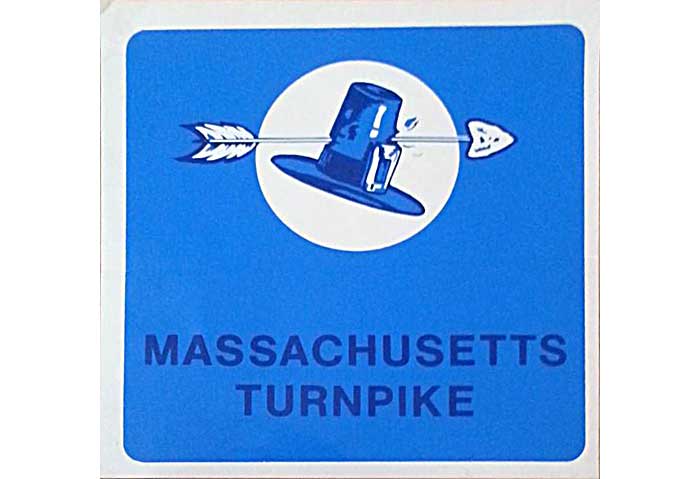 Older MSP Troop E fender decal.
Older MSP Troop E fender decal.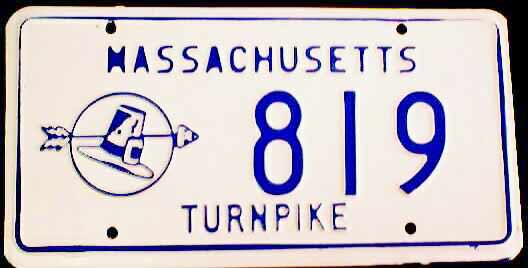 Circa 1975-1988 issue.
Circa 1975-1988 issue. 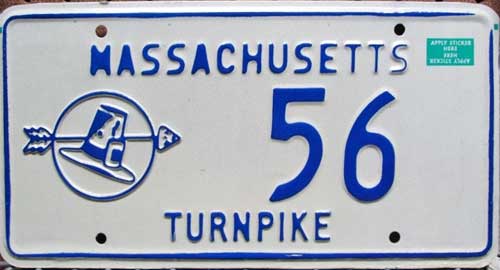 Circa 1975-1988 issue.
Circa 1975-1988 issue. 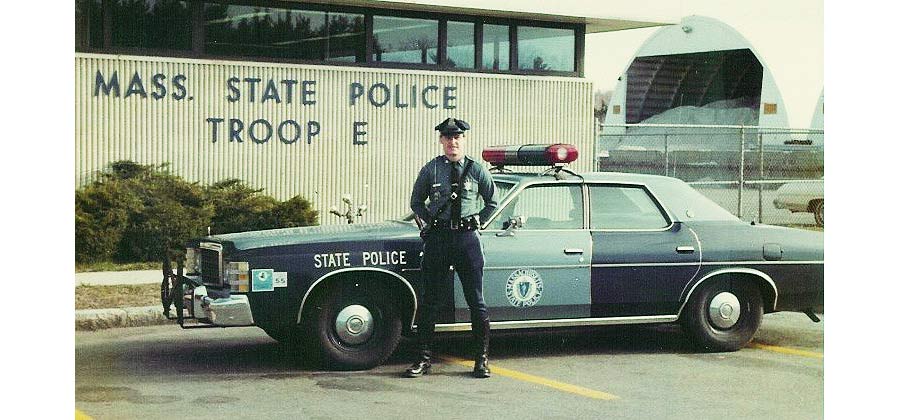
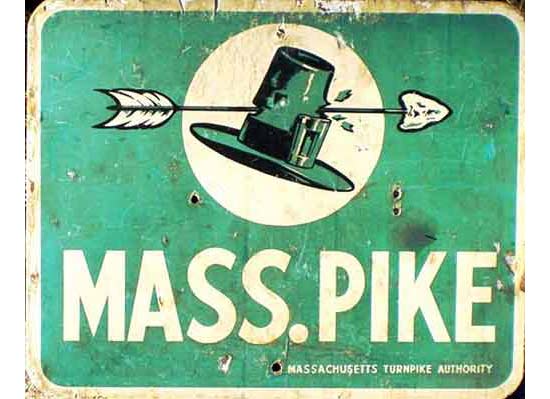
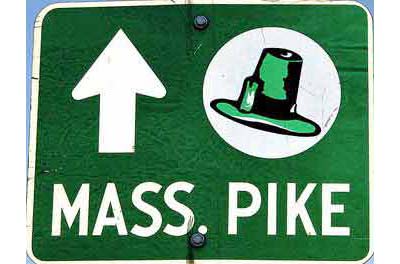 Newer emblem with no arrow through the pilgrim hat
Newer emblem with no arrow through the pilgrim hat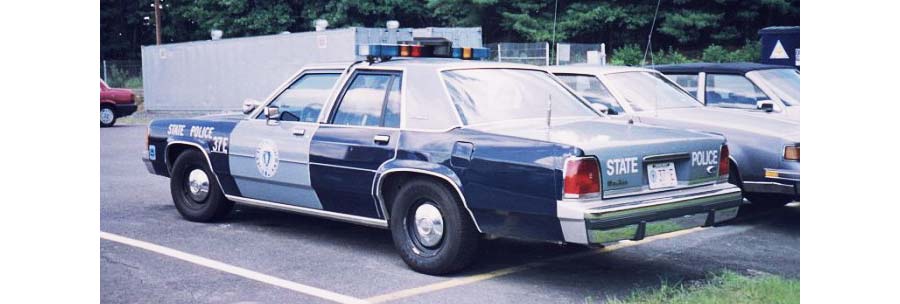
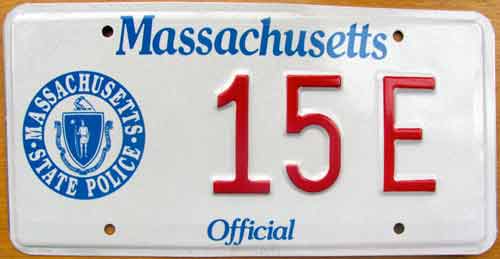 1988-2007 issue. Troop E- Massachusetts Turnpike
1988-2007 issue. Troop E- Massachusetts Turnpike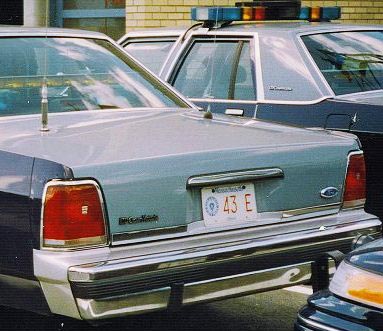
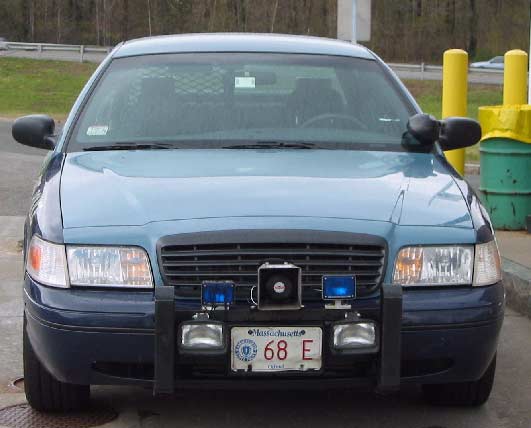
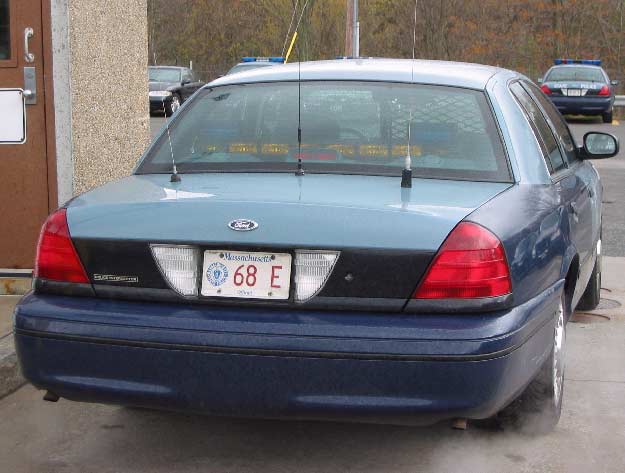
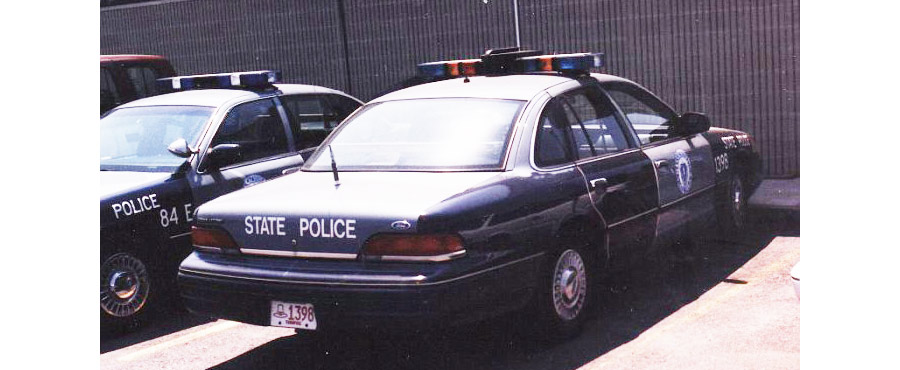 Fully-marked MSP patrol car registered with Massachusetts Turnpike Authority plate number 1398.
Fully-marked MSP patrol car registered with Massachusetts Turnpike Authority plate number 1398.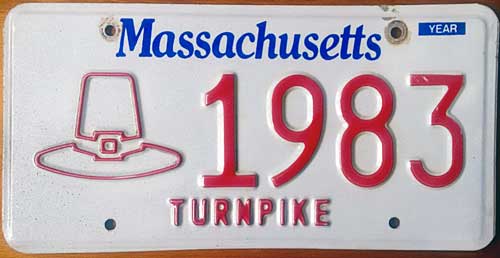 1989-current Turnpike issue.
1989-current Turnpike issue.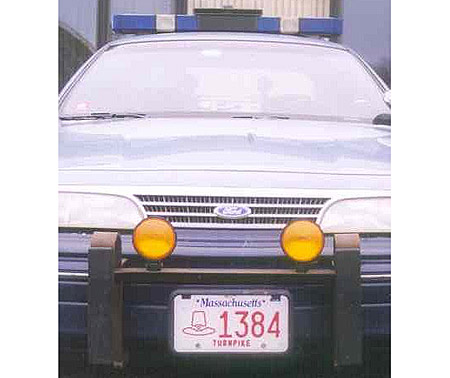

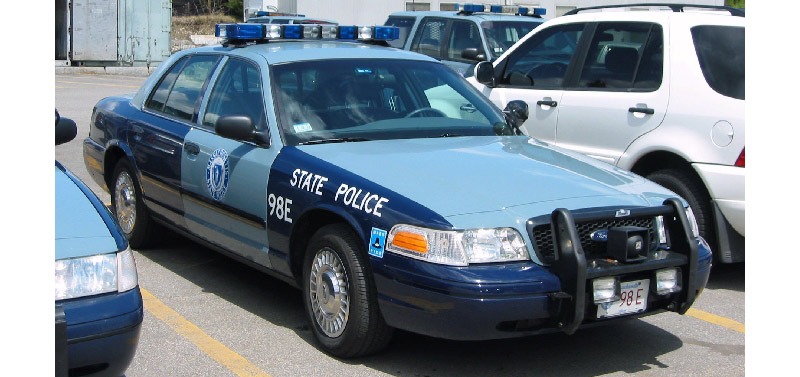
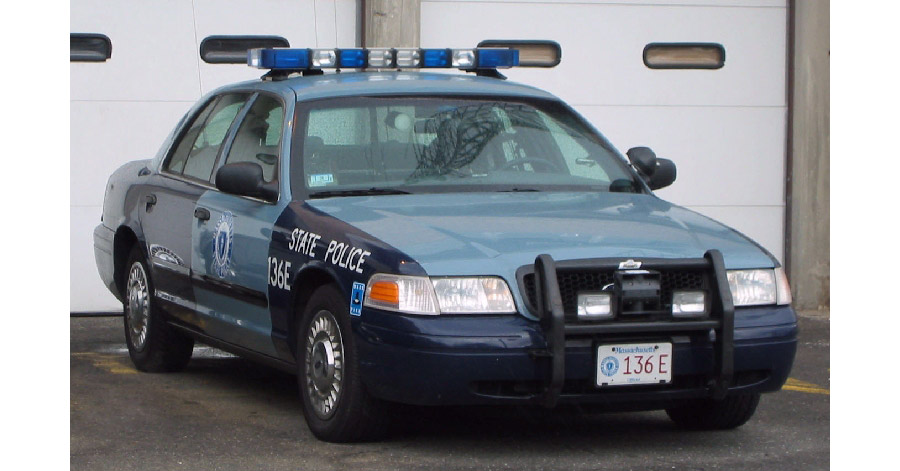
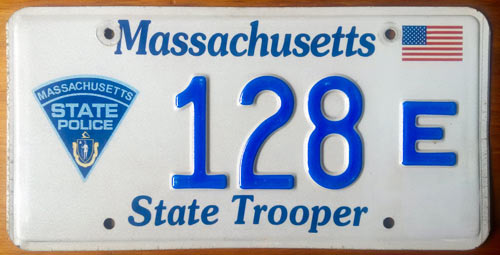 2007-2018 Troop E issue.
2007-2018 Troop E issue.
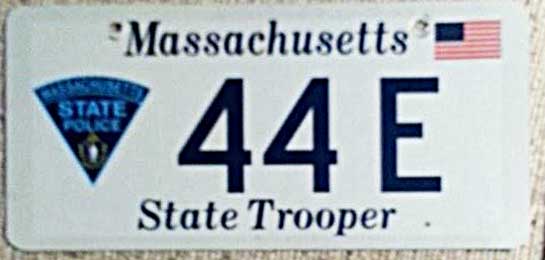 2016-2018 all-flat issue.
2016-2018 all-flat issue.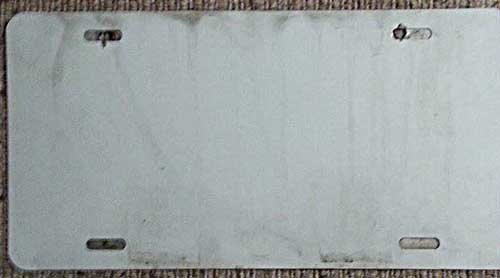 Rear of non-RMV issued Troop E license plate showing elongated mounting holes and back of sheeting applied to face of the plate.
Rear of non-RMV issued Troop E license plate showing elongated mounting holes and back of sheeting applied to face of the plate.Troop "F" patrols and provides law enforcement and security for all properties of the Massachusetts Port Authority including Boston's Tobin Bridge, Logan International Airport, the Boston Shore Line, and the World Trade Center, located in South Boston. Until 2010 its only barracks was located within the airport but has since moved to a building on the outskirts allowing for more space, parking, and better access to the property. Troop F Barracks is located in: F-1 Logan International Airport
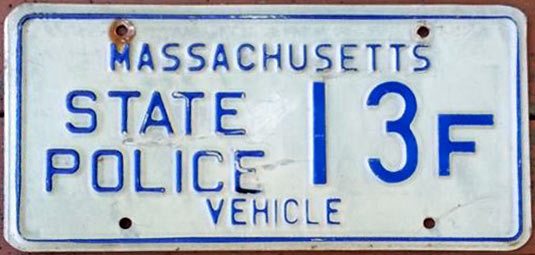 1974-1981 issue. Troop F- Logan International Airport
1974-1981 issue. Troop F- Logan International Airport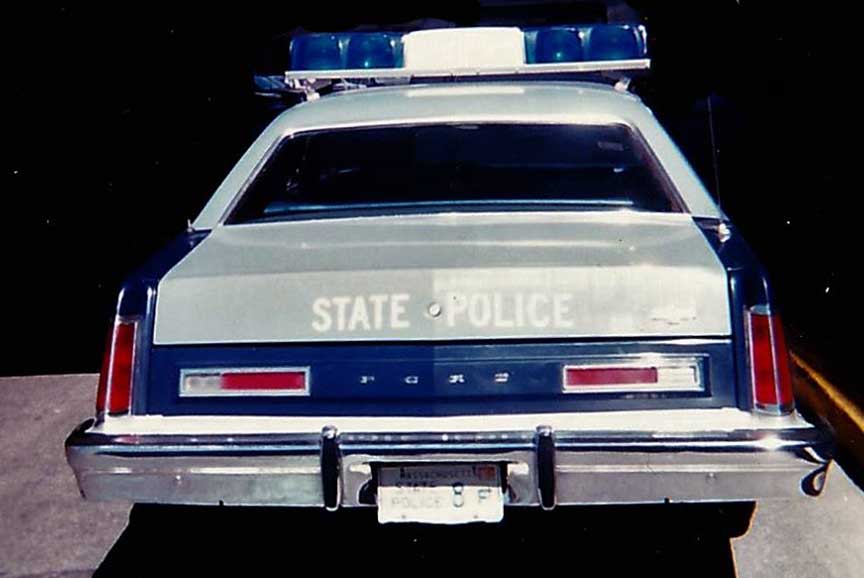 (Courtesy Chris Hurst)
(Courtesy Chris Hurst) 1981-1989 issue. Troop F- Logan International Airport
1981-1989 issue. Troop F- Logan International Airport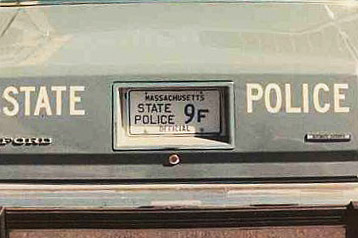
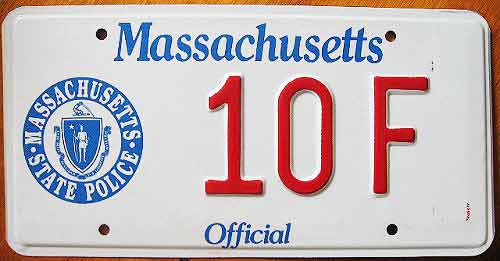 1988-2007 issue. Troop F- Logan International Airport
1988-2007 issue. Troop F- Logan International Airport
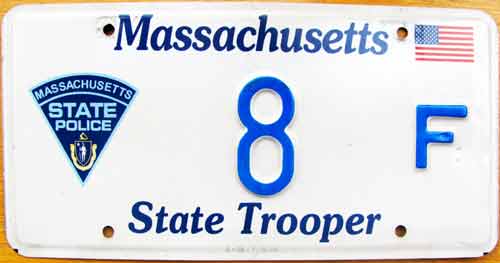 2007-Current issue. Troop F- Logan International Airport
2007-Current issue. Troop F- Logan International Airport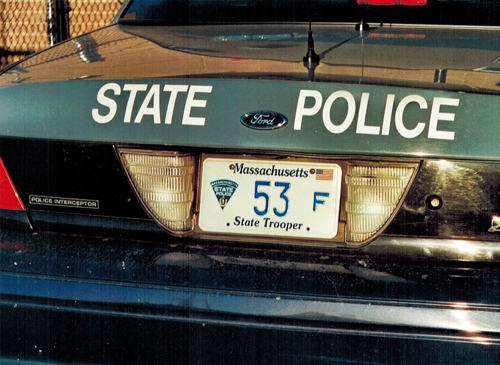
The earliest known motorcycle plate used by the agency dates back to 1923. An MDPS motorcycle used a 6 1/4" x 4 1/2" embossed steel plate # S 127. It had white characters on a dark blue background. MASS 1923 was embossed along the bottom of the plate. Assuming that State motorcycles used annual plates since that time, the following descriptions would be correct (The number can be from single to triple digit up to the 1960's):
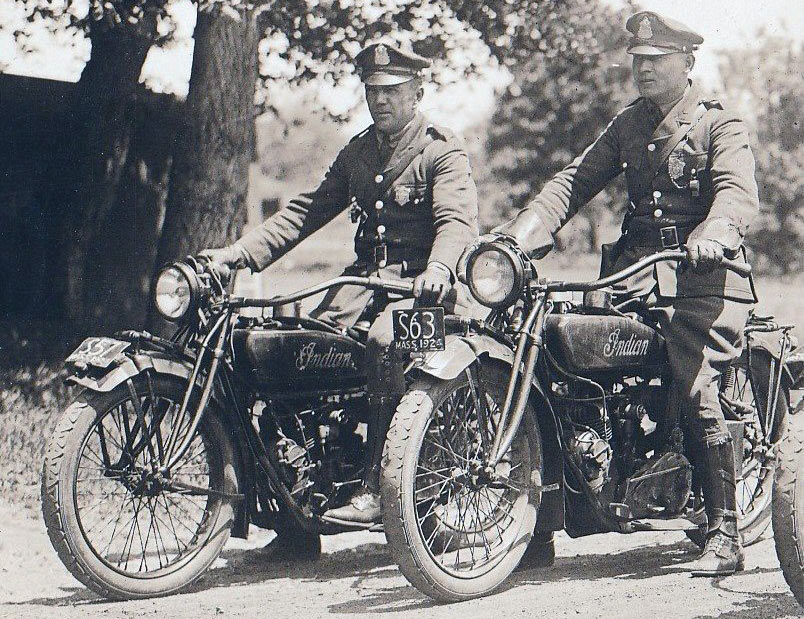 1924: white/maroon; steel 6 1/4 x 4 1/2; S ### ; MASS 1924 on bottom
1924: white/maroon; steel 6 1/4 x 4 1/2; S ### ; MASS 1924 on bottom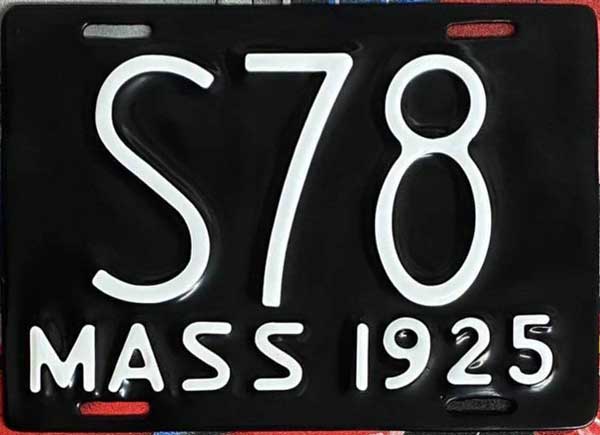 1925: Embossed steel
1925: Embossed steel
1925: white/black; steel 6 1/4 x 4 1/2; S ### ; MASS 1925 on bottom.
1926: white/blue; steel 6 1/4 x 4 1/2; S ### ; 1926 MASS on bottom.
1927: white/black; steel 6 1/4 x 4 1/2; S ### ; MASS 1927 on bottom.
1928: white/green; steel; 6 1/4 x 4 1/2; S ###; 1928 MASS on bottom.
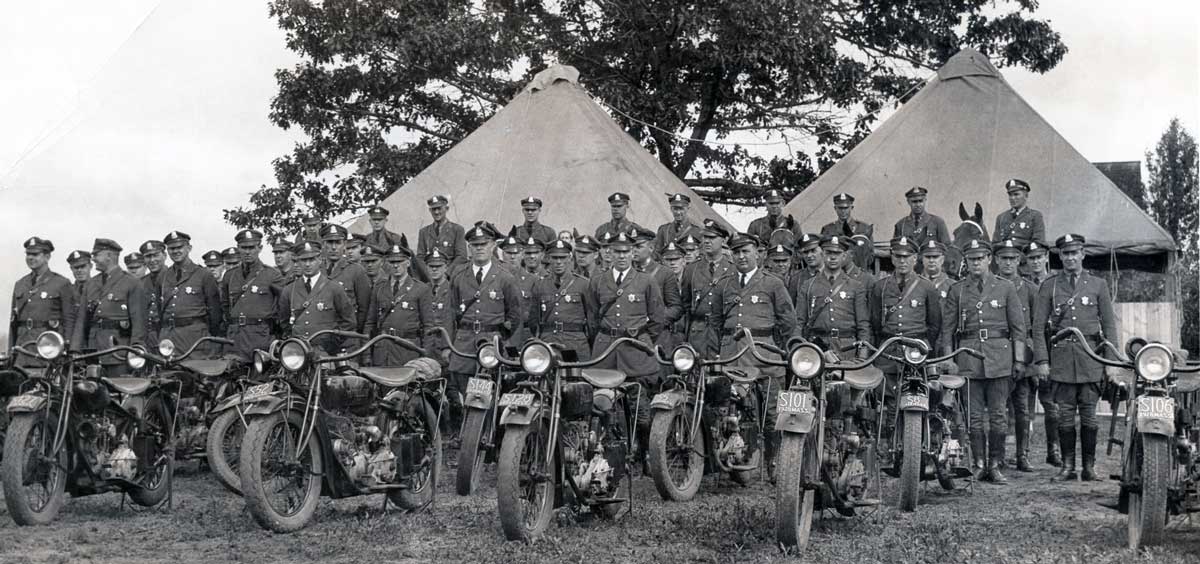 1928
1928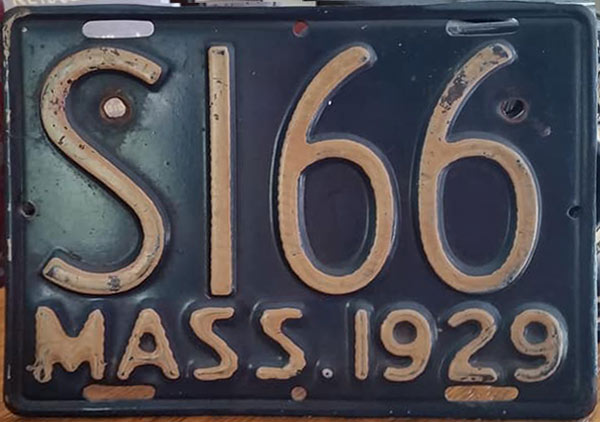 1929: Embossed steel
1929: Embossed steel 
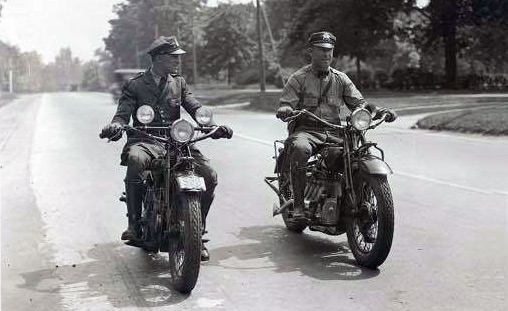 1929
1929

1930: white/maroon; steel 6 1/4 x 4 1/2; S ### ; 1930 MASS on bottom.
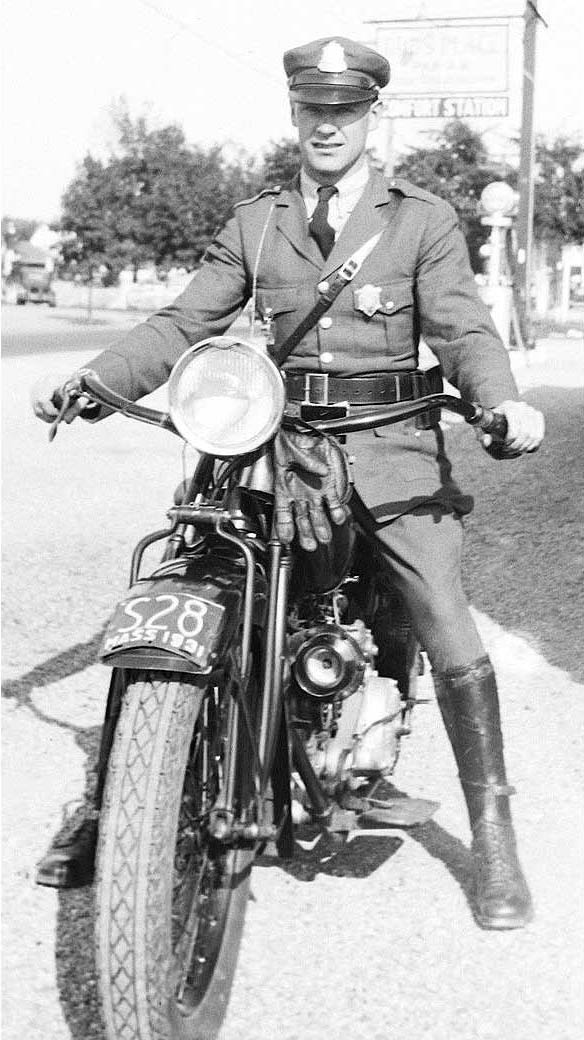
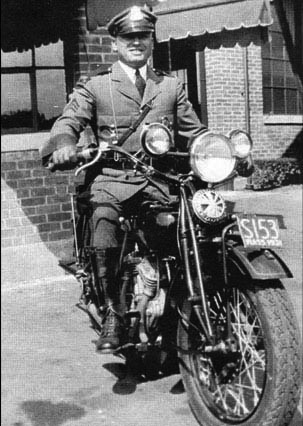 1931: white/green; steel; 6 1/4 x 4 1/2; S ###; MASS 1931 on bottom
1931: white/green; steel; 6 1/4 x 4 1/2; S ###; MASS 1931 on bottom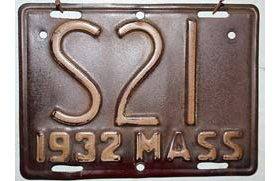 1932:Embossed steel
1932:Embossed steel 
1933: white/green; steel 6 1/4 x 4 1/2; S ### ; MASS 1933 on bottom.
1934: white/maroon; steel 6 1/4 x 4 1/2; S ### ; 1934 MASS on bottom
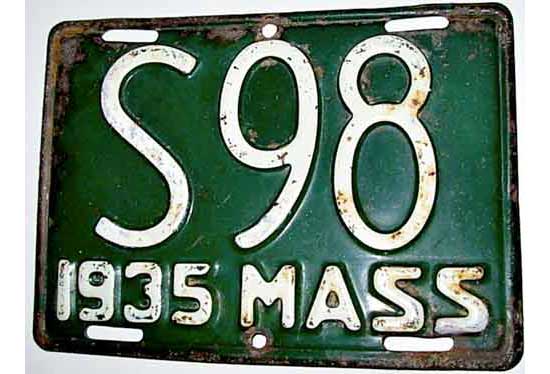 1935: Embossed steel
1935: Embossed steel 
1936: white/maroon; steel; 6 1/4 x 4 1/2; S ###; 1936 MASS bottom
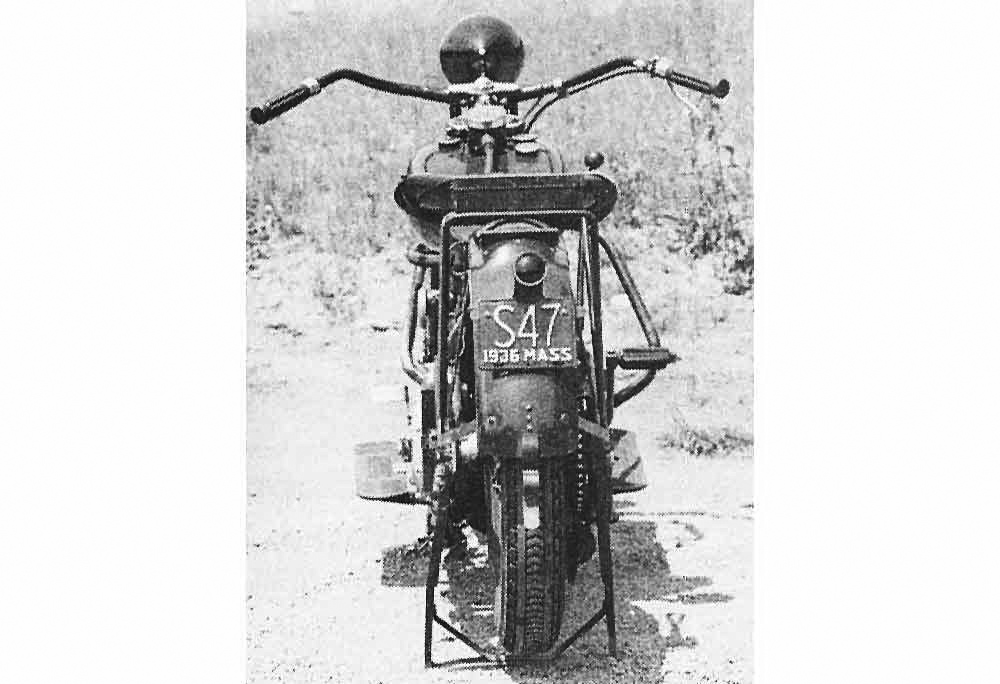
1937: white/dark green; steel 6 1/4 x 4 1/2; S ### ; 1937 MASS on bottom
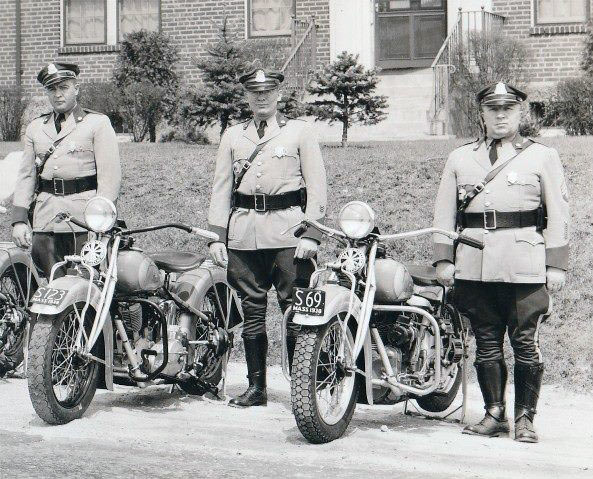 1938
1938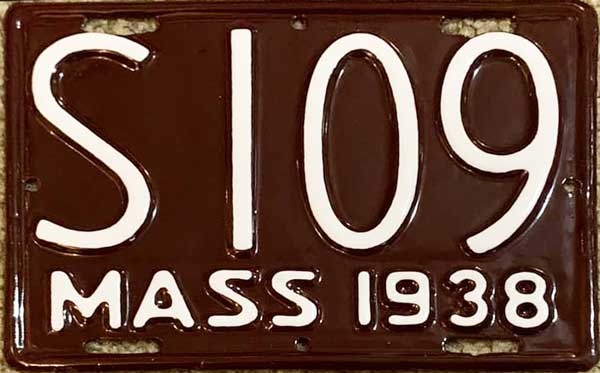 1938 issue
1938 issue 
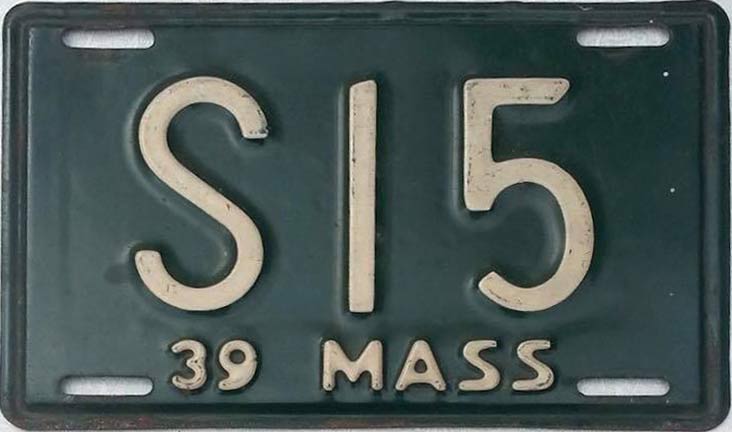 1939 issue with smaller state name and abbreviated year. Embossed steel. White over green.
1939 issue with smaller state name and abbreviated year. Embossed steel. White over green.
1940: white/maroon; steel 6 1/4 x 4 1/2; S ### ; "MASS 1940" on bottom
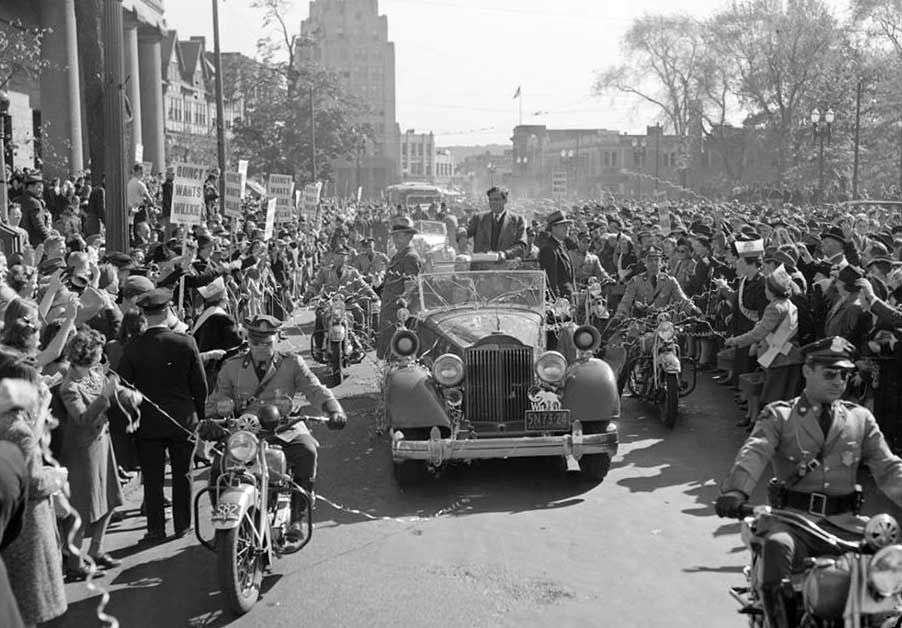 MSP escort for Wendell Wilkie campaign stop in Quincy 1940.
MSP escort for Wendell Wilkie campaign stop in Quincy 1940. 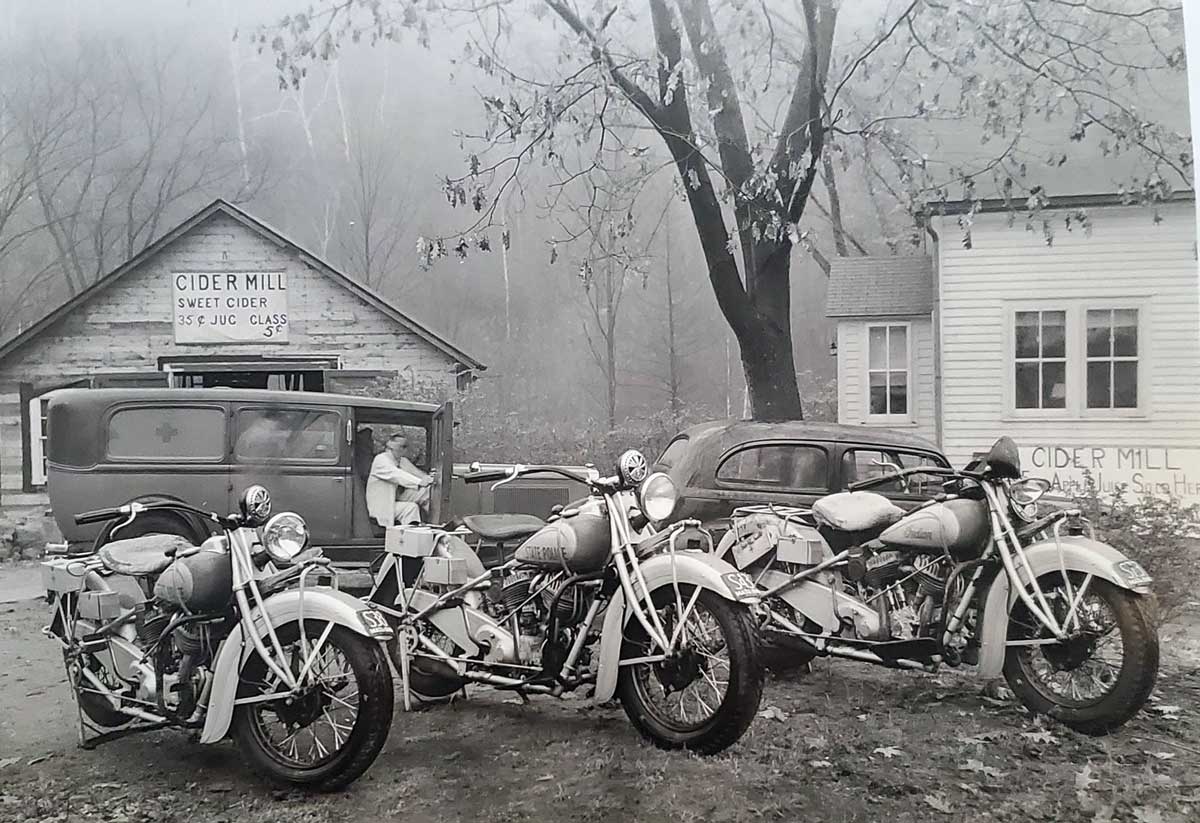 1940
1940
1941: White/green. Embossed steel. 6 1/4 x 4 5/8; S### 1941 MASS on bottom.
 1942: White/maroon; steel 6 1/4 x 4 1/2; S ### ;
1942: White/maroon; steel 6 1/4 x 4 1/2; S ### ; 
1943: (none issued)
1944: (none issued)
1945: White/dark blue. Embossed steel. 6 1/4 x 4 5/8; S### 1945 MASS on bottom.
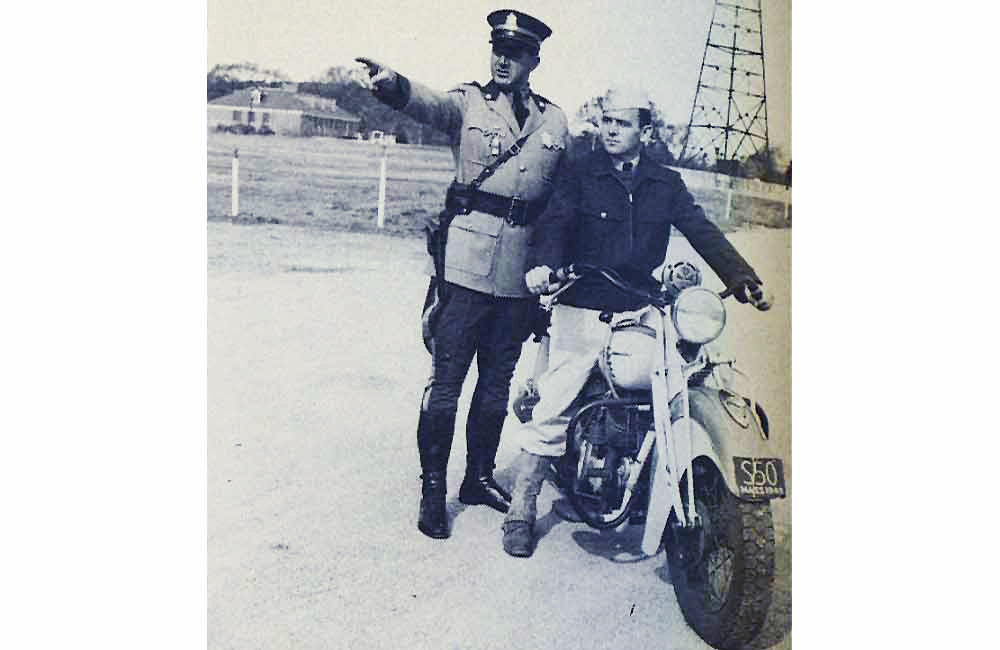
1946: white/black; steel 6 1/4 x 4 1/2; S ### ; "MASS 1946" on bottom
 1947:
1947:
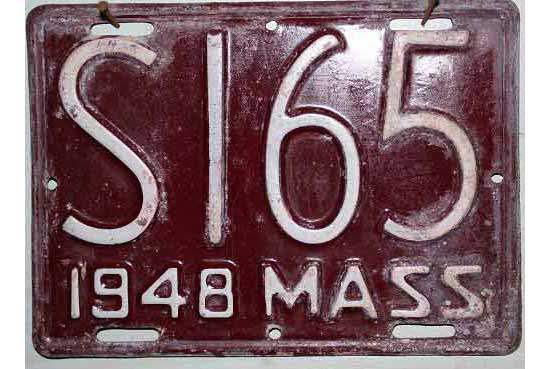 1948:
1948: 
1949: white/black; 6 1/4 x 4 1/2; S ###; "MASS 1949" on bottom

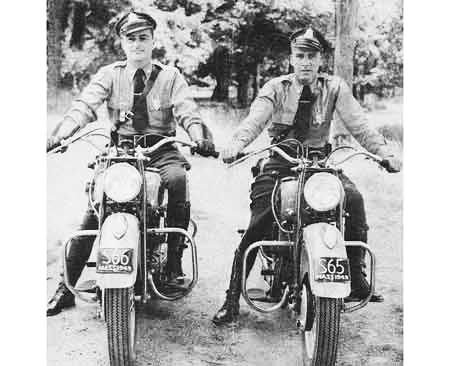
1950: (none issued)
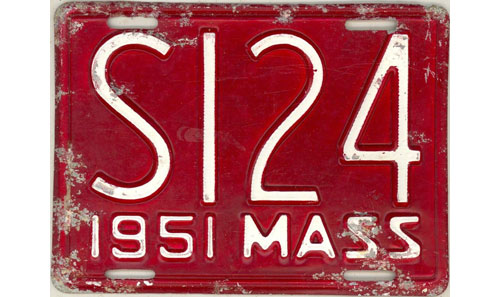 1951: Embossed aluminum
1951: Embossed aluminum
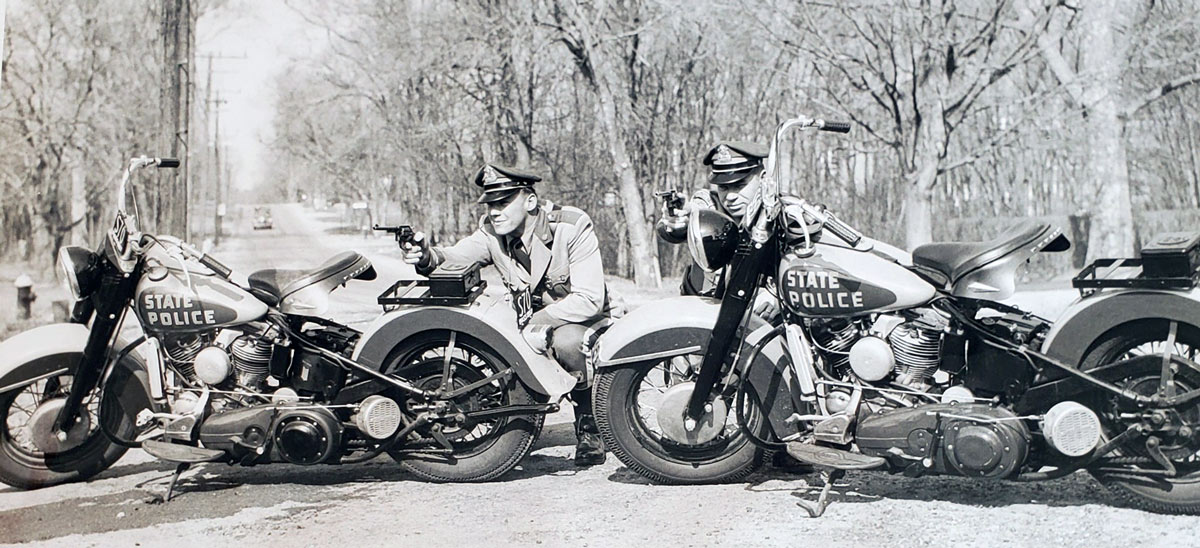 1951
1951
1952: (none issued)
1953: white/black; 6 1/4 x 4 1/2; S ###; "MASS 1953" on bottom
1954: (none issued)
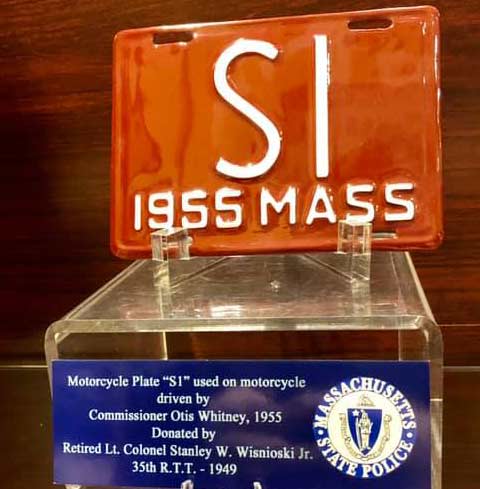 1955: Embossed steel
1955: Embossed steel  (Courtesy John Ciszek)
(Courtesy John Ciszek)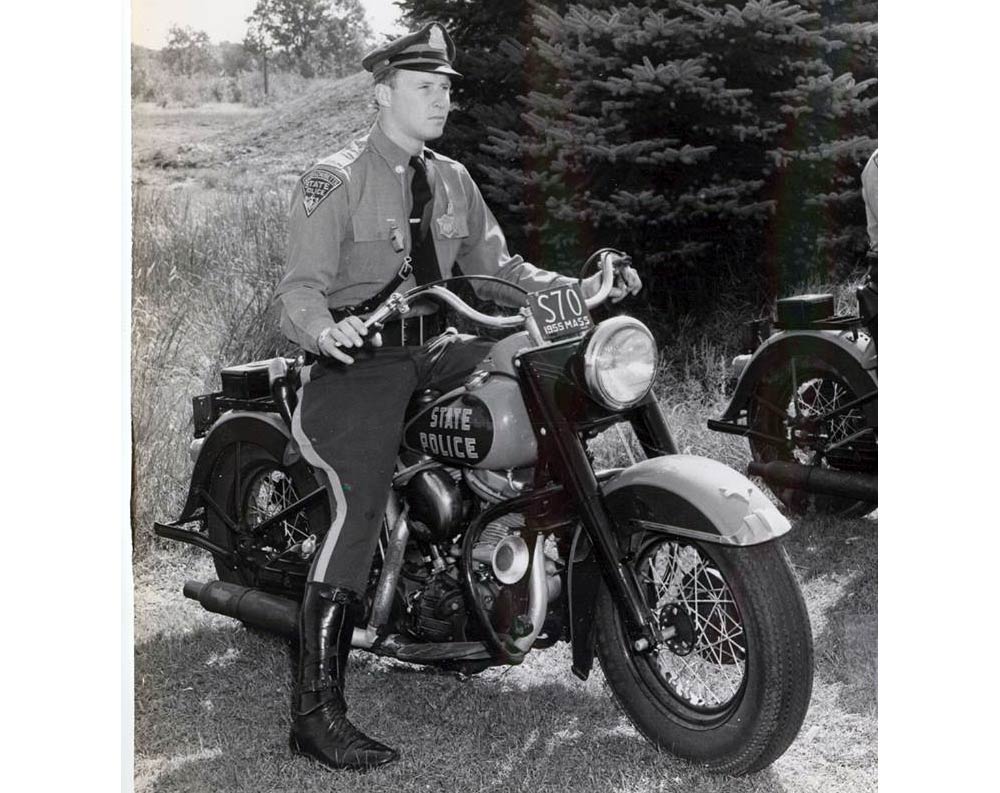 Trooper Donald McDonald- 1955.
Trooper Donald McDonald- 1955.  1955
19551956: reported but no details
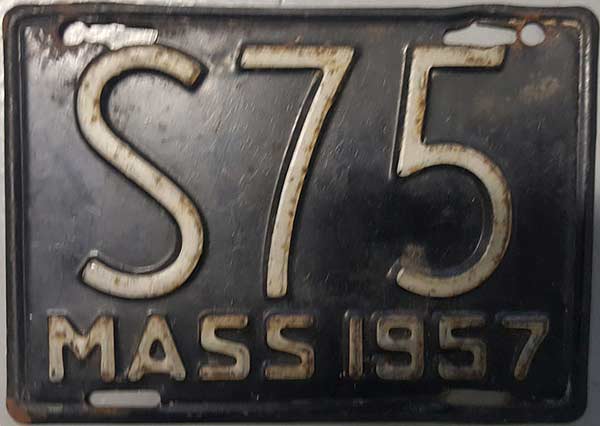 1957: Embossed steel
1957: Embossed steel 
1958: (none issued)
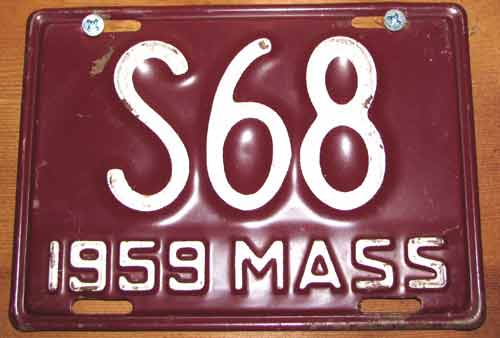 1959: Embossed steel
1959: Embossed steel 
1960: (none issued)
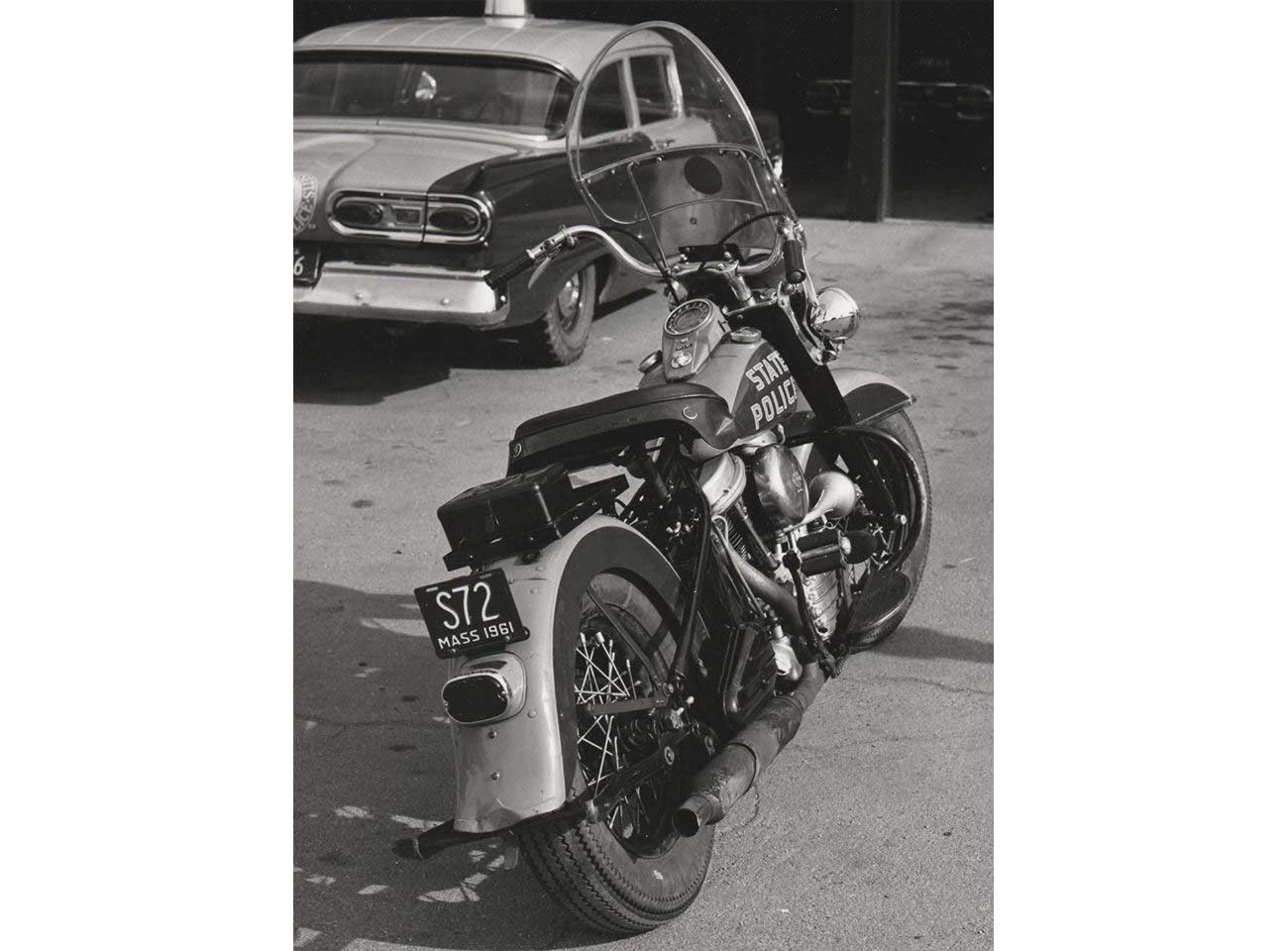 1961: white/green; embossed steel 7 1/2" x 4 1/2 "MASS 1961" on bottom
1961: white/green; embossed steel 7 1/2" x 4 1/2 "MASS 1961" on bottom
(Courtesy Jim Aitken)
1962: (none issued)
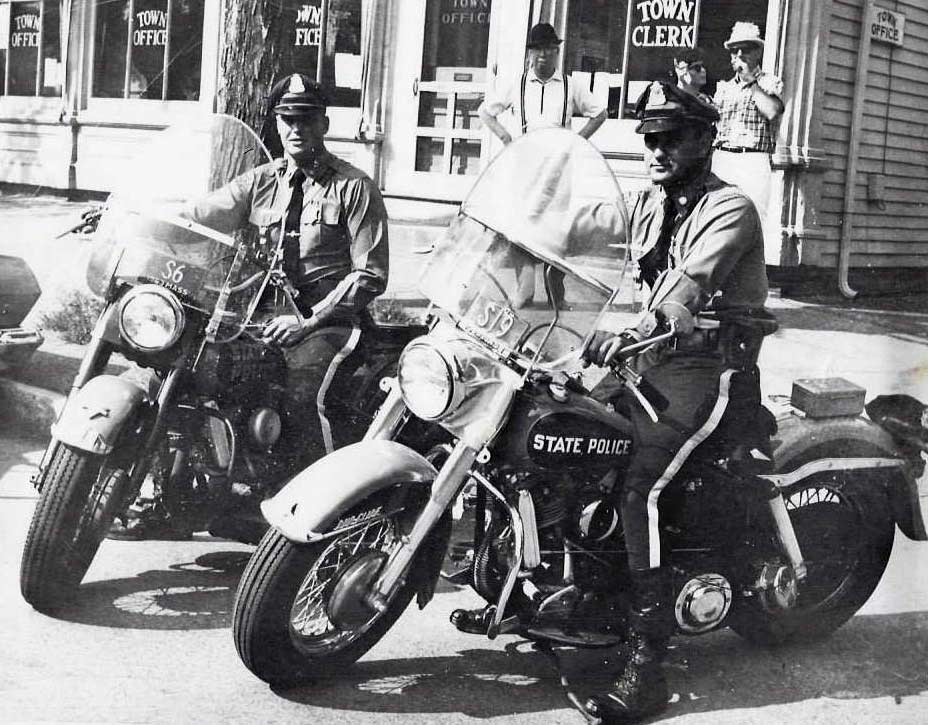 1963: white/black; embossed steel; 7 1/2" x 4 1/2" "1963 MASS" on bottom
1963: white/black; embossed steel; 7 1/2" x 4 1/2" "1963 MASS" on bottom
(Courtesy Jim Aitken)
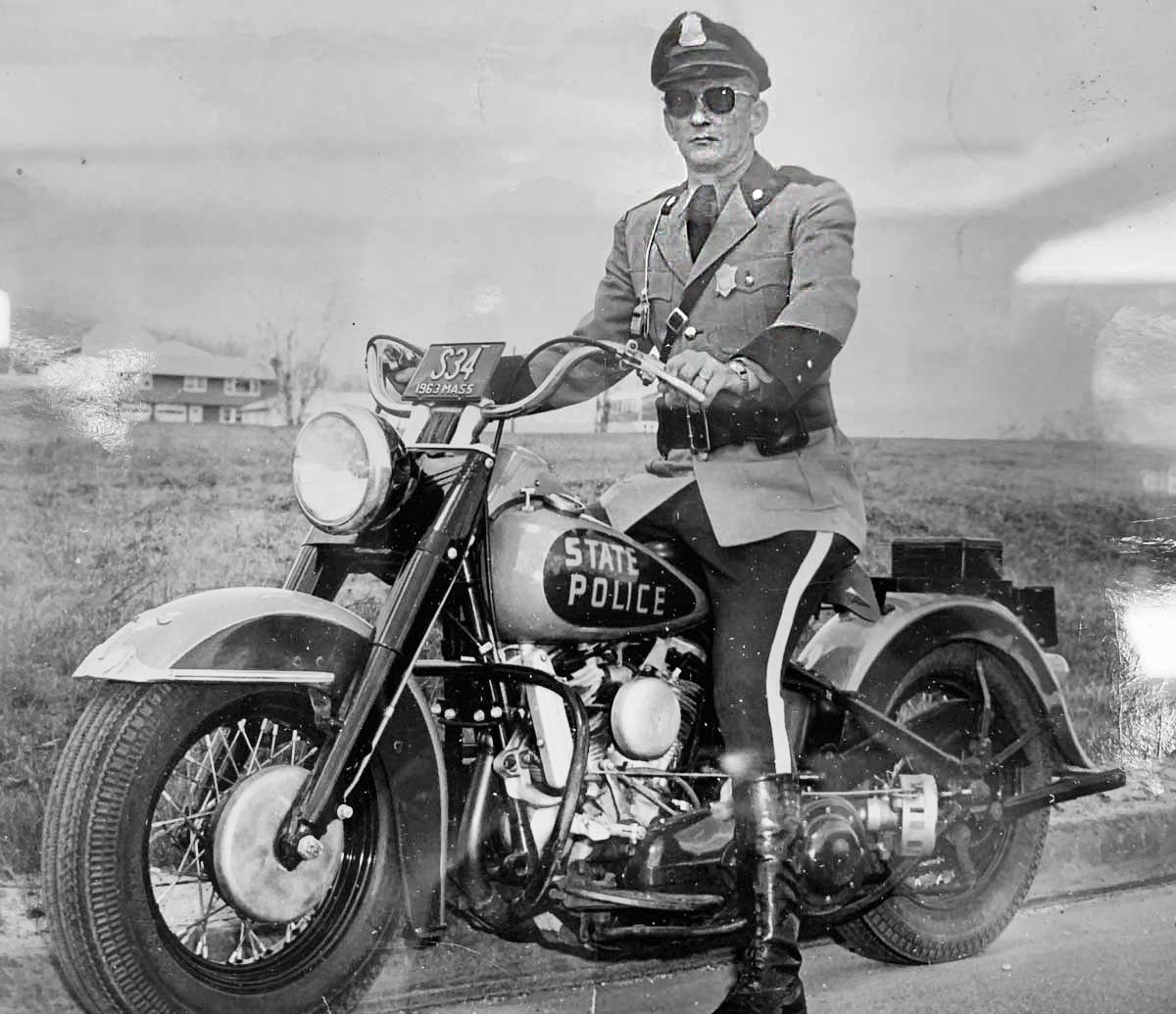 1963
1963
(Courtesy Jack Murphy)
1964: white/maroon; steel; 7 1/2" x 4 1/2"; S ###; "MASS 1964"on bottom
1965: (none issued)
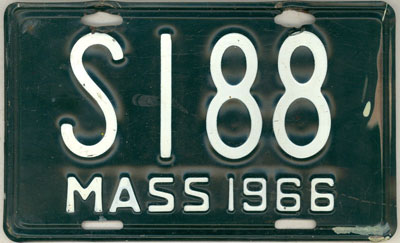 1966 issue.Embossed steel
1966 issue.Embossed steel
If MSP motorcycle license plates were to follow the same issuance pattern as car license plates, it would stand to reason that by 1967, a blue over reflective white license plate would have been issued with MASS embossed at the top of the plate and a number up to three digits prefixed by the letter S. Unfortunately, there seems to be no evidence to support this notion as of this time, as no specimens, records or photographs from the 1967 to 1969 period exists for MSP motorcycle license plates.
However, in 1970 MSP issued a white over reflective medium blue license plate with MASS embossed at the top center of the plate and a number up to three digits prefixed by the letter S. The plate was embossed aluminum and measured 7 1/2" x 4 1/2". These plates were validated for 1971 using a reflective white over red decal of the type used on passenger license plates with a DEC-71 expiry. These decals however had a number prefixed by the letter T and a number in the 0073 series.
During 1972-1973, motorcycles assigned to Foxboro (Troop H- Station 3) displayed special titled license plates on the sides of their radio boxes. MSP motorcycles at the time had not markings on the rear, so a couple of troopers got together and decided to have plates made up to be a prominent identifier from the rear. Only four of these special plates were made by the Massachusetts Department of Public Works in Wellesley. The plates were flat screened aluminum and measured 6" x 12" like a car license plate. A reflective white background (that soon yellowed) was used with reflective blue lettering saying only STATE over POLICE.
These Foxboro SP cycles were used primarily for duty at Schaeffer Stadium (now Gillette Stadium) football games.
In the early 1980's when new light assemblies were installed, these special plates were removed.
 1970-1973 issue. Embossed aluminum
1970-1973 issue. Embossed aluminum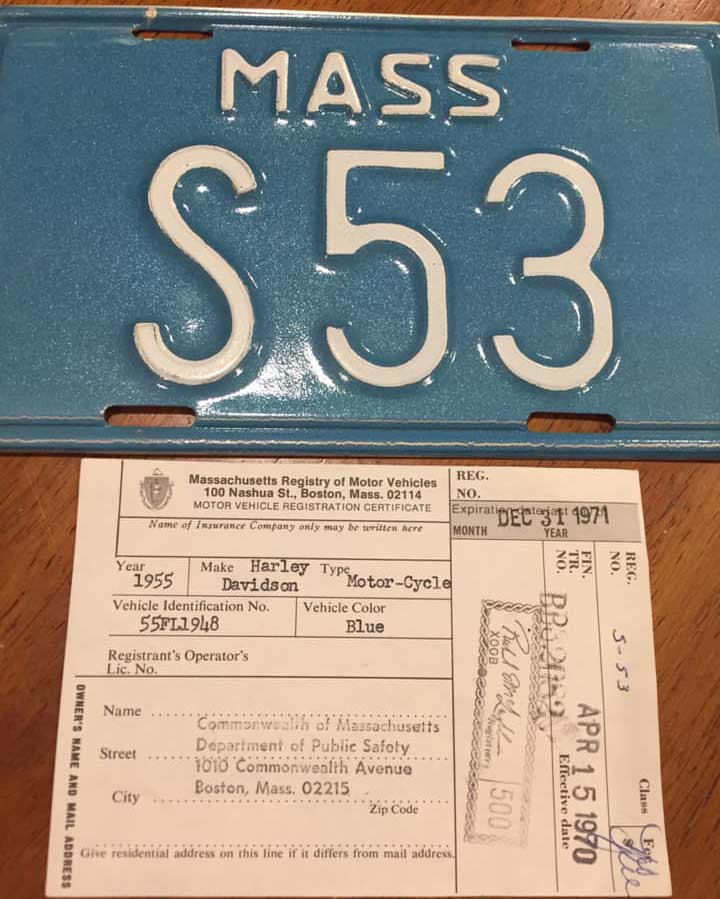 1970-1973 motorcycle issue with corresponding registration slip for a 1955 Harley Davidson still in service with the MSP !
1970-1973 motorcycle issue with corresponding registration slip for a 1955 Harley Davidson still in service with the MSP !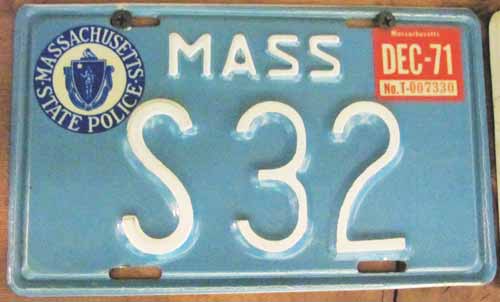 1970-1973 motorcycle issue. 1971 validation decal # T-007330.
1970-1973 motorcycle issue. 1971 validation decal # T-007330. 
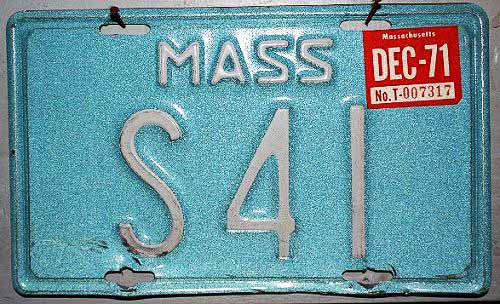 1970-1973 motorcycle issue.
1970-1973 motorcycle issue. 
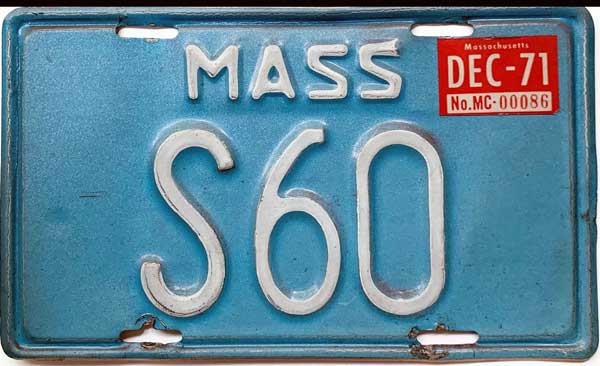 1970-1973 issue.
1970-1973 issue.
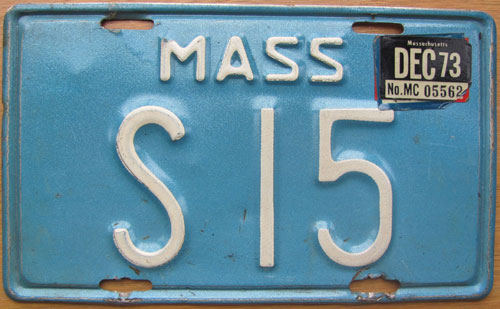 1970-1973 motorcycle issue.
1970-1973 motorcycle issue. 
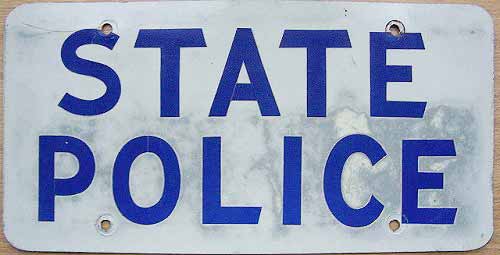 1974-circa 1980 issue. One of four specially-made license plates made by the Department of Public Works in Wellesley for two (later 4) MSP patrol motorcycles from SP Foxboro. These plates were mounted to the back of the radio box for each motorcycle. Used primarily for patrol at Schaeffer Stadium during football events.
1974-circa 1980 issue. One of four specially-made license plates made by the Department of Public Works in Wellesley for two (later 4) MSP patrol motorcycles from SP Foxboro. These plates were mounted to the back of the radio box for each motorcycle. Used primarily for patrol at Schaeffer Stadium during football events.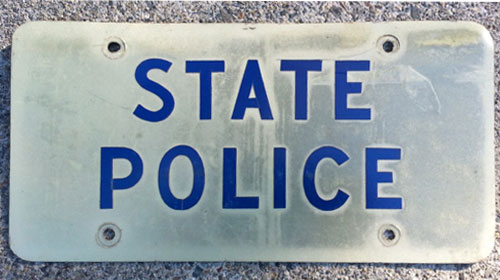 Different version of the earlier "radio box" license plate seen at left. Smaller font used with 1 1/2" tall characters on same background material made by Department of Public Works.
Different version of the earlier "radio box" license plate seen at left. Smaller font used with 1 1/2" tall characters on same background material made by Department of Public Works.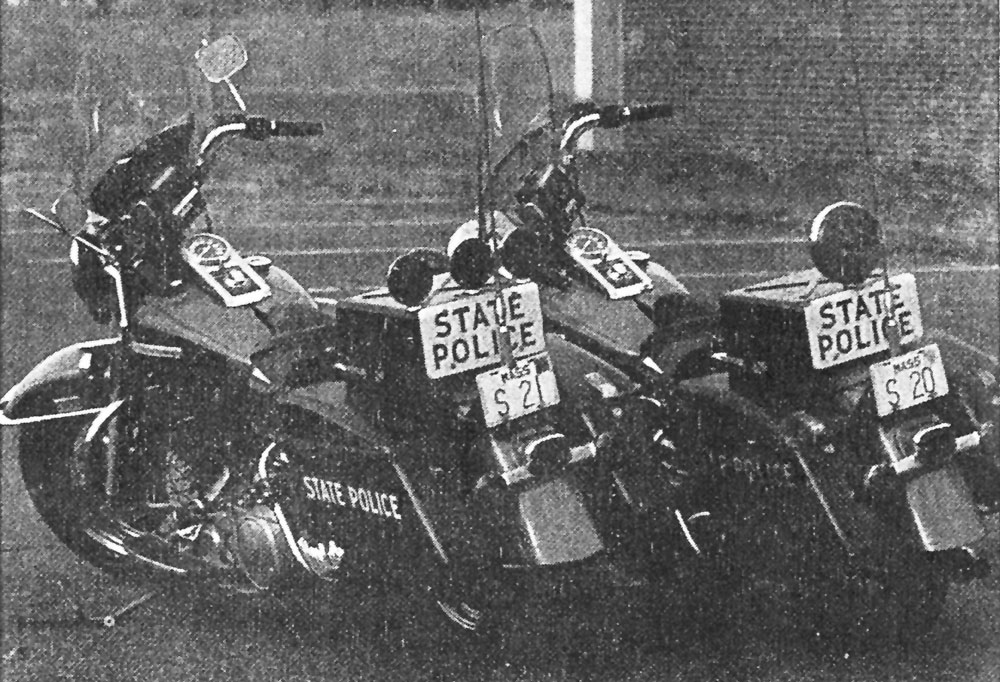 1979- Showing specially-made radio box plates in use.
1979- Showing specially-made radio box plates in use.
(Courtesy of Paul J. "Bad Dog" Driscoll)
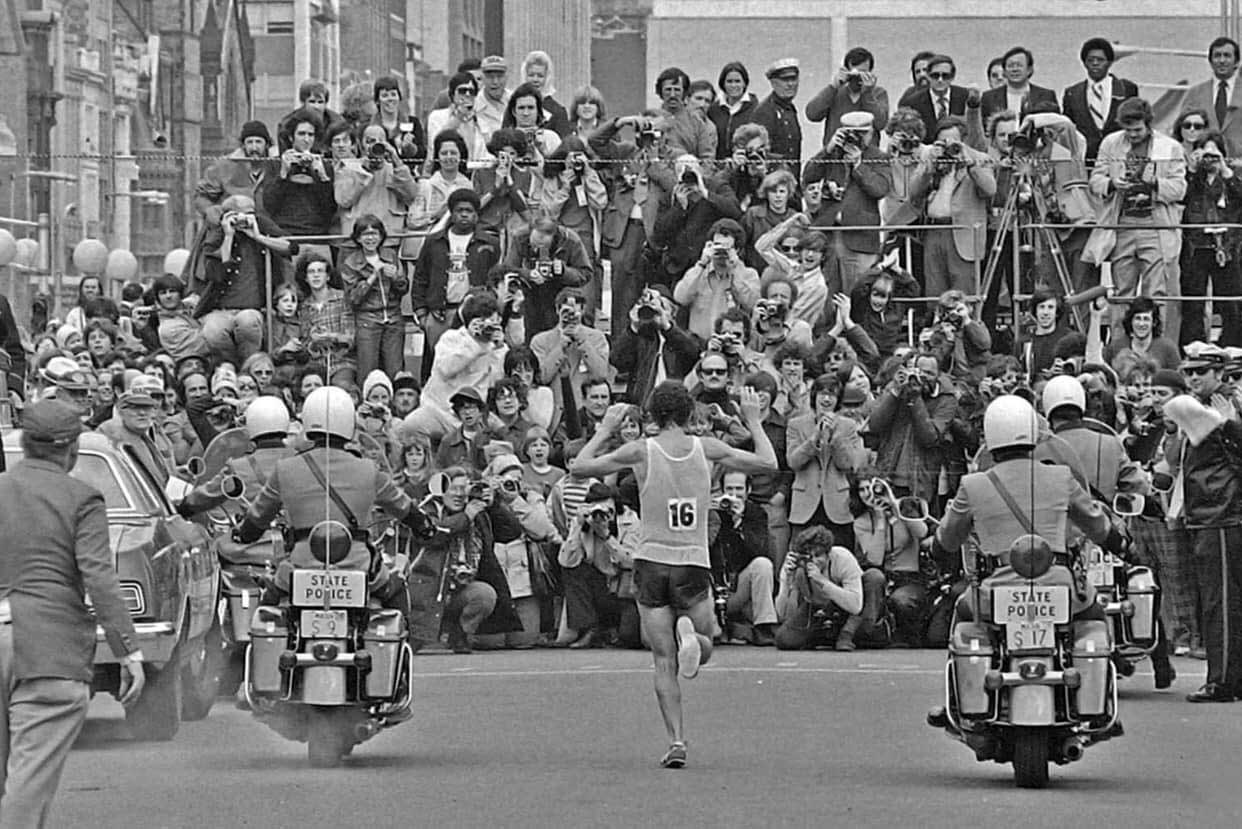 1974 Boston Marathon escort.
1974 Boston Marathon escort.
(Courtesy Jim Aitken)
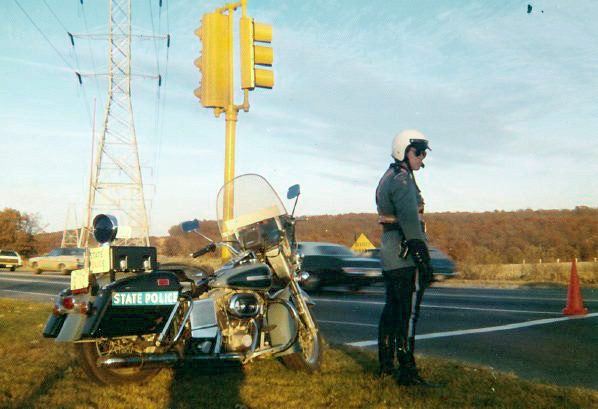 Circa 1974. Showing radio box plate below large rear blue light.
Circa 1974. Showing radio box plate below large rear blue light.
(Courtesy Chris Hurst)
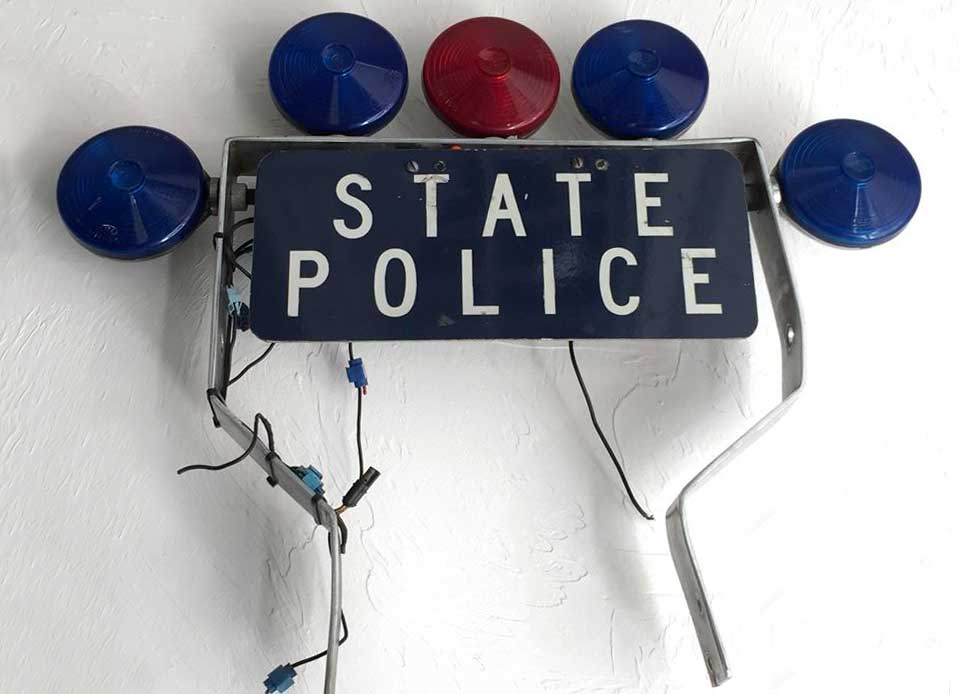 MSP motorcycle "Christmas tree" rear light assembly. Circa late 1970's-1980's.
MSP motorcycle "Christmas tree" rear light assembly. Circa late 1970's-1980's.
(Courtesy Jim Aitken)
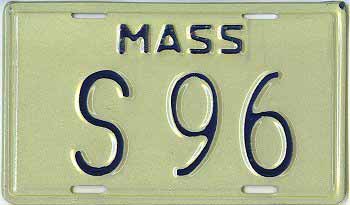 1974-circa 1980 motorcycle issue. Embossed aluminum.
1974-circa 1980 motorcycle issue. Embossed aluminum.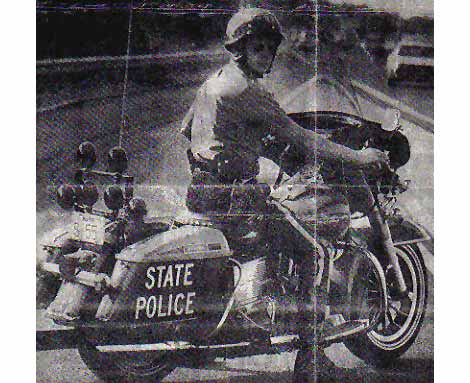
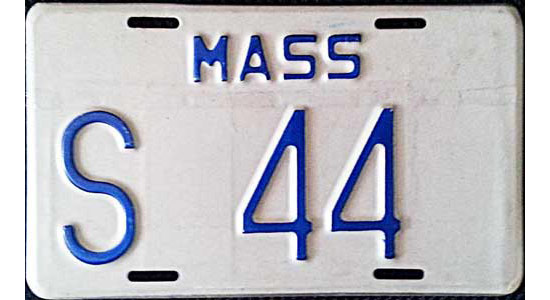 Circa 1979-1980 motorcycle issue. Embossed aluminum.
Circa 1979-1980 motorcycle issue. Embossed aluminum.
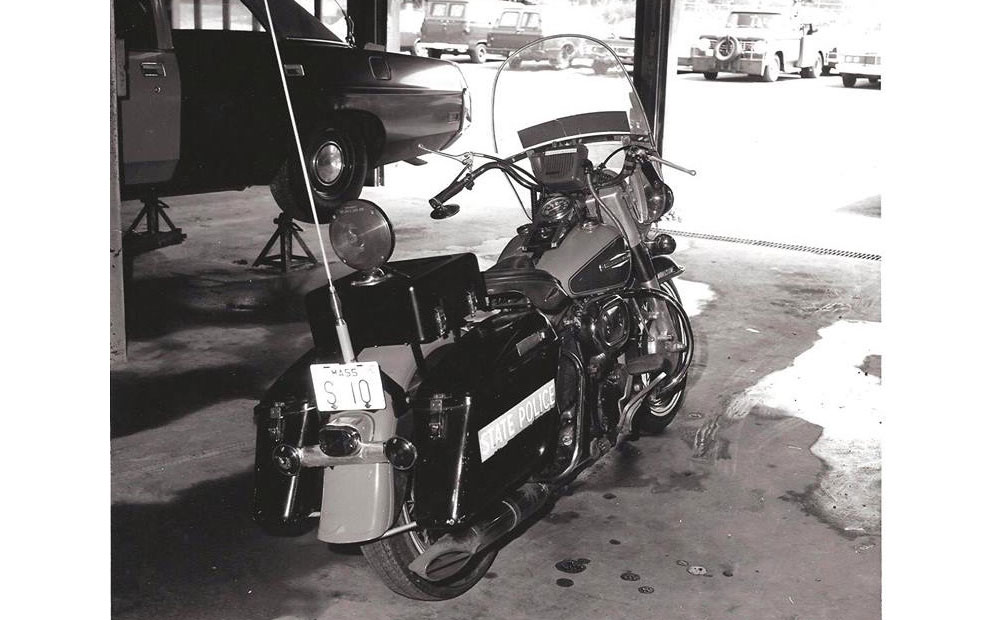 Framingham-1979. Number S 10 with no validation decal.
Framingham-1979. Number S 10 with no validation decal. 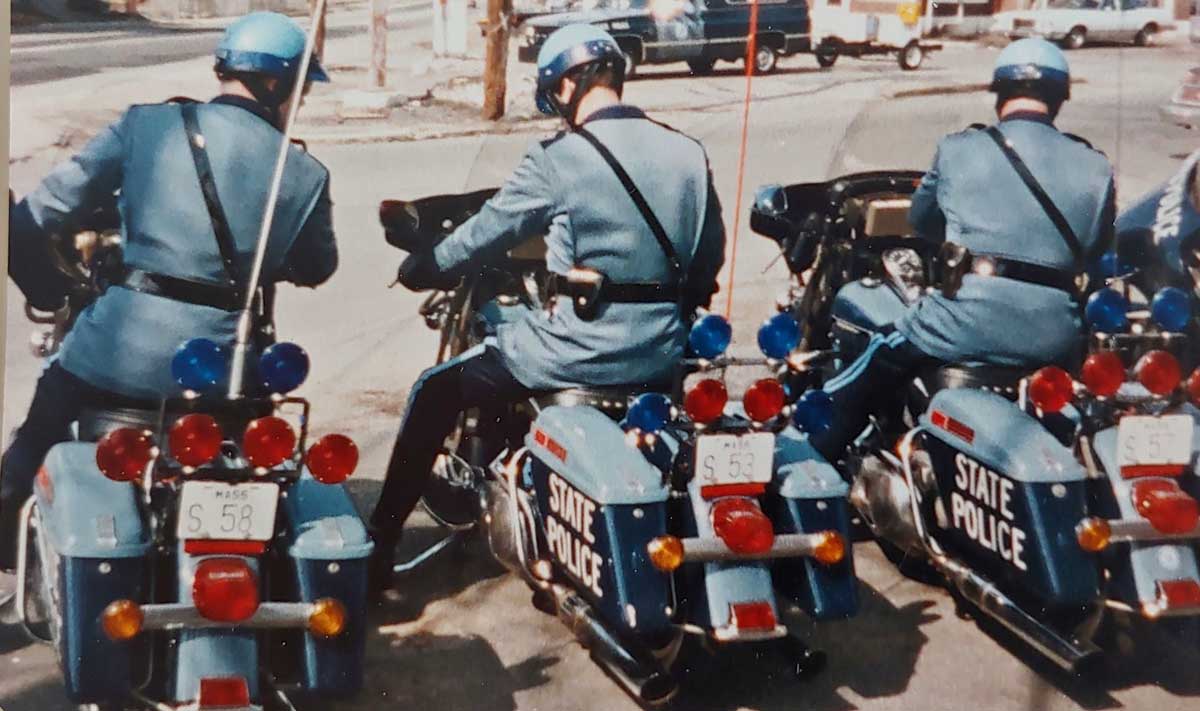 (Courtesy Jack Murphy)
(Courtesy Jack Murphy)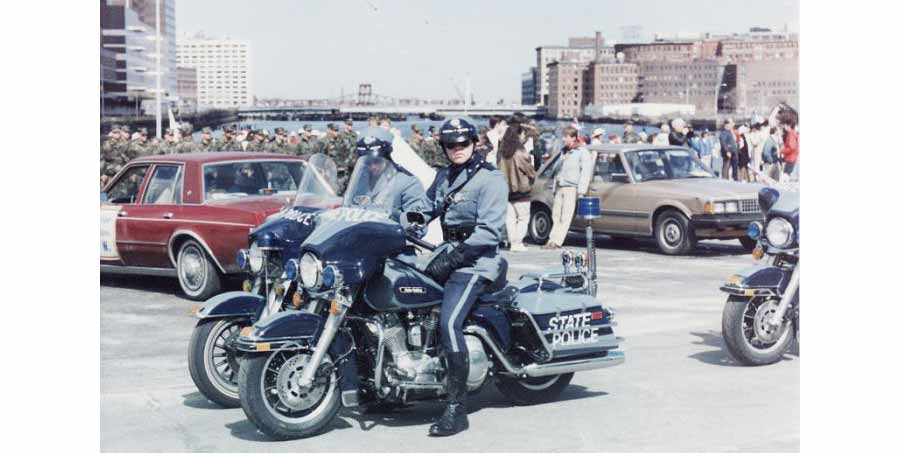 Trooper Mike Crosby- All business !
Trooper Mike Crosby- All business !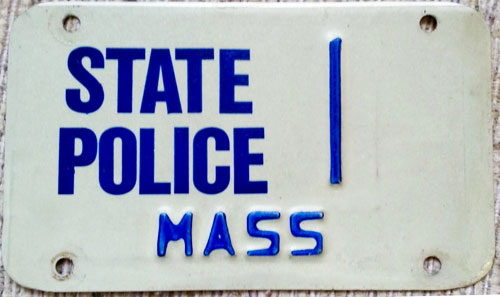 Circa 1980's motorcycle issue.
Circa 1980's motorcycle issue. 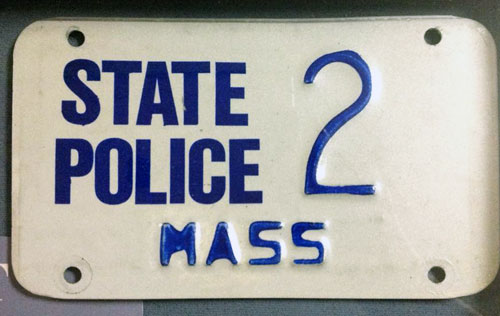 Circa 1980's motorcycle issue.
Circa 1980's motorcycle issue. 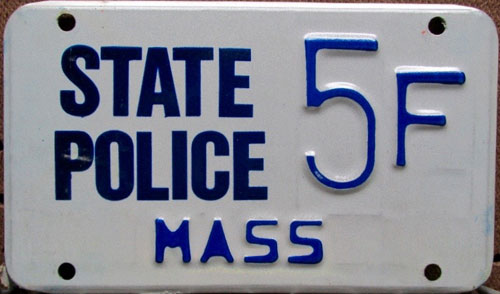 Circa 1980's motorcycle issue.
Circa 1980's motorcycle issue. 
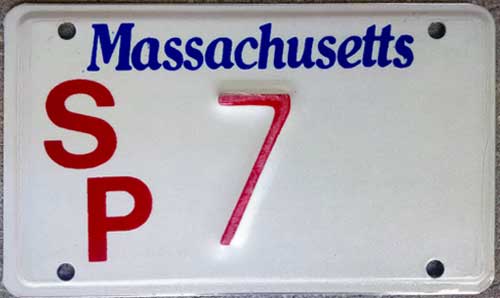 1988- circa 1999 motorcycle issue. State name spelled in full with screened SP prefix. No emblem.
1988- circa 1999 motorcycle issue. State name spelled in full with screened SP prefix. No emblem.
 1988-circa 1999 Troop E (Mass Turnpike) and standard issue
1988-circa 1999 Troop E (Mass Turnpike) and standard issue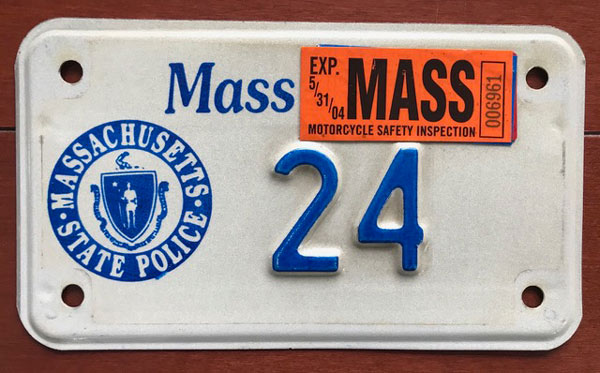 Circa 1995-2007 motorcycle issue.
Circa 1995-2007 motorcycle issue. 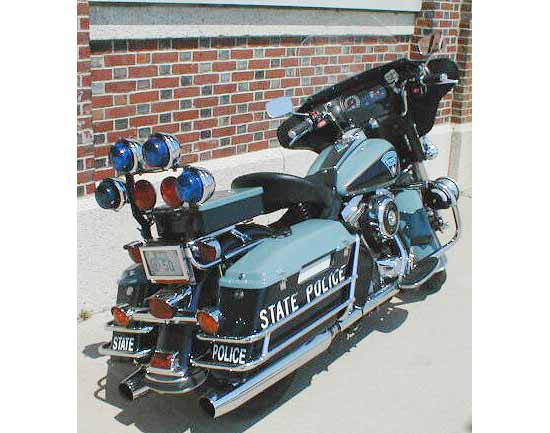
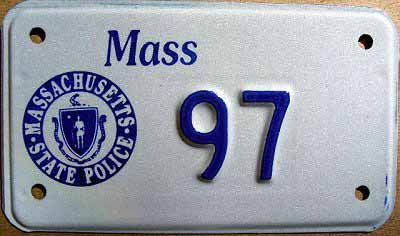 Circa 1995-2007 motorcycle issue.
Circa 1995-2007 motorcycle issue. 
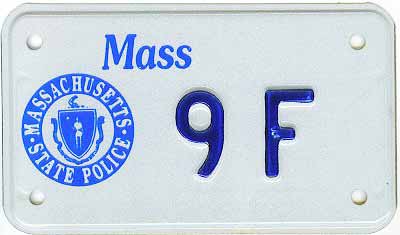 Circa 1995-2007 motorcycle issue.
Circa 1995-2007 motorcycle issue. 
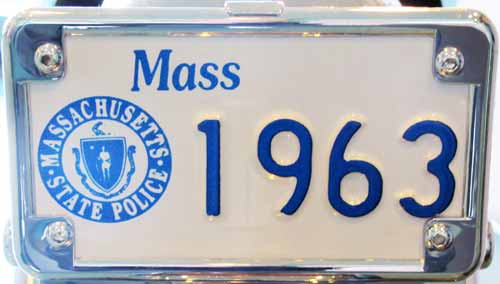 MSP Museum motorcycle- 1963 Harley Davidson
MSP Museum motorcycle- 1963 Harley Davidson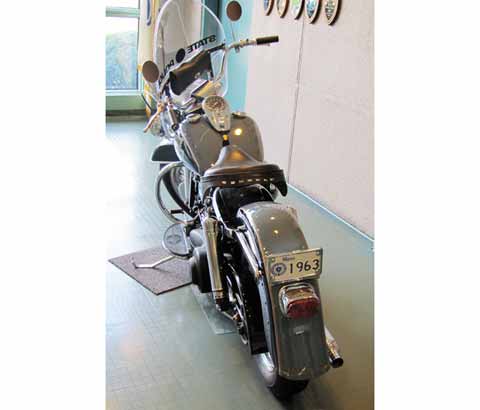
 Prototype MSP motorcycle blank- 1998.
Prototype MSP motorcycle blank- 1998. 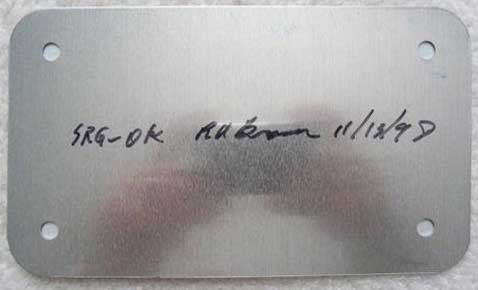
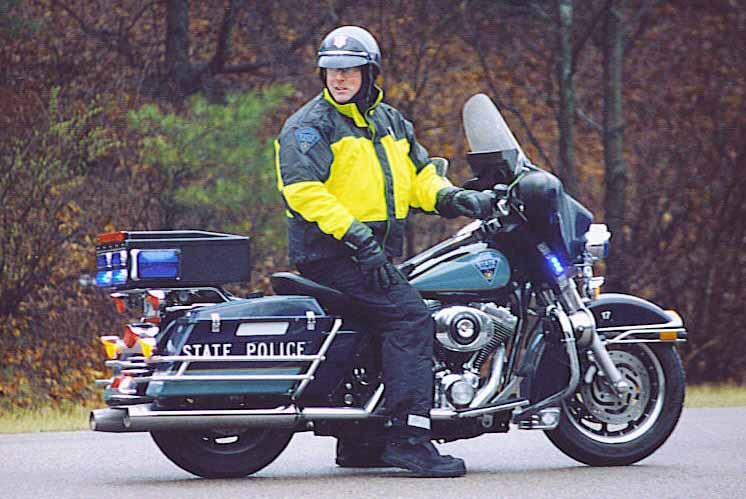
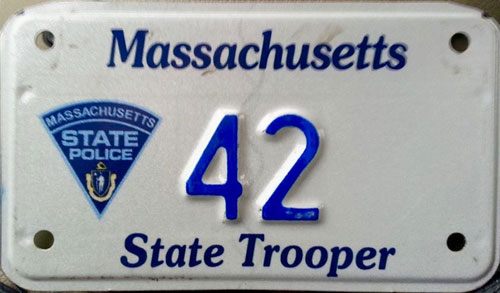 2007-current motorcycle issue.
2007-current motorcycle issue.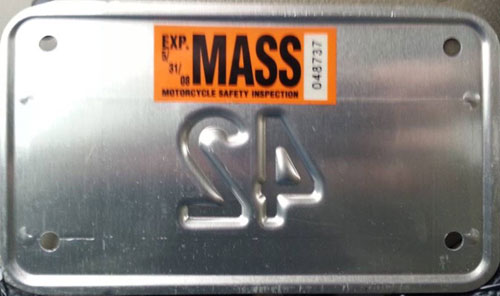 Flip-side of 2007-current motorcycle issue.
Flip-side of 2007-current motorcycle issue.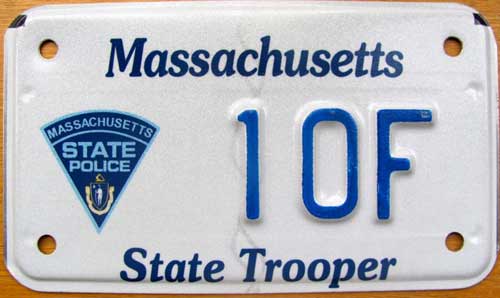 2007-current motorcycle issue.
2007-current motorcycle issue. 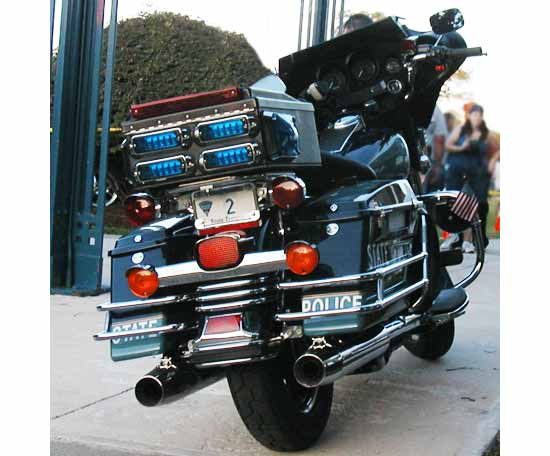
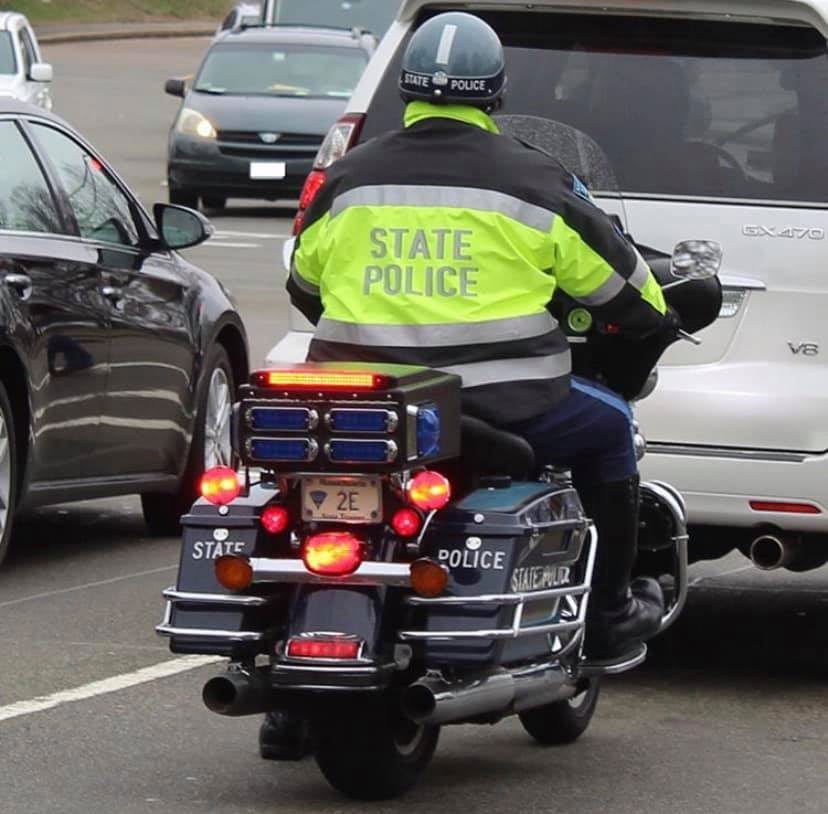 Troop E (Mass. Turnpike)
Troop E (Mass. Turnpike) 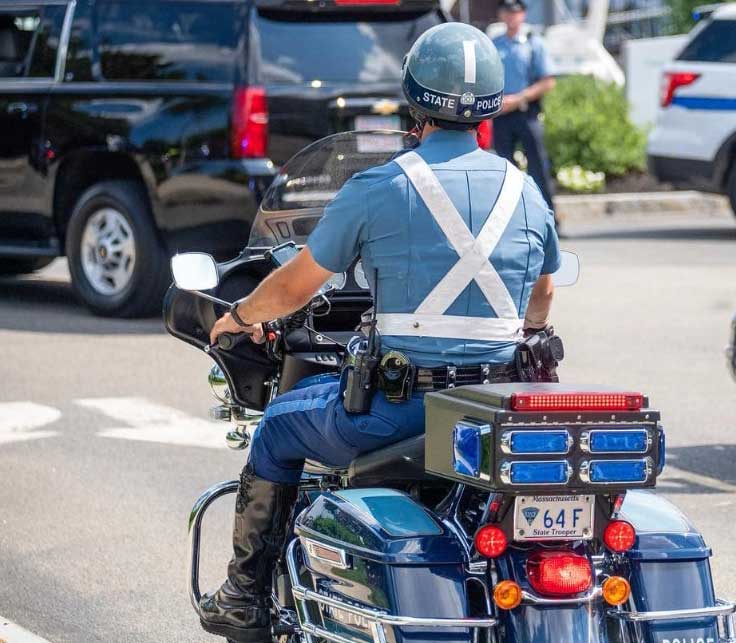 Last of 8 Troop F (Logan Airport) cycles about to be re-assigned to a statewide Motorcycle Unit.
Last of 8 Troop F (Logan Airport) cycles about to be re-assigned to a statewide Motorcycle Unit.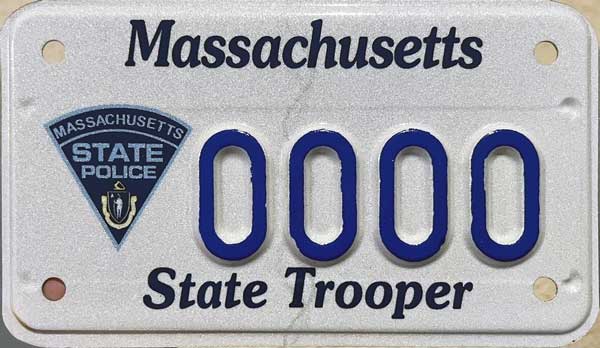 2007-current issue SAMPLE
2007-current issue SAMPLEIn 1992, the former Massachusetts Department of Public Safety - Division of State Police, Massachusetts Registry of Motor Vehicles Police, Massachusetts Capitol Police, and Metropolitan District Commission (MDC) Police (commonly known as the Metropolitan Police) departments merged to form what is currently known as the Department of State Police (an agency within the Executive Office of Public Safety, which is different from the Department of Public Safety). The four former agencies officially ceased to exist on July 1, 1992. The distinctive uniform and seal of the former Division of State Police would be retained by the newly formed Department of State Police. The ranks of Corporal and Staff Sergeant were not carried over into the new agency. The Massachusetts Environmental Police remained a separate entity under the Department of Fisheries, Wildlife, and Environmental Law Enforcement, until it became a separate department level office under the re-organised Executive Office of Energy and Environmental Affairs.
MSP Troop H is broken down here:
H - Troop Did not exist prior to merger. Came into existence with re-alignment of SP and MDC buildings and Barracks to become:
HHQ - South Boston MDC building
H-1 SP Government Ctr (State House) was Capitol PD facility.
H-2 SP Framingham. H-3 SP Foxboro. H-4 SP Boston (MDC). H-5 SP Brighton (MDC). H-6 S. Boston sub-station (MDC)
H-7 SP Milton (MDC)
Each "pre-Consolidation" agency will be reviewed seperately below:
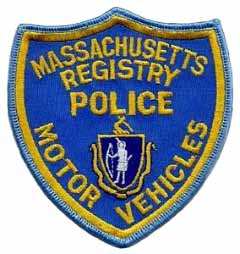 The Massachusetts Registry of Motor Vehicles Police was implemented to address matters of motor vehicle and driver compliance with state vehicle laws. The R.M.V. Police had the primary function of enforcing motor vehicle safety laws statewide, such as for drivers license testing, accident investigation, enforcing laws & regulations on Registry property, and commercial vehicle inspection.
The Massachusetts Registry of Motor Vehicles Police was implemented to address matters of motor vehicle and driver compliance with state vehicle laws. The R.M.V. Police had the primary function of enforcing motor vehicle safety laws statewide, such as for drivers license testing, accident investigation, enforcing laws & regulations on Registry property, and commercial vehicle inspection.
The R.M.V. Police was consolidated along with MDC and Capitol Police into the MSP in 1992.
The R.M.V. Police used distinctive license plates for its fleet of patrol cars and motorcycles since at least 1961.
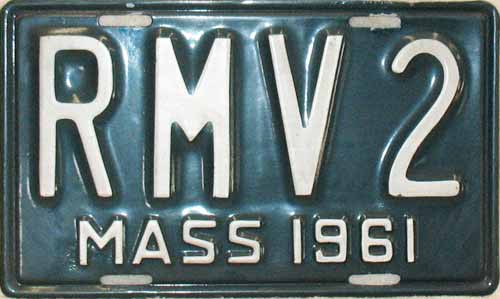 1961-1964 RMV Police Motorcycle issue.
1961-1964 RMV Police Motorcycle issue.
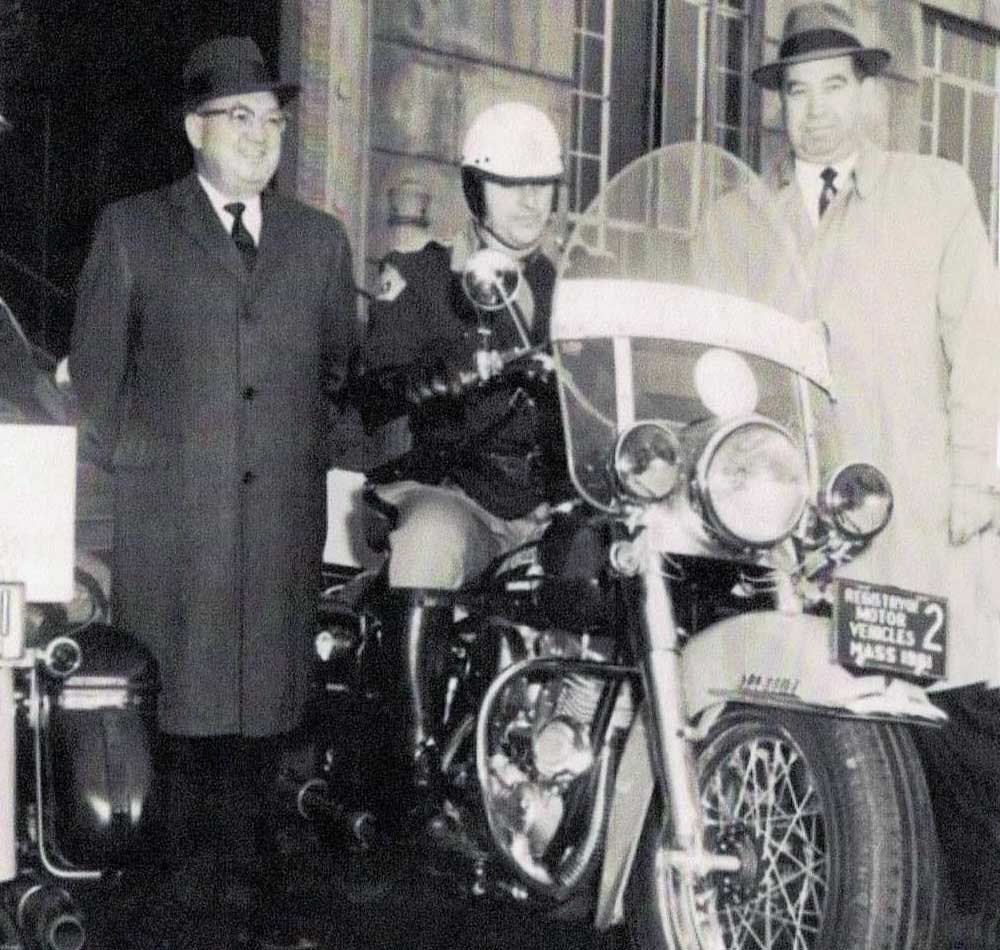 1961
1961 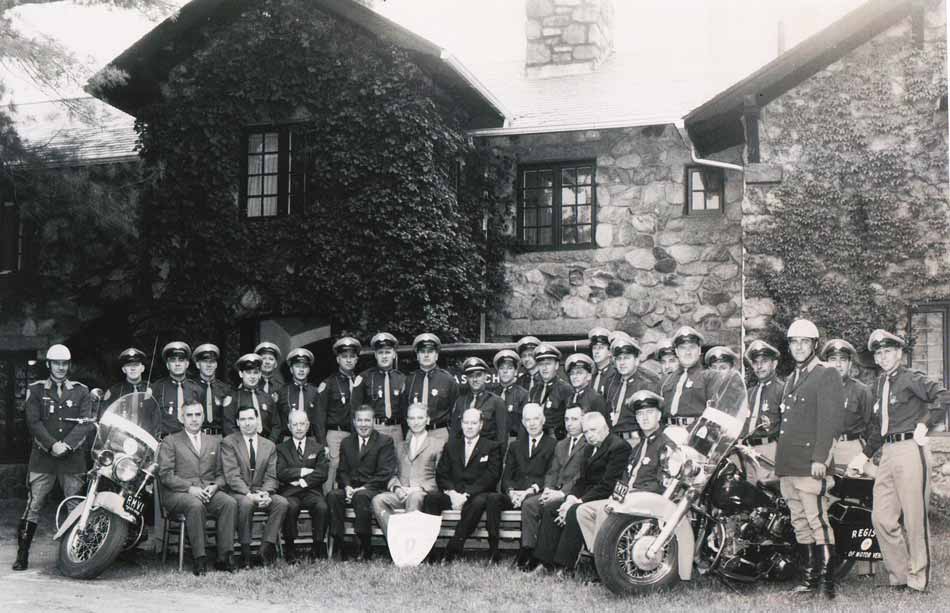 1961
1961 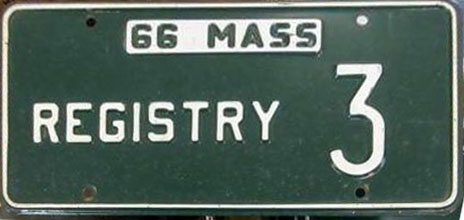 1966 RMV Police issue. Embossed steel.
1966 RMV Police issue. Embossed steel.
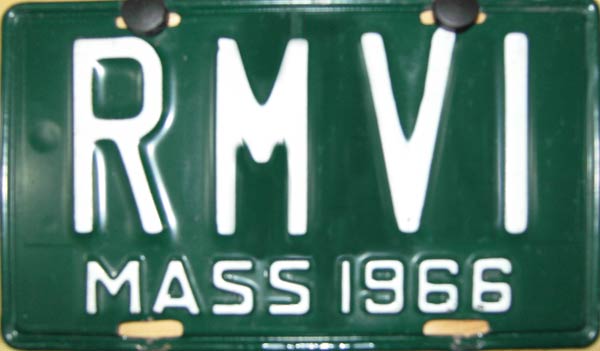 1966 RMV motorcycle issue.
1966 RMV motorcycle issue.
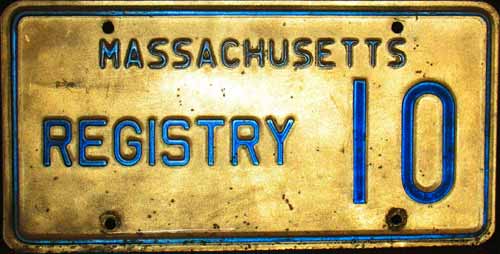 1967-1970 RMV Police issue.
1967-1970 RMV Police issue. 
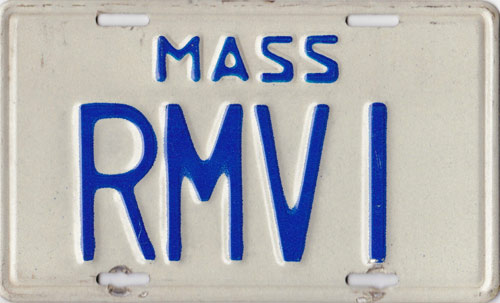 1967-circa 1970 RMV Police issue.
1967-circa 1970 RMV Police issue.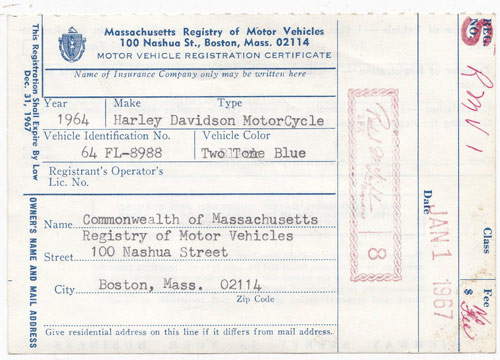 Registration Certificate for RMV 1 cycle plate seen at left.
Registration Certificate for RMV 1 cycle plate seen at left.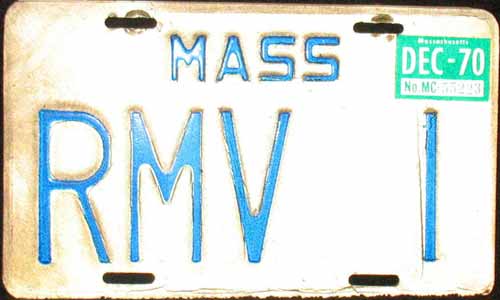 Circa 1967-1970 RMV issue.
Circa 1967-1970 RMV issue.
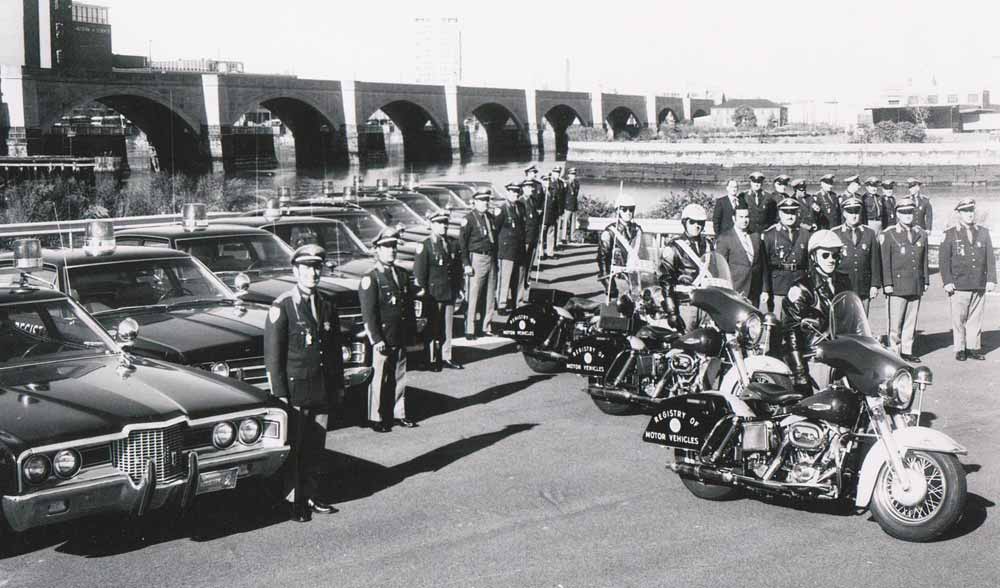 1972 showing white/reflective medium blue Registry license plate on front of Ford LTD.
1972 showing white/reflective medium blue Registry license plate on front of Ford LTD. 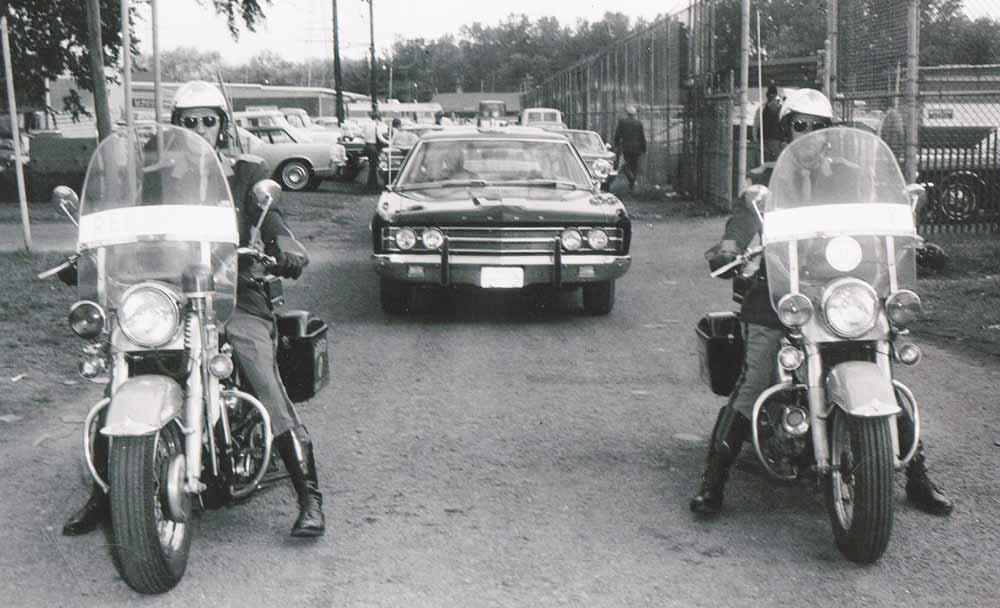 (Courtesy Henry Diorio)
(Courtesy Henry Diorio)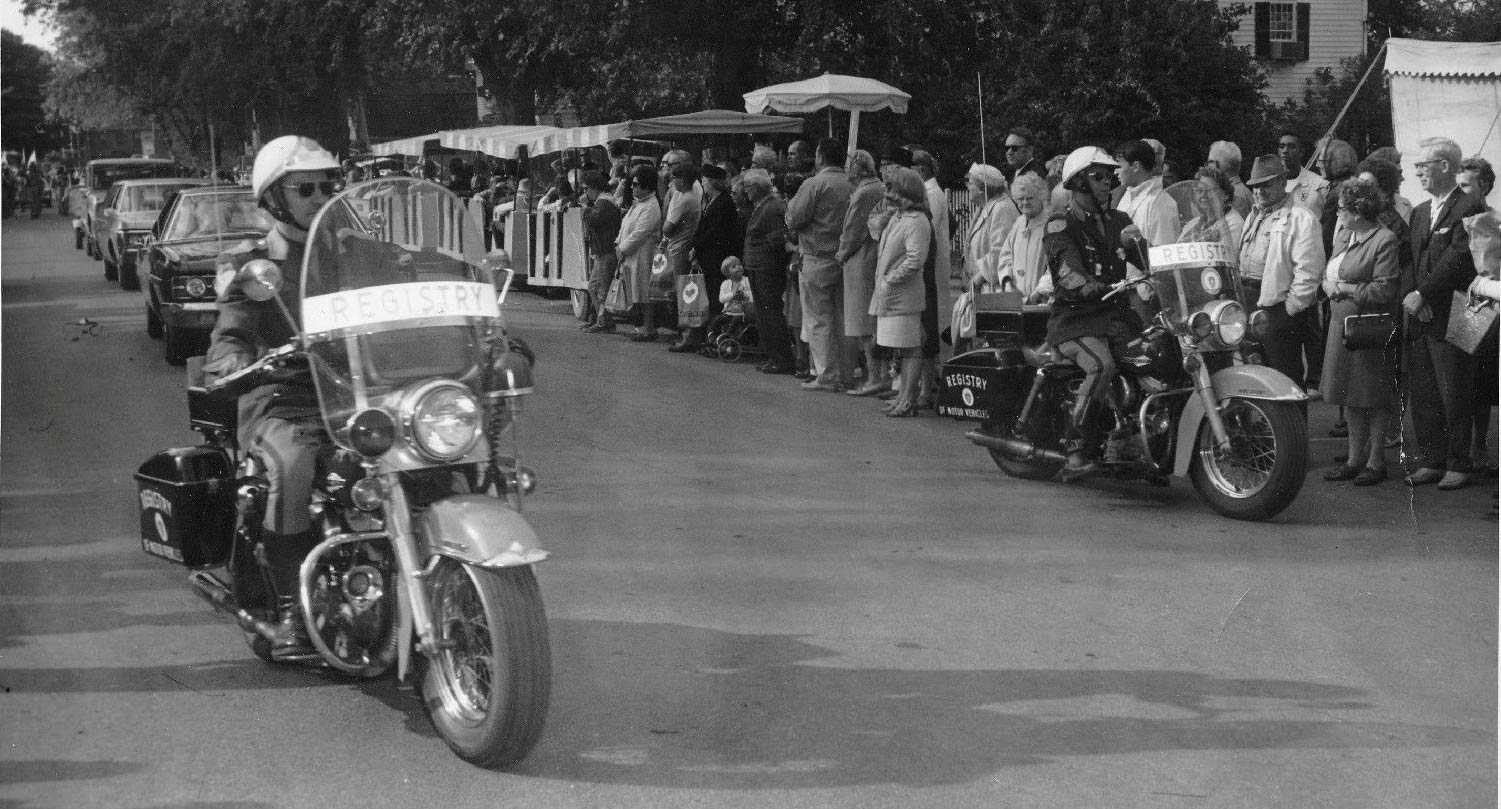
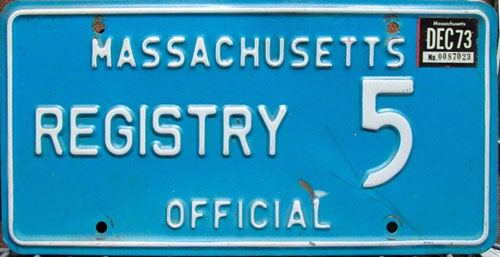 1970-1973 RMV police issue.
1970-1973 RMV police issue.
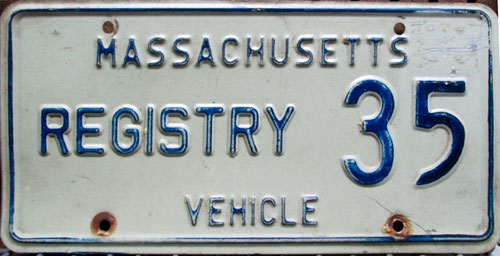 1974-1981 RMV police issue.
1974-1981 RMV police issue.
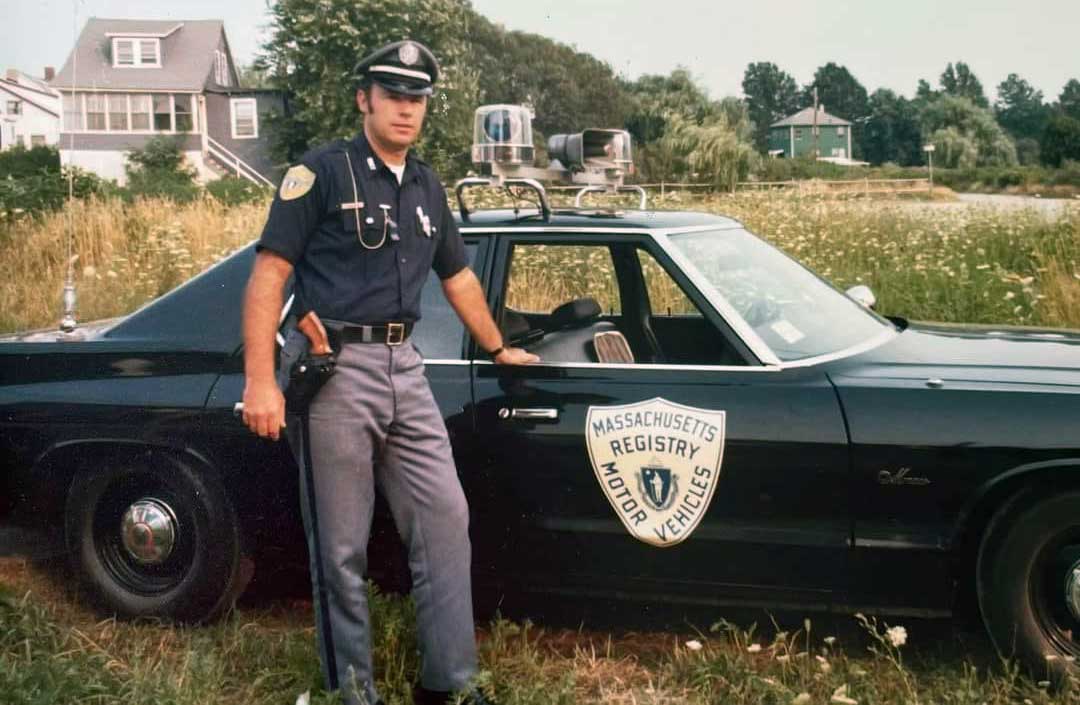 Circa 1975
Circa 1975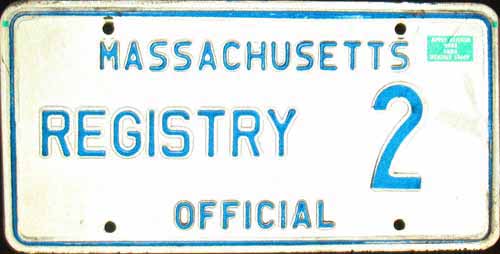 1981-1988 Registry of Motor Vehicles Police issue.
1981-1988 Registry of Motor Vehicles Police issue. 
 1984- Chevy Celebrity
1984- Chevy Celebrity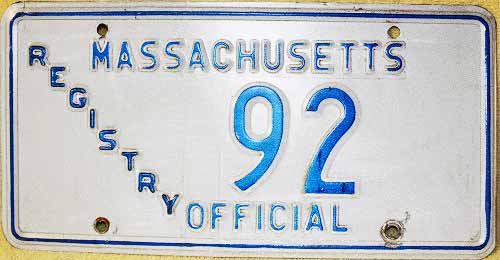 1981-1988 RMV Police issue.
1981-1988 RMV Police issue.
 1981-1988 RMV Police issue
1981-1988 RMV Police issue 1981-1988 RMV Police issue
1981-1988 RMV Police issue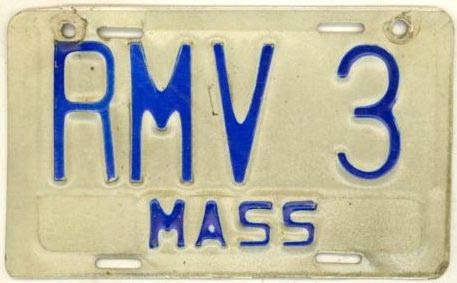 1980's RMV Police motorcycle issue.
1980's RMV Police motorcycle issue..jpg) (Courtesy Jack Murphy)
(Courtesy Jack Murphy)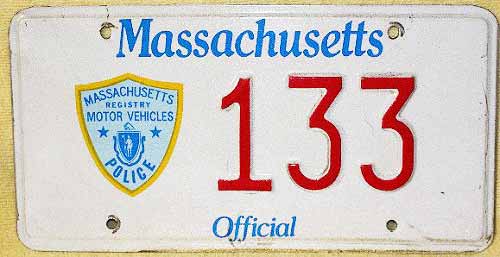 1988-1992 Registry of Motor Vehicles Police issue.
1988-1992 Registry of Motor Vehicles Police issue. Unit 178 In Service 1990
Unit 178 In Service 1990
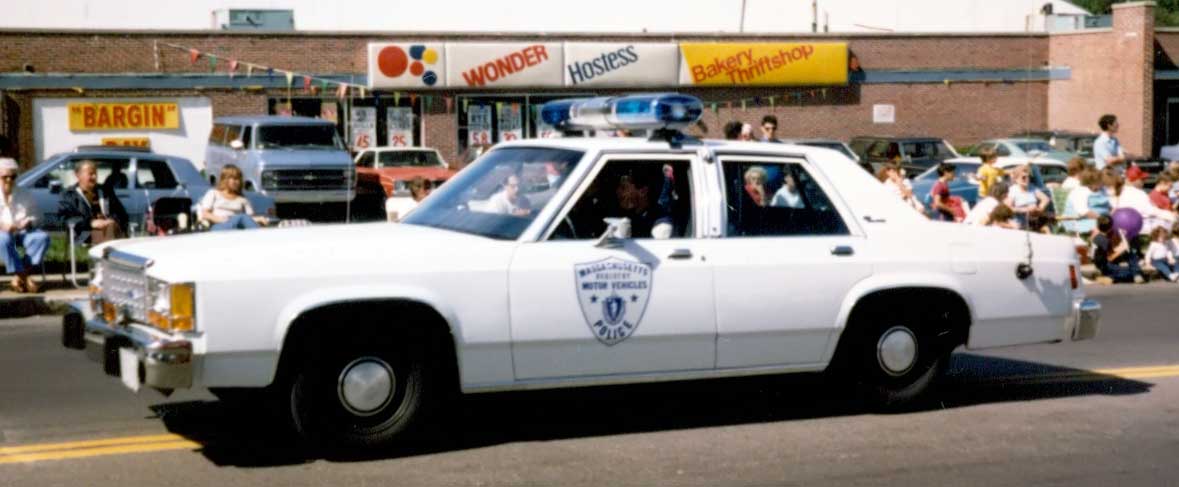 Circa 1987
Circa 1987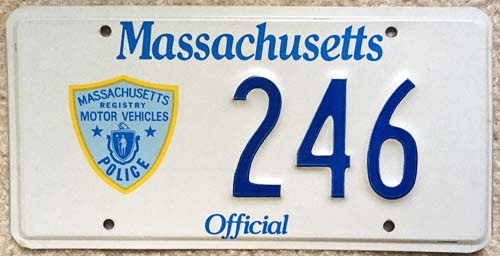 1988-1992 Registry of Motor Vehicles.
1988-1992 Registry of Motor Vehicles.
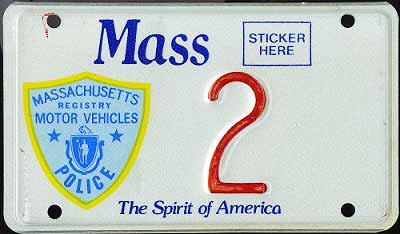 1988-1992 RMV Police motorcycle issue.
1988-1992 RMV Police motorcycle issue.
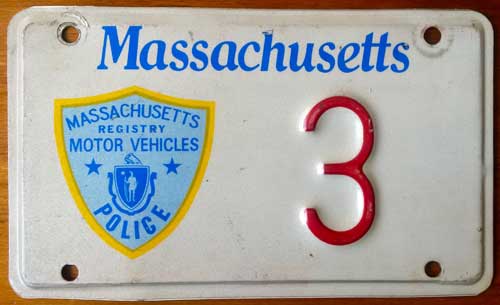 1988-1992 RMV Police motorcycle issue.
1988-1992 RMV Police motorcycle issue.
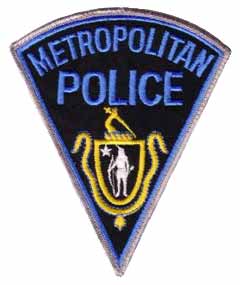 The Metropolitan District Commission's Police Department; the Massachusetts Metro Police was created in 1893. The Metro Police had the primary jurisdiction of law enforcement on all MDC controlled properties, roadways and all Massachusetts Water Resources Authority (MWRA) facilities, Reservoirs and Watersheds. Additionally, the Metro Police had patrol jurisdiction on US Route 1 in Chelsea and Revere, Interstate 93 in Boston and Milton (Central Artery and the Southeast Expressway). The Metro Police also had full jurisdcition with communities throughout Greater Boston.
The Metropolitan District Commission's Police Department; the Massachusetts Metro Police was created in 1893. The Metro Police had the primary jurisdiction of law enforcement on all MDC controlled properties, roadways and all Massachusetts Water Resources Authority (MWRA) facilities, Reservoirs and Watersheds. Additionally, the Metro Police had patrol jurisdiction on US Route 1 in Chelsea and Revere, Interstate 93 in Boston and Milton (Central Artery and the Southeast Expressway). The Metro Police also had full jurisdcition with communities throughout Greater Boston.
The Metro Police were the third largest police agency in New England with over six hundred officers working primarily throughout Metropolitan Boston. In addition to patrol functions the Metro Police provided tactical assistance to area cities and towns in the form of regional SWAT teams, the Marine Unit and tactical operations units. Examples include Tactical Officers assigned to the city of Boston during court ordered school desegregation, assignment as the primary security agency for the Department of State with the responsibility of providing security and escorts for visiting dignitaries and annual assignments to assist cities and towns during the Boston Marathon.
The Metro Police also maintained a full service detective unit to investigate crimes on its primary jurisdiction as well as providing Detectives and undercover agents to area cities and towns,area Drug Task Forces, the state Auto Theft Strike Force, the DEA Boston Drug Task Force, the Secret Service and the FBI.
The last chief of the MDC Police was former Boston Police Commissioner William J. Bratton, who later was NYPD Commissioner and Los Angeles Police Department chief.
The following current Massachusetts State Police Barracks were MDC Police districts: MSP Barracks A4 - Medford (Middlesex Fells District); MSP Barracks A5 - Revere (Revere Beach); MSP Barracks H4 - Boston, next to Museum of Science (Lower Basin District); MSP Barracks H5 - Brighton on Soldier's Field Rd (Upper Basin District); MSP Barracks H6 - South Boston (Old Colony District); MSP H7 - Milton (Blue Hills District); MSP Barracks C7 - Belchertown (Quabbin District).
Additionally, the following State Police Units are based out of former MDC Police facilities:
MSP Marine Unit (New Charles River Dam, Boston); MSP Canine Unit (Pond St., Stoneham).
The following former MDC police stations were closed in the first few years after the consolidation: Wachusett District (Wachusett and Sudbury Reservoirs and Watersheds); Nantasket Beach District (Nantasket Beach, Hull); Nahant Beach Substation (Nahant Beach); Mounted Unit Stables (Stoneham and Milton).
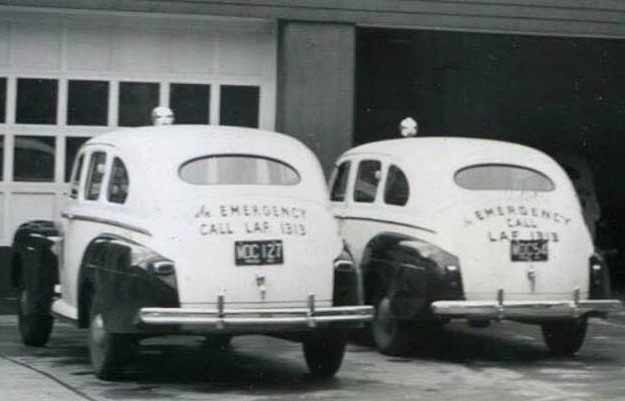 (Courtesy Brian Dunn)
(Courtesy Brian Dunn)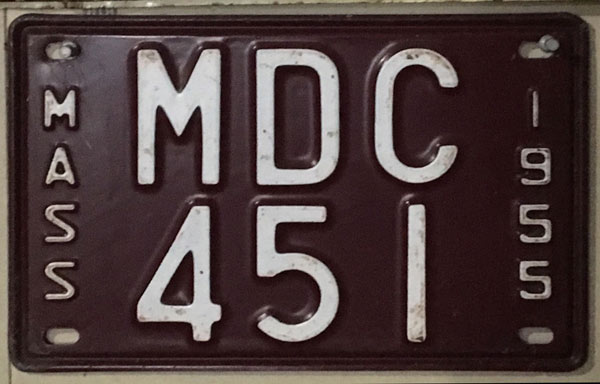 1955 MDC issue. Embossed steel.
1955 MDC issue. Embossed steel.
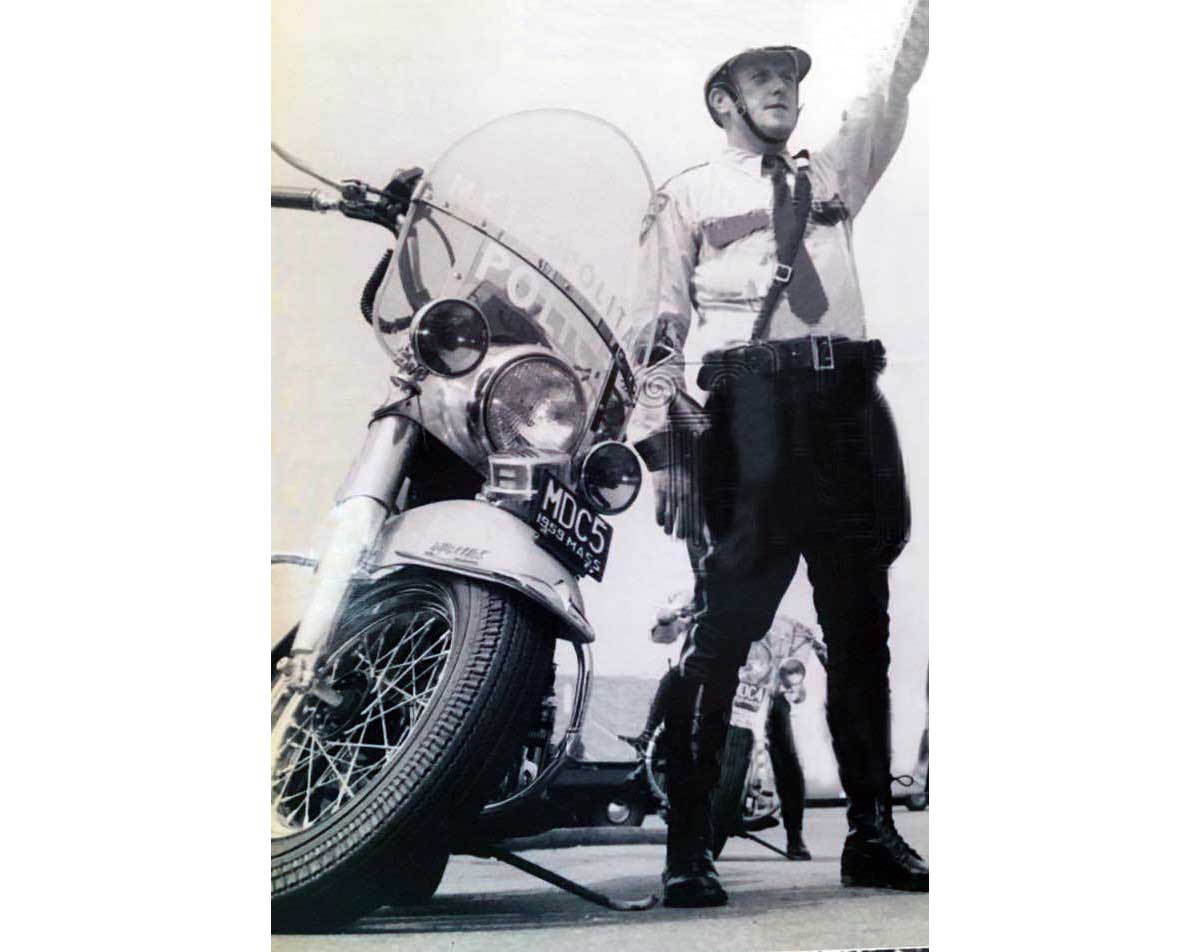 1959
1959 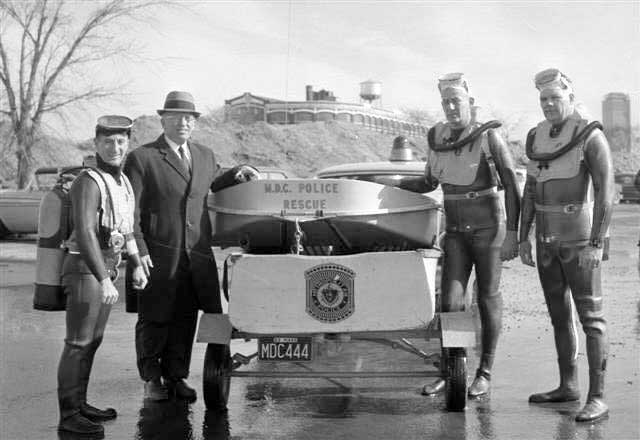 1959
1959 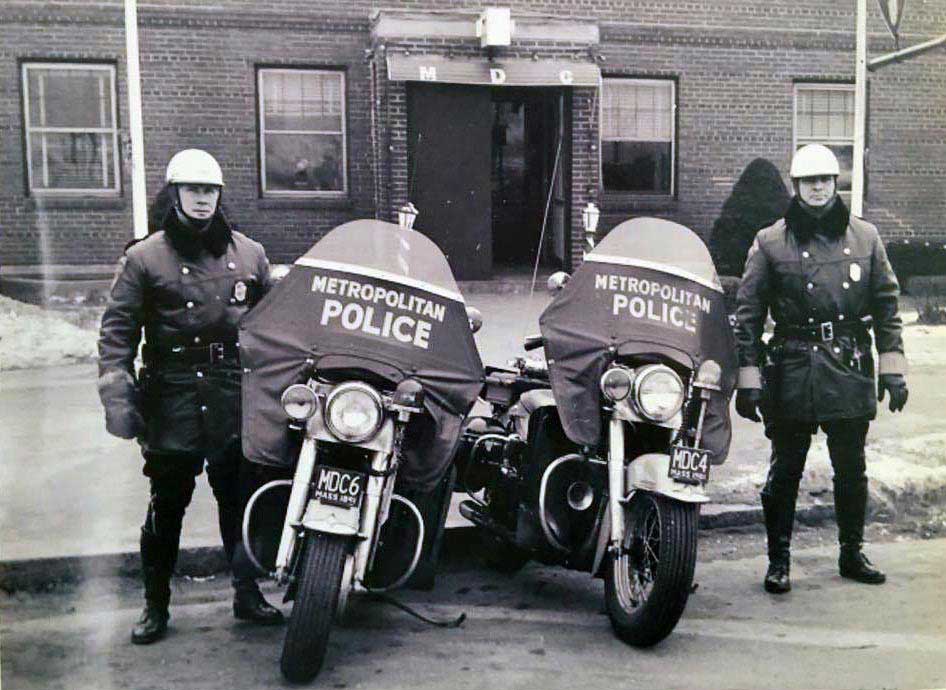 (Courtesy Brian Dunn)
(Courtesy Brian Dunn)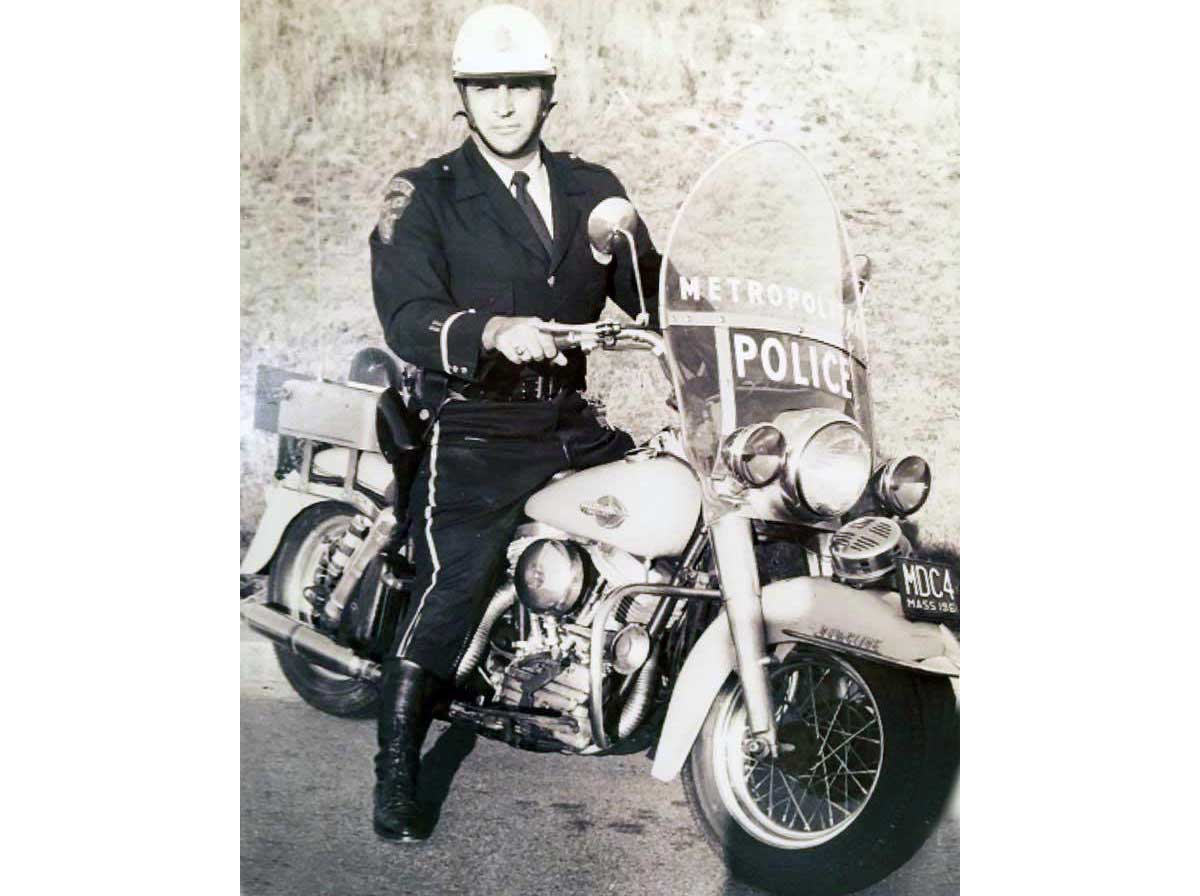 (Courtesy Brian Dunn)
(Courtesy Brian Dunn)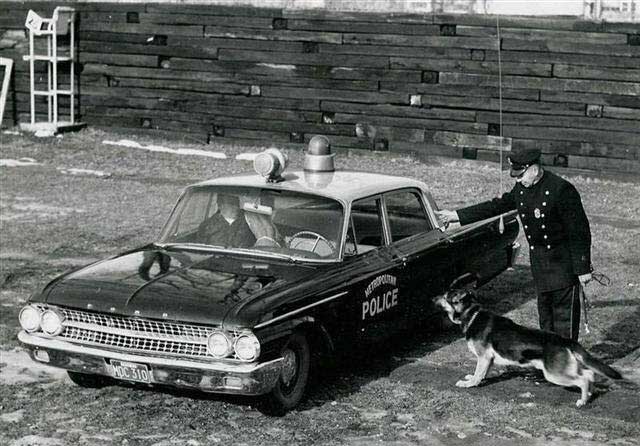 (Courtesy Brian Dunn)
(Courtesy Brian Dunn)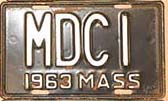 1963 MDC Police motorcycle issue.
1963 MDC Police motorcycle issue.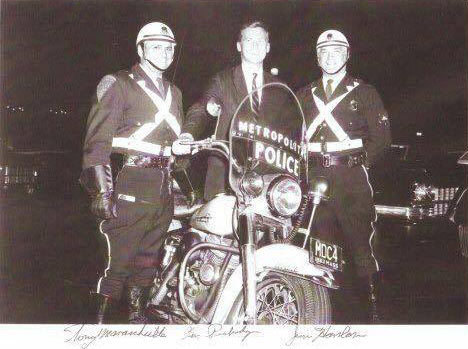 (Courtesy Brian Dunn)
(Courtesy Brian Dunn)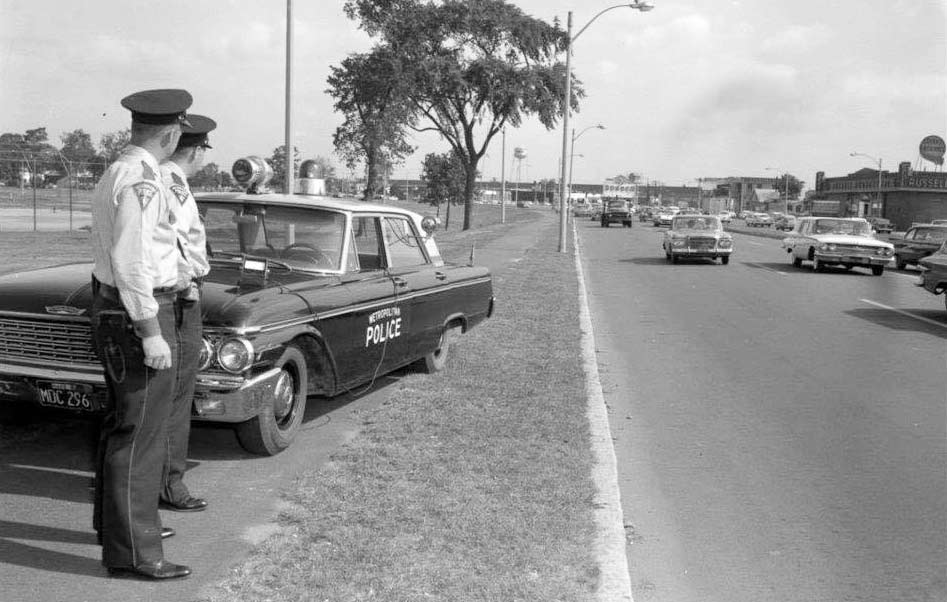 (Courtesy Brian Dunn)
(Courtesy Brian Dunn)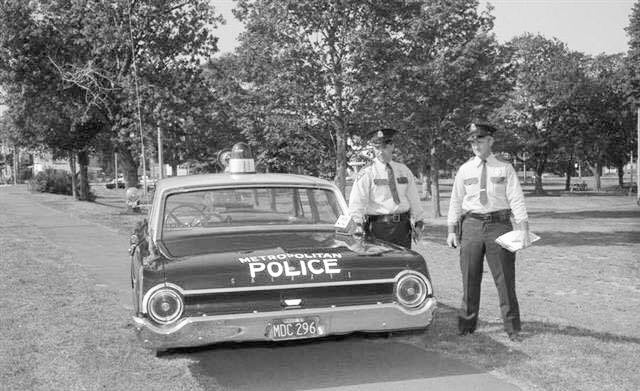 (Courtesy Brian Dunn)
(Courtesy Brian Dunn) (Courtesy Paul Peterson)
(Courtesy Paul Peterson)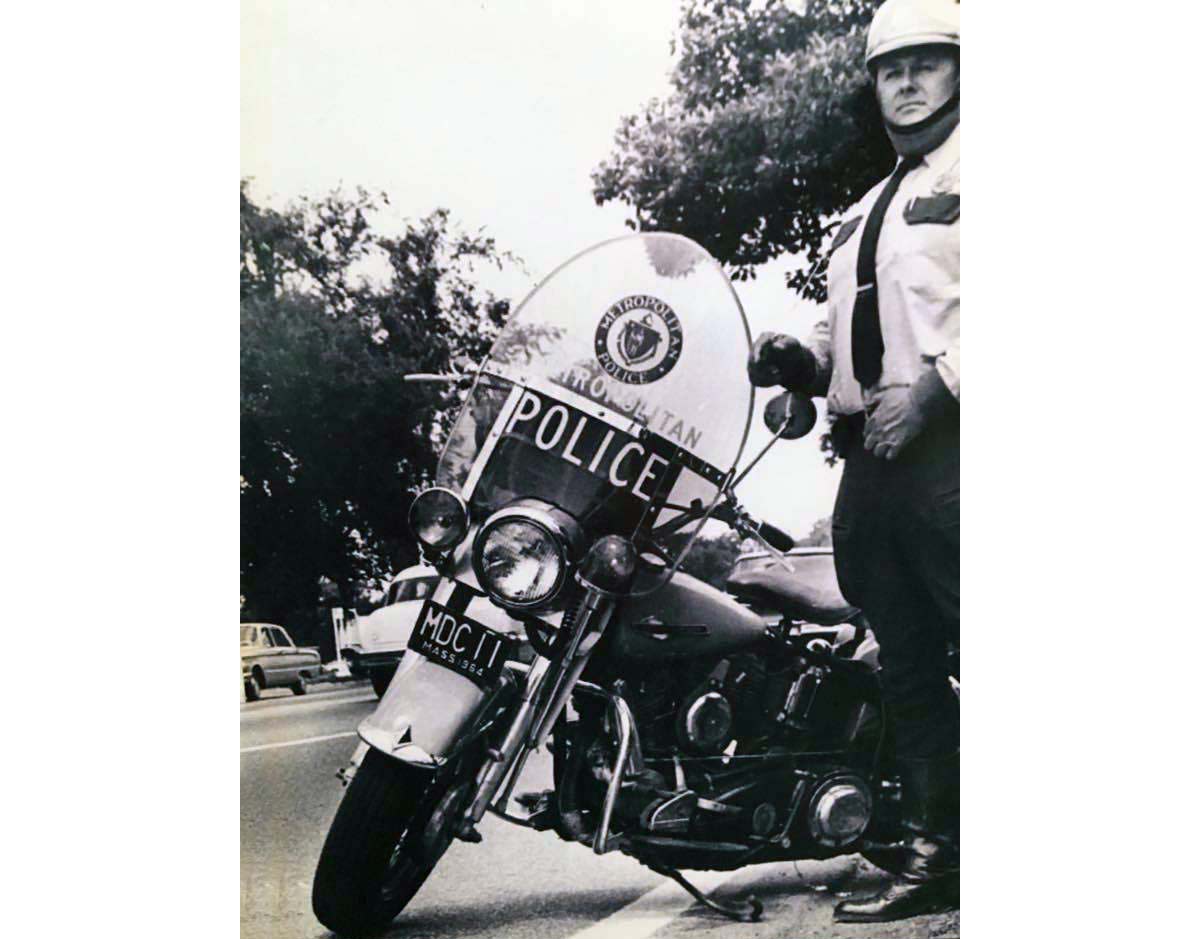 (Courtesy Brian Dunn)
(Courtesy Brian Dunn)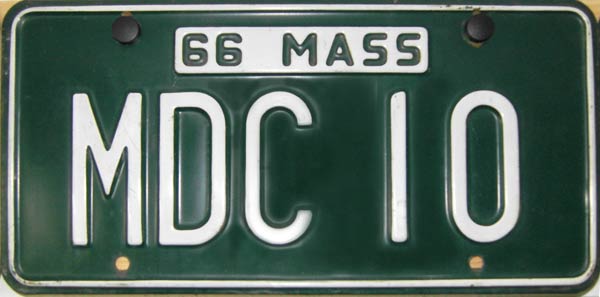 1966 MDC Police issue.
1966 MDC Police issue.
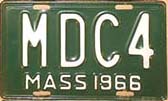 1966 MDC Police motorcycle issue.
1966 MDC Police motorcycle issue.
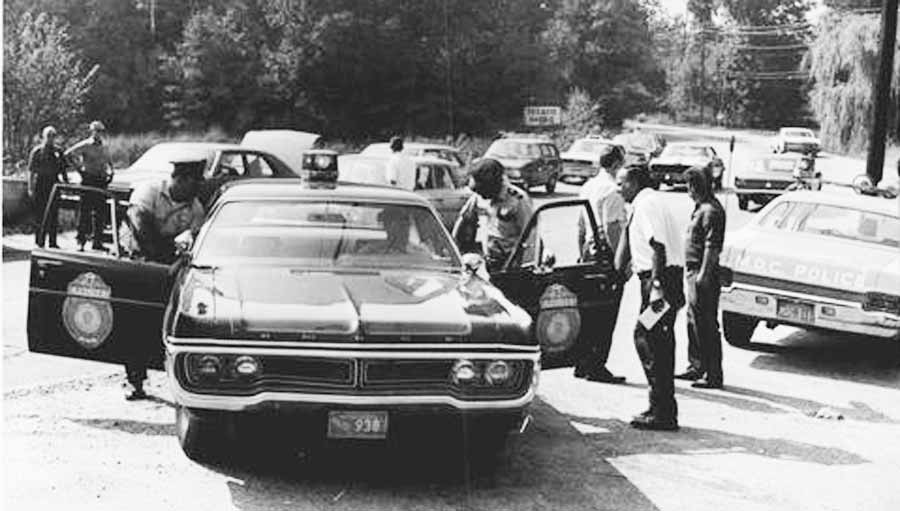
Circa 1971- MDC Police vehicle seen to the far right. Embossed aluminum license plate with white characters over a reflective medium blue background. MASSACHUSETTS at top of the plate over MDC prefix followed by three numbers over OFFICIAL embossed at bottom center of the plate.
 1970-1973 MDC Police issue.
1970-1973 MDC Police issue.
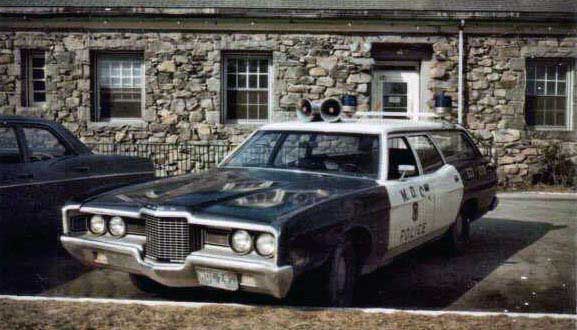 (Courtesy Brian Dunn)
(Courtesy Brian Dunn)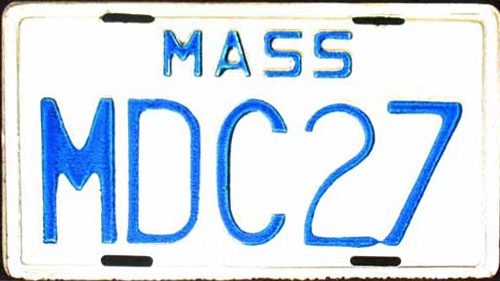 1974- Circa 1983 MDC Police motorcycle issue.
1974- Circa 1983 MDC Police motorcycle issue. 
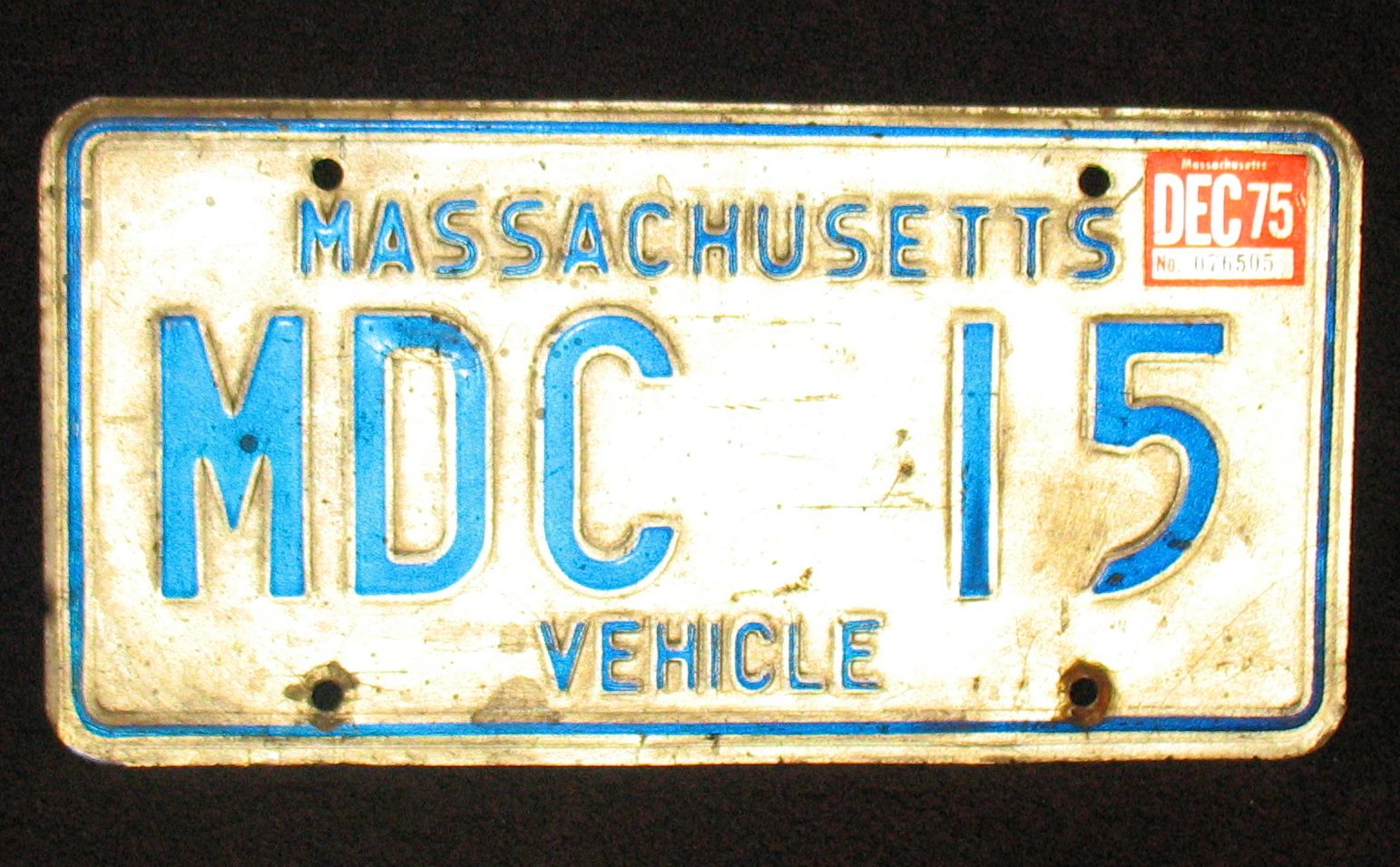 1974- 1981 MDC Police issue.
1974- 1981 MDC Police issue. 
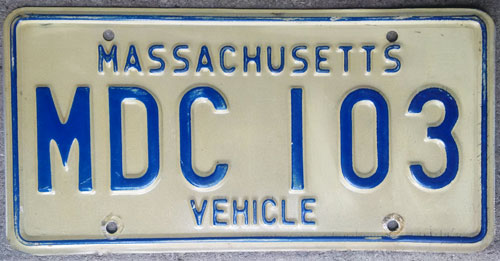 1974- 1981 MDC Police issue.
1974- 1981 MDC Police issue. 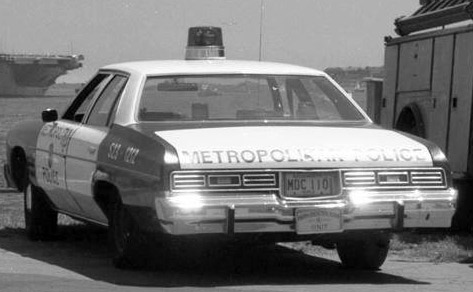
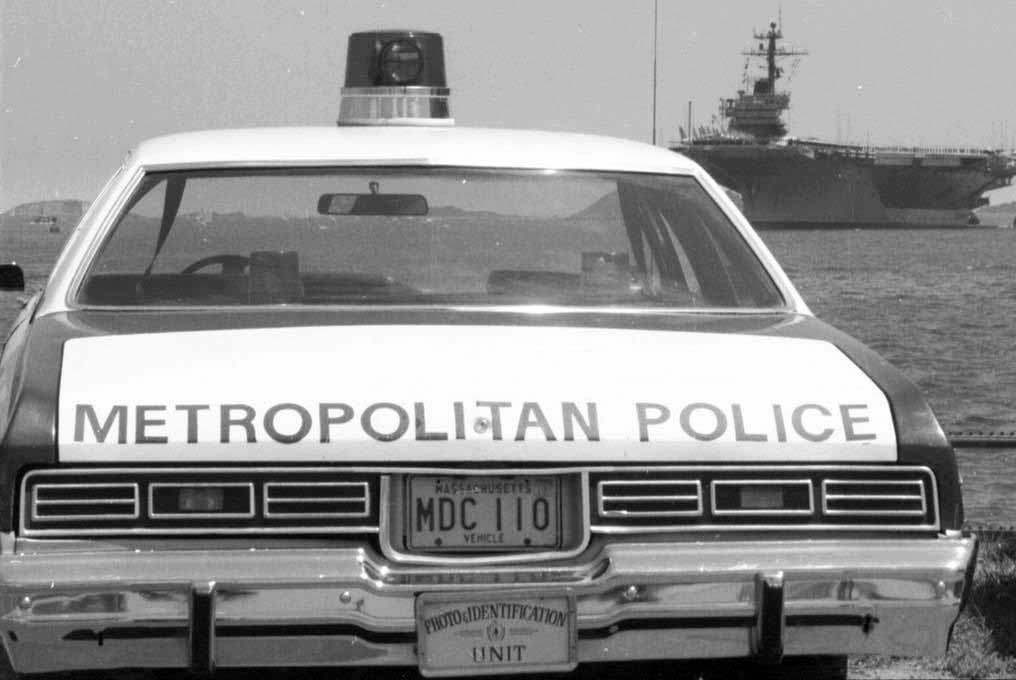
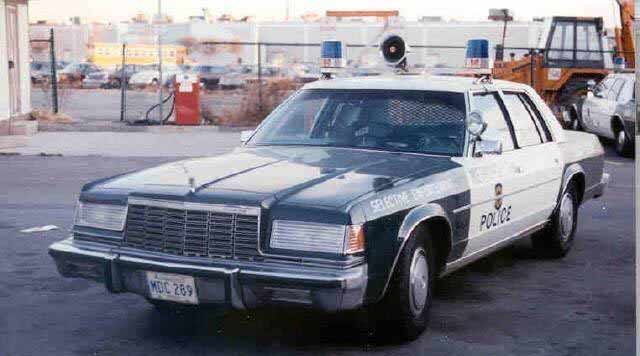
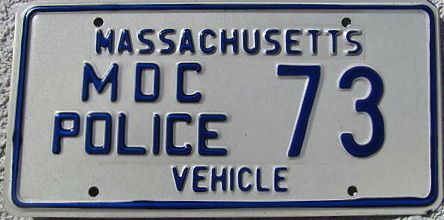 1974- 1983 MDC Police issue. Type used just prior to introduction of METRO POLICE base plate.
1974- 1983 MDC Police issue. Type used just prior to introduction of METRO POLICE base plate.
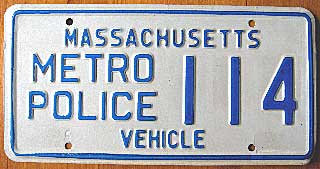 1984- Circa 1988 MDC Police issue. Type used just prior to introduction of OFFICIAL designation at bottom center base plate.
1984- Circa 1988 MDC Police issue. Type used just prior to introduction of OFFICIAL designation at bottom center base plate. 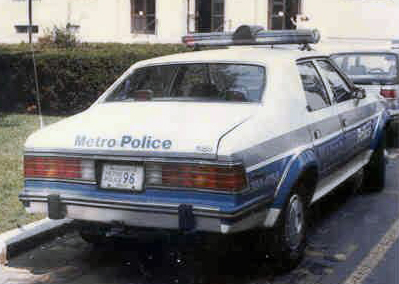 MDC Police AMC Eagle
MDC Police AMC Eagle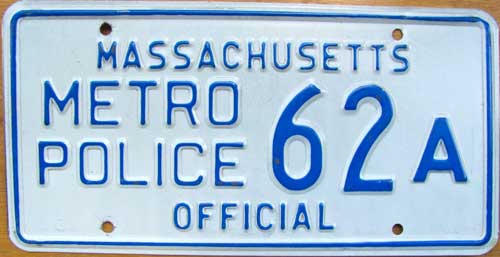 Circa 1988- 1992 Metropolitan District Commission Police issue for "AM Car". Type used just prior to consolidation with Massachusetts State Police.
Circa 1988- 1992 Metropolitan District Commission Police issue for "AM Car". Type used just prior to consolidation with Massachusetts State Police. 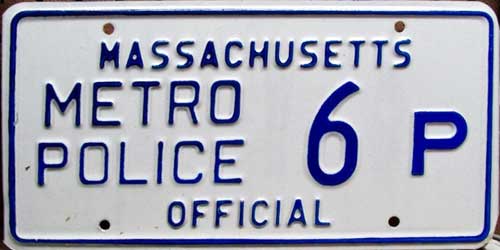 Circa 1988- 1992 Metropolitan District Commission Police issue for "PM Car". Type used just prior to consolidation with Massachusetts State Police.
Circa 1988- 1992 Metropolitan District Commission Police issue for "PM Car". Type used just prior to consolidation with Massachusetts State Police.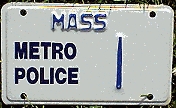 1984- 1992 MDC Police Motorcycle issue.
1984- 1992 MDC Police Motorcycle issue. 
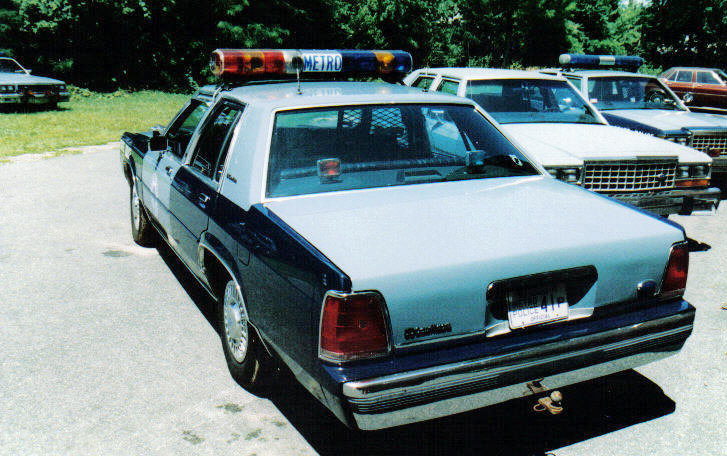 "PM Car"
"PM Car" 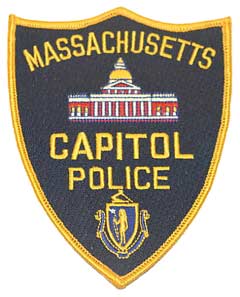 The Capitol Police had the primary function of law enforcement on the grounds and adjacent streets of the State Capitol and all state property. The Capitol police provided vehicle cruiser, motorcycle and traffic patrols, criminal investigations and executive protection services. The Capitol Police station was at 1 Ashburton Place in Government Center and became MSP Barracks H-1.
The Capitol Police had the primary function of law enforcement on the grounds and adjacent streets of the State Capitol and all state property. The Capitol police provided vehicle cruiser, motorcycle and traffic patrols, criminal investigations and executive protection services. The Capitol Police station was at 1 Ashburton Place in Government Center and became MSP Barracks H-1.
As for license plate issuance for this agaency, the only information known is the following: Capitol Police licensed plates issued in the 1960s. Not known if these were on the old steel green or maroon base plates or the blue over reflective white aluminum base plate. These were used for vehicles which patrolled the streets around the State House. The plates had the state name at the top with CAPITOL over POLICE followed by a single digit number. During the 1970's and up to 1987, patrol vehicles used by the State Capitol Police used standard Massacusetts State Vehicle license plates. In May of 1987, a reflective white license plate with dark blue characters replaced the State Vehicle plates for this small fleet. The state name was spelled out in full at the top of the plates and the words CAPITOL over POLICE were silkscreened to the left of an embossed number.
These plates would have been defunct with the consolidation of the Capitol Police into the Massachusetts State Police.
Any photograph of a Massachusetts Capitol Police license plate would be gretly appreciated.
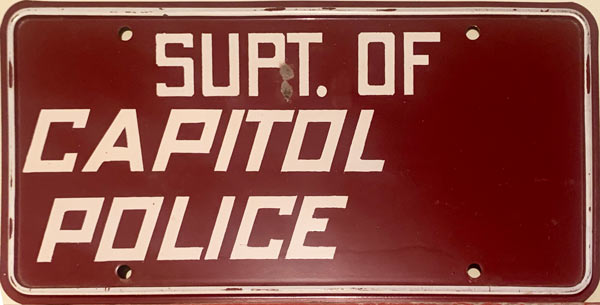 Circa 1964 Superintendent of Massachusetts Capitol Police.
Circa 1964 Superintendent of Massachusetts Capitol Police.
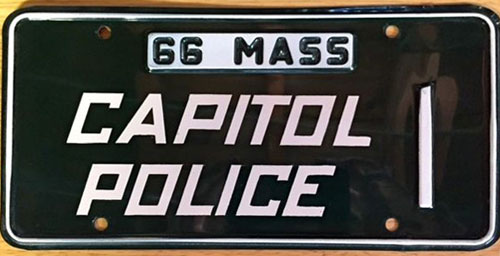 1966 Capitol Police Chief issue.
1966 Capitol Police Chief issue.
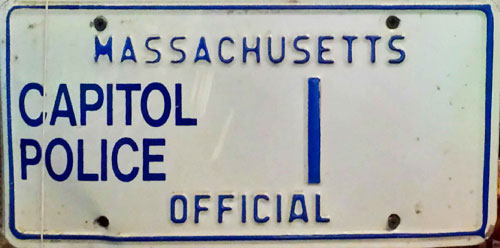 Circa 1981-1988 Capitol Police Chief issue.
Circa 1981-1988 Capitol Police Chief issue.
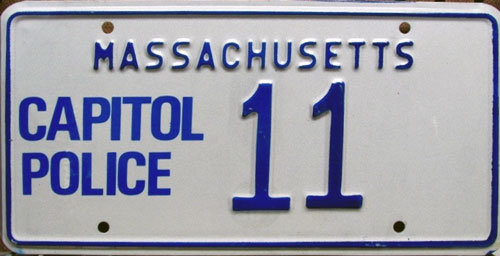 Circa 1990 Capitol Police issue.
Circa 1990 Capitol Police issue.
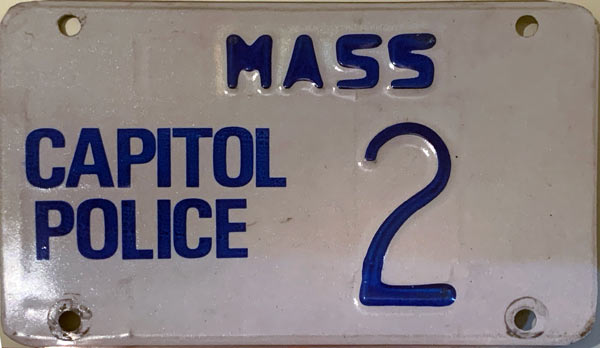 C.1988-1990's Capitol Police Motorcycle issue.
C.1988-1990's Capitol Police Motorcycle issue.
As with many other SP-HP agencies, the Massachusetts State Police also issued special "non duty" license plates made on proper MSP blanks and other types. Here are some examples.
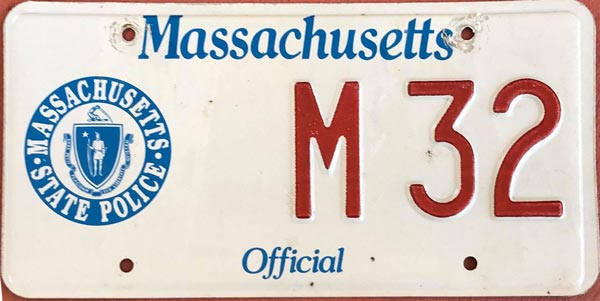 1989-2007 issue with M prefix used as moorinng/dock marker for MSP Marine Unit
1989-2007 issue with M prefix used as moorinng/dock marker for MSP Marine Unit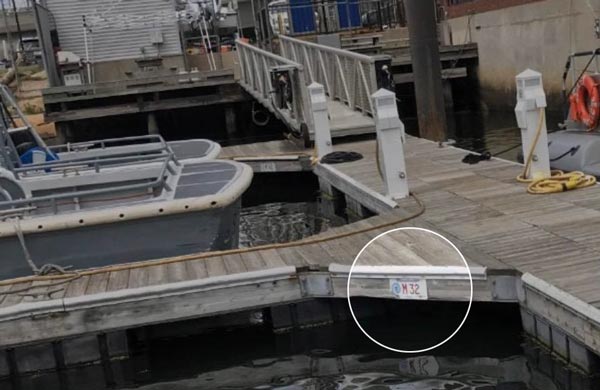
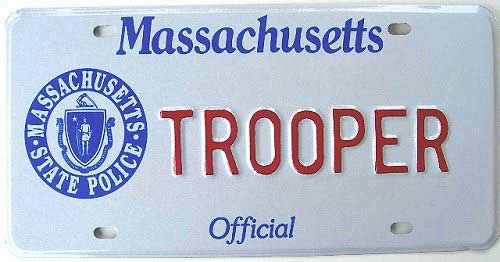 Embossed TROOPER "booster" license plate.
Embossed TROOPER "booster" license plate. 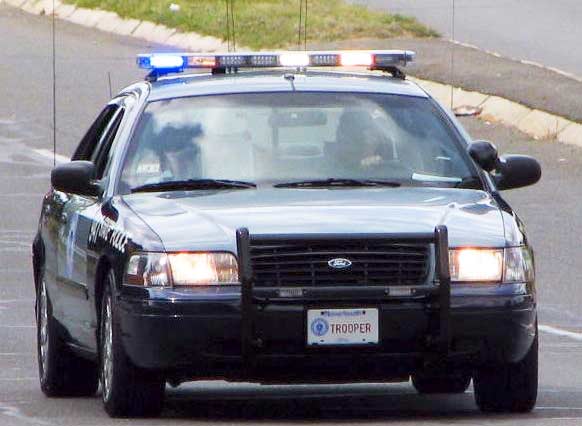
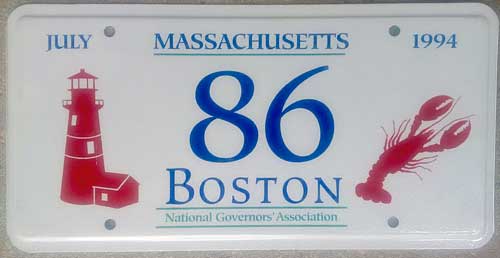 July 1994 National Governors' Association conference plate.
July 1994 National Governors' Association conference plate.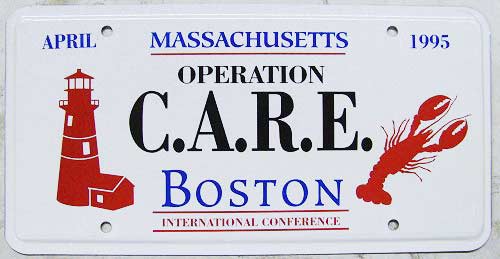 April 1995 Combined Accident Reduction Effort conference which was hosted by the MSP that year. These souvenir license plates were issued to attending delegates.
April 1995 Combined Accident Reduction Effort conference which was hosted by the MSP that year. These souvenir license plates were issued to attending delegates.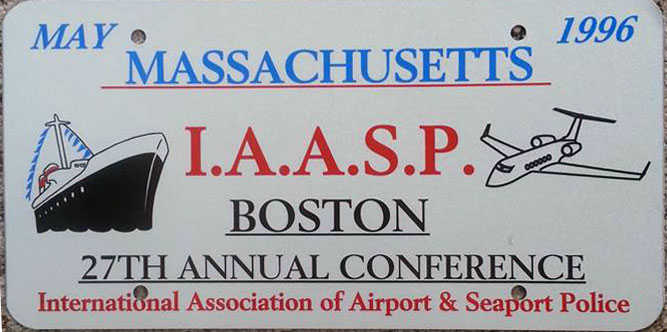 May 1996 International Association of Airport & Seaport Police conference souvenir plate.
May 1996 International Association of Airport & Seaport Police conference souvenir plate.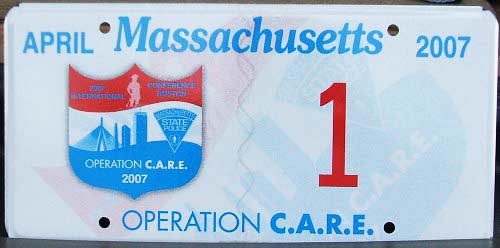 April 2007 Combined Accident Reduction Effort conference which was hosted by the MSP that year. These numbered souvenir license plates were issued to attending delegates.
April 2007 Combined Accident Reduction Effort conference which was hosted by the MSP that year. These numbered souvenir license plates were issued to attending delegates.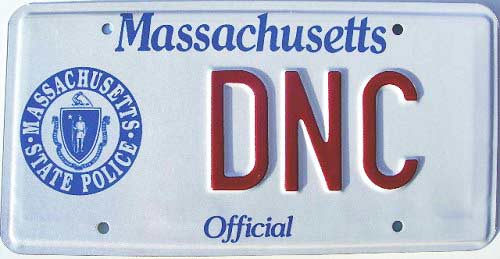 Issued as souvenir to MSP personnel assigned to the Democratic National Congress Leadership Convention in Boston 2004.
Issued as souvenir to MSP personnel assigned to the Democratic National Congress Leadership Convention in Boston 2004.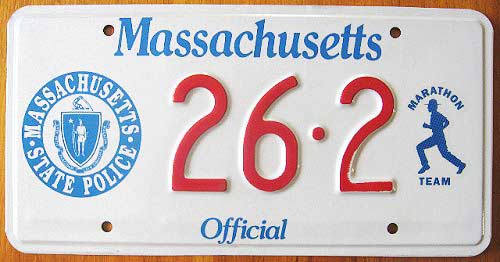 Issued as souvenir to MSP personnel belonging to the MSP Boston Marathon Team.
Issued as souvenir to MSP personnel belonging to the MSP Boston Marathon Team. 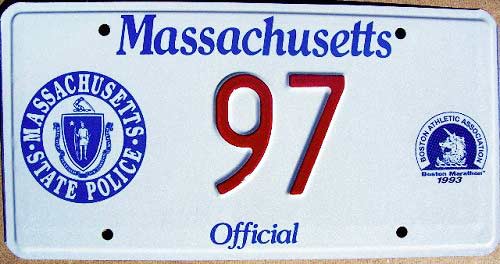 Issued in 1993 as a souvenir to MSP personnel who participated in the 97th running of the Boston Marathon.
Issued in 1993 as a souvenir to MSP personnel who participated in the 97th running of the Boston Marathon.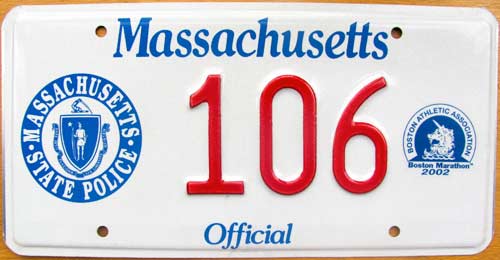 Issued in 2002 as a souvenir to MSP personnel who participated in the 106th running of the Boston Marathon.
Issued in 2002 as a souvenir to MSP personnel who participated in the 106th running of the Boston Marathon.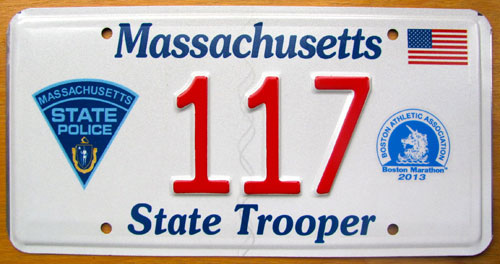 Issued in 2013 as a souvenir to MSP personnel who participated in the 117th running of the Boston Marathon.
Issued in 2013 as a souvenir to MSP personnel who participated in the 117th running of the Boston Marathon. Old MSP Chaplain plate. Flat painted.
Old MSP Chaplain plate. Flat painted.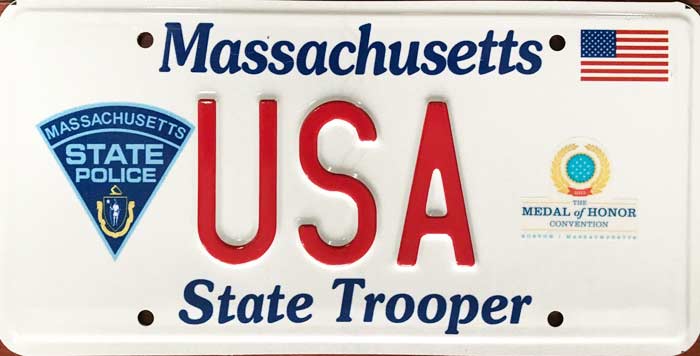 Issued for US Army Recipient for the 2015 US Medal of Honor Convention (Boston)
Issued for US Army Recipient for the 2015 US Medal of Honor Convention (Boston)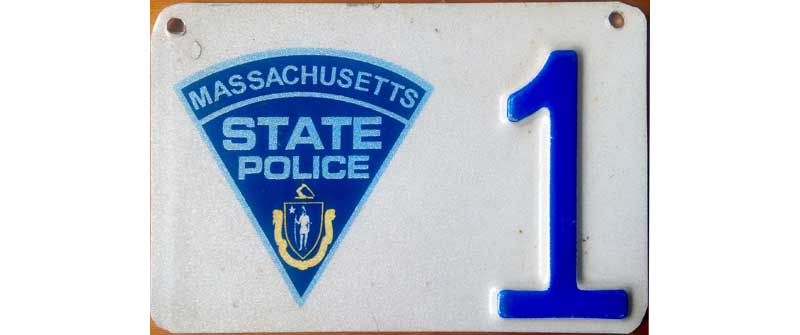 Custom license plate made by MSP mechanic Jim Aitken for use on MSP bicycle patrols along Charles River during 4th of July weekends. Made from older MSP license plate turn-ins.
Custom license plate made by MSP mechanic Jim Aitken for use on MSP bicycle patrols along Charles River during 4th of July weekends. Made from older MSP license plate turn-ins.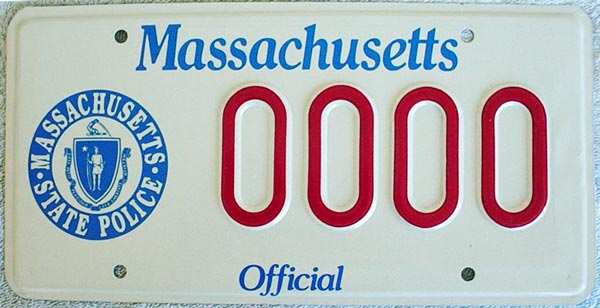 1989-2007 issue SAMPLE with four zeroes
1989-2007 issue SAMPLE with four zeroes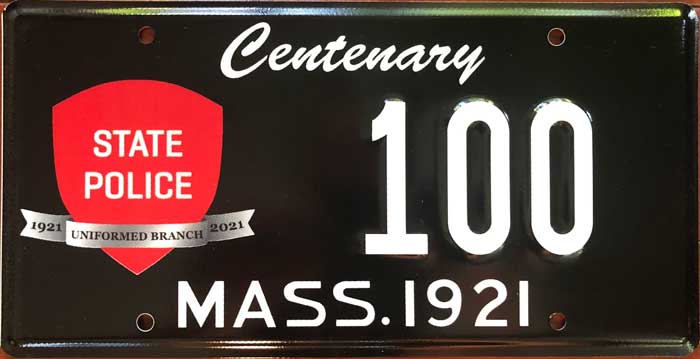 Special order MSP Centennial souvenir plate.
Special order MSP Centennial souvenir plate.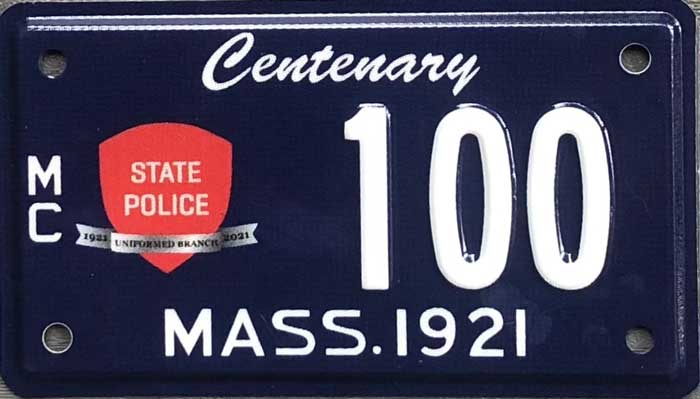 Special order MSP Centennial motorcycle souvenir plate.
Special order MSP Centennial motorcycle souvenir plate.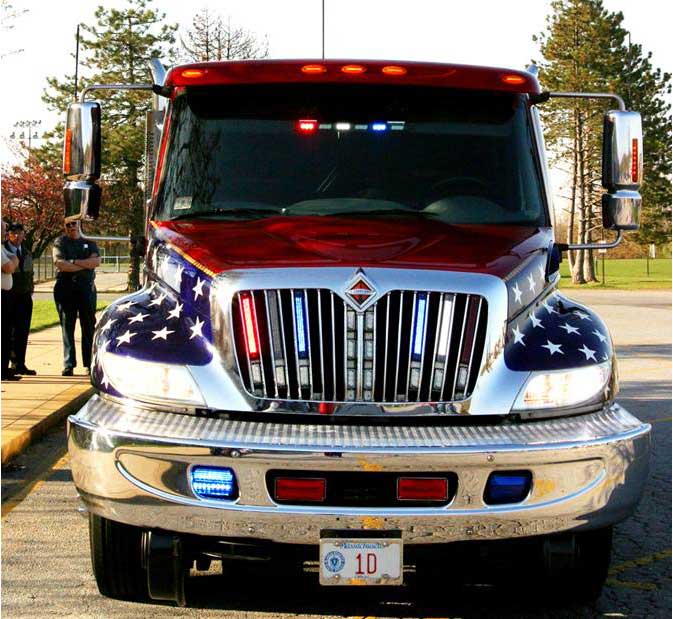 For 30-years the National Flag Truck has been one of the most honored vehicles in the United States. It has carried the National Flags to almost every state and to many countries. In the past it has been on the road 300-days a year and on call 24-hours a day. This specially designed and identified rig under the U.S.D.O.T. is used in all areas of the United States Government for Special Operations. These flags have been exhibited for the President of the United States or for special events throughout the world. Since 9/11 they have not been allowed outside of the continental United States.
For 30-years the National Flag Truck has been one of the most honored vehicles in the United States. It has carried the National Flags to almost every state and to many countries. In the past it has been on the road 300-days a year and on call 24-hours a day. This specially designed and identified rig under the U.S.D.O.T. is used in all areas of the United States Government for Special Operations. These flags have been exhibited for the President of the United States or for special events throughout the world. Since 9/11 they have not been allowed outside of the continental United States.
Donated by International Truck and Engine, this International 4400 Crew Cab fitted with a Century 20 Series steel carrier bed and a dazzling array of Whelen Engineering lights, carries our countries national treasures, transports an historic collection of 21-90 foot 300lbs flags and is used as an "Official Caisson". With no government or tax payer money involved, the truck was kept rolling by a small band of patriots and distinguished companies. The actual flags are carried in a commemorative Chest Of Flags made with cherry wood from every county in Plymouth, MA. Since the recession of 2010 there have not been enough funds to fuel and insure either of the two flag trucks. That has not stopped the flags from being taken to special events. Mark Valentine personally ensures the flags are taken where needed by using his private vehicle. Major United States corporations need to step up to help ensure the National Flag Trucks and the National Flags are adequately funded to continue their outstanding programs within the continental United States.
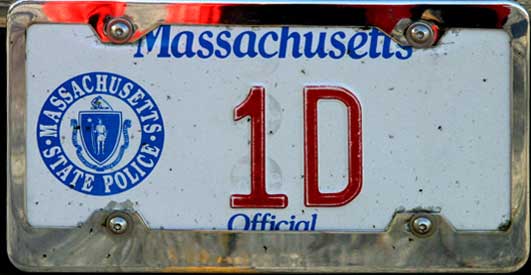 The flags are each 90' X 21' and have to be hoisted by crane to fly in the wind or by hundreds of persons when displayed on the ground. The Flag Truck is housed outside of Boston, Massachusetts by the driver, Mark Valentine.
The actual truck has some interesting features.
The flags are each 90' X 21' and have to be hoisted by crane to fly in the wind or by hundreds of persons when displayed on the ground. The Flag Truck is housed outside of Boston, Massachusetts by the driver, Mark Valentine.
The actual truck has some interesting features.
The official license plate for the National Flag Truck is registered to the Massachusetts State Police as "1D." which is the older designation for an MSP support vehicle.
Prior to the "Aitken issue" MSP license plate seen here, the National Flag Truck bore the previous 1981-1989 issue MSP license plate also with number 1 D.
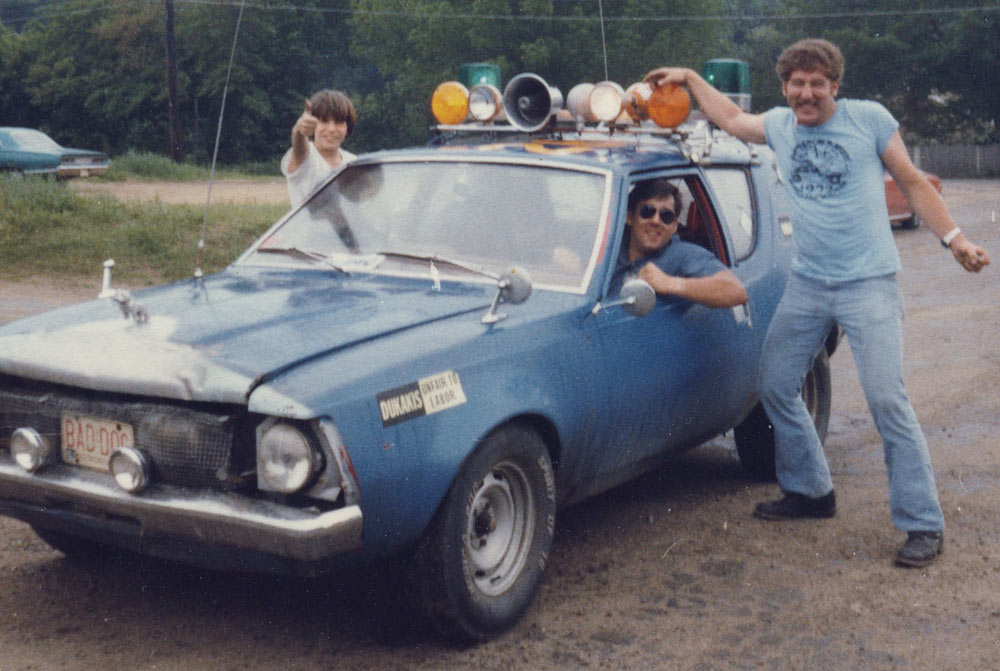
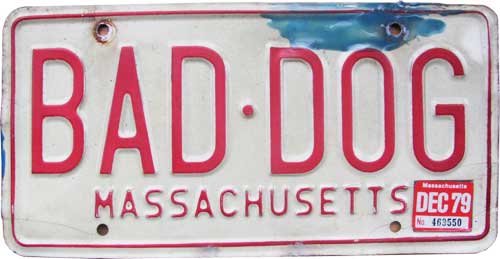 Although not an "OFFICIAL" license plate of the Massachusetts State Police, this particular personalized license plate saw its fair share of humorous "off-duty action" at the hands of one of MSP's titans of personality.
Although not an "OFFICIAL" license plate of the Massachusetts State Police, this particular personalized license plate saw its fair share of humorous "off-duty action" at the hands of one of MSP's titans of personality.
As can be seen in the photo above, this plate was fastened to the beat-up 1971 AMC Gremlin owned and operated by legendary MSP Trooper Paul J. "Bad Dog" Driscoll.
This great photo was taken in 1979 at Bimbo's Wrecker Service off Route 128 in Dedham.
This infamous car was outfitted with an upgraded alternator to power a full-functioning roof-top lightbar complete with green rotator lights and alternating amber flashers as well as "take down" lights and both an electronic AND a mechanical siren. The light on the right side of the speaker was an aircraft landing light according to PJ himself! A CB radio kept the Bad Dog in contact with "croozahs on patrol". The car was also topped-off with a Mack bulldog mascot on the hood.
Despite often spending time in the "Penalty Box" for "coloring outside the lines" and giving his superiors premature baldness, PJ Driscoll by far embodied the type of Trooper that had fun doing his job. I can speak from my many conversations I have had with Bad Dog over the years, that men like him despite being rough around the edges, could be counted on for their loyalty and their passion for their relationships with their comrades.
With so many State Police and Highway Patrol license plates in my collection, I have to count this beat-up old vanity plate with the words BAD DOG on it as one of my most cherished.
~Norm Ratcliffe
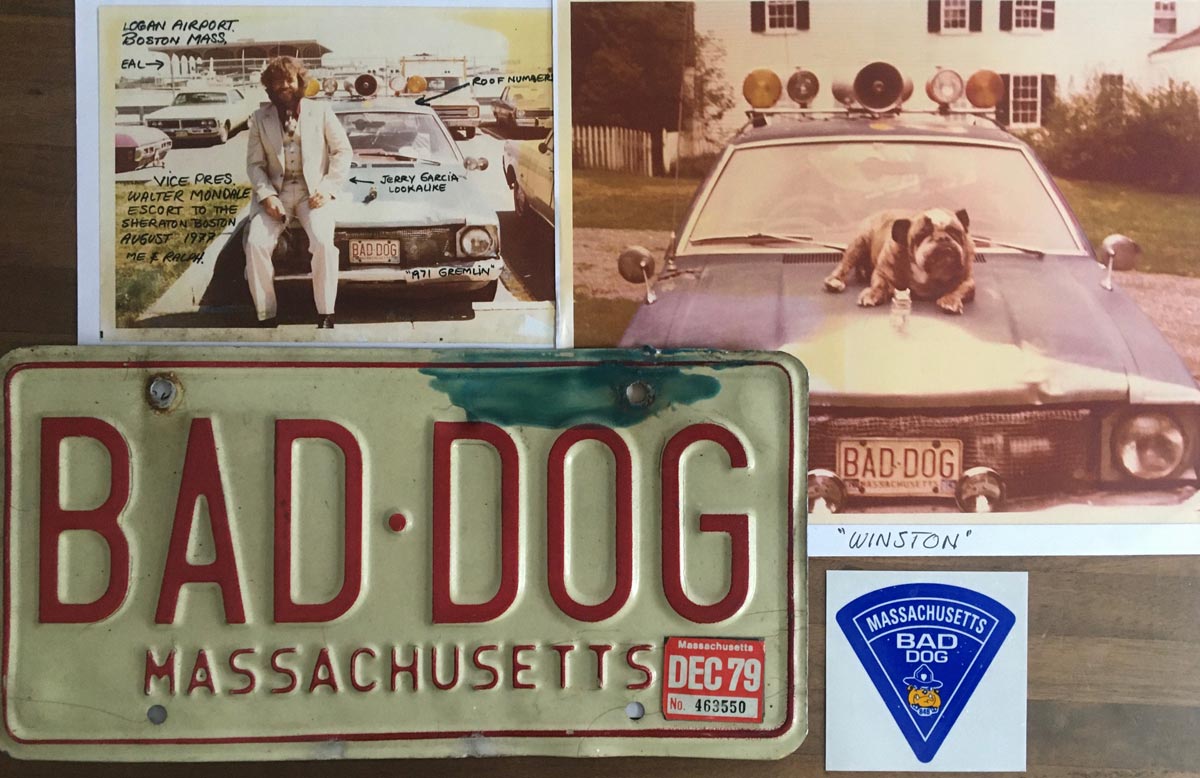
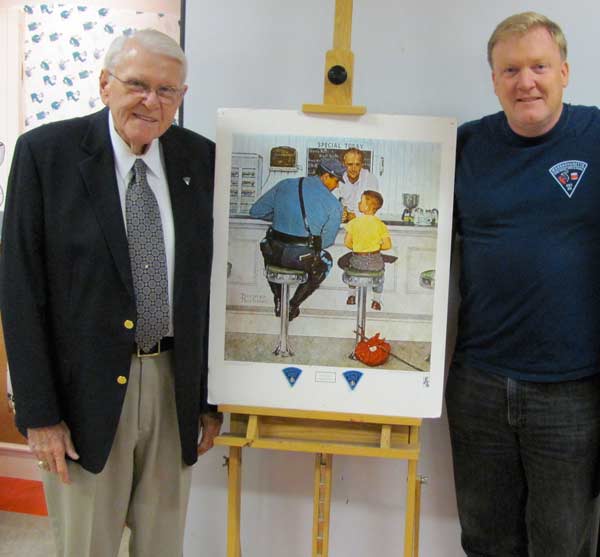 In September of 2009, I had the distinct pleasure to meet a living legend: Retired MSP Staff Sergeant Richard "Dick" Clemens, the robust-looking friendly police officer immortalized in Norman Rockwell's 1958 illustration "The Runaway".
In September of 2009, I had the distinct pleasure to meet a living legend: Retired MSP Staff Sergeant Richard "Dick" Clemens, the robust-looking friendly police officer immortalized in Norman Rockwell's 1958 illustration "The Runaway".
Provided for you below is the short story of how a chance meeting progressed to a rewarding friendship with a true gentleman and ambassador of the Massachusetts State Police during his final years here on earth. I consider myself blessed to have had our lives touch.
~Norm Ratcliffe
Thursday, September 10th, 2009 marked attending my fourth National Troopers Coalition Picnic which was hosted that year by the Delaware State Troopers Association.
The day was threatened by an impending rain and wind storm off the Atlantic, but the day started-off with some positive yet cautious promise. I had settled-in with the other vendors along the tree line and was soon greeted by my friend, Lt Jason Sapp of the Delaware State Police who had advised me and my buddies that there would be a surprise that would give us all goose-bumps a bit later on. "Norm...you're gonna be amazed...trust me" he said.
When I heard the Delaware State Police pipe band marching-up the field a couple of hours later, I figured that "the moment" was at hand and raced-up with camera at the ready as the crowd began to gather. An introduction pointed towards a distinguished elderly gentleman with a vibrant shock of white hair, dressed smartly with jacket and tie and with a most pleasant demeanor.
Situated next to him was a framed copy of the 1958
Norman Rockwell painting "The Runaway". 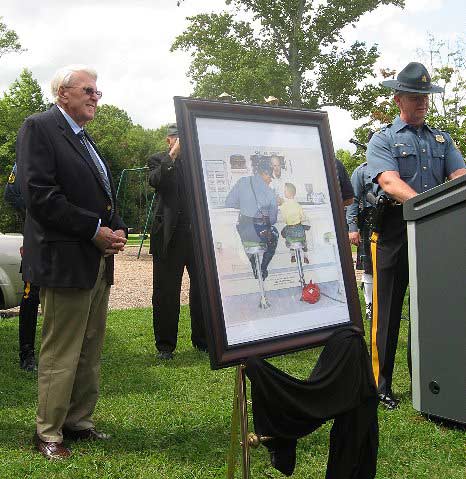
As most of us can certainly attest, this is a print that can be seen in almost every police station and "cop bar" in North America, and is a universal icon as to the image of "the policeman is your friend". As a proud and serving
Auxiliary Staff Sergeant with the Ontario Provincial Police, I can attest that in my many travels throughout Canada and the United States, this image is typically displayed in an area of prominence for every detachment, barracks, precinct house, outpost and academy I have visited. It has been given to perhaps tens of thousands of law enforcement officers on this continent as Christmas, birthday and retirement presents for decades.
Well, it didn't take the formal introduction to make me realize that this noble man standing before our crowd, was none other than the officer "himself" from this famous painting, retired Massachusetts State Police Sgt. Richard J. "Dick" Clemens !!! Clemens was a member of the 37th Recruit Training Troop of the Massachusetts State Police. He joined the agency on Oct. 23, 1953 and served until his retirement on Jan. 4, 1975.
I had always thought this painting depicted fictional characters, but not so! The crowd of us stood stoic with mouths open to hear of his story and "let it all sink in" that we were looking at and listening to a man who has been immortalized for so many now and for the rest of human history. He said that he and Norman Rockwell lived 3 houses apart on their street in Stockbridge Massachusetts. The two men got to know each other better due to Mr. Rockwell's wandering basset hound that would sometimes find his way into Clemens' yard, and the return of the dog would have to take place each time resulting in more chit chat.
In April of 1958, Mr. Rockwell approached Clemens on an idea he had for a painting that required a police officer and asked if he was willing to pose for him. The MSP gave the OK, and a closed photo session was conducted at a Howard Johnson restaurant in Pittsfield. The boy featured in the painting, is Eddie Locke who was also depicted in Rockwell's painting of a doctor giving the lad an injection to the buttock. The original counterman for the painting was a man by the name of Clarence Barrett who was dropped in favor of the featured counterman in the final illustration, Don Johnson. From what Clemens stated, Rockwell felt that the original counterman had too youthful a face and did not offer enough age contrast to the boy.
In addition, the original setting had the "trademark" Howard Johnson's 28 flavors of ice cream etched into the mirror on the back wall behind the counter. This was to get a more rustic feel for the diner, however the stools, floor and coffee cups on the counter are all from the HoJo's session. The original unfinished version and the Saturday Evening Post cover of "The Runaway" hang side-by-side in the Rockwell Museum in Stockbridge.
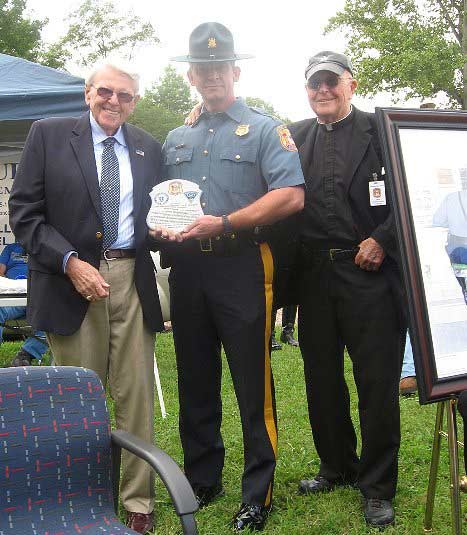
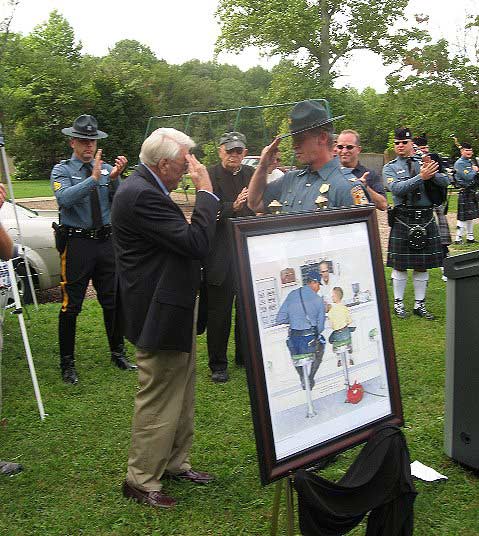
A presentation was made to Dick Clemens by Colonel Robert Coupe of the Delaware State Police, and Sarge was treated like a royal celebrity for the rest of the day, which by the way, remained rain and storm-free until just after the picnic wrapped-up in the early evening! I told my buddies in jest : "God wanted this to happen", but considering how the odds were looking so bad before the picnic, now it doesn't seem so funny.
The following day, my buddy and fellow Statetrooperplates.com contributor, Robert Ward and I drove down to the DSP museum in Dover in the pouring rain and strong wind to have a look around. Just a half hour into my visit, my friend, Lt. Jason Sapp, the man who promised me the day earlier of "goose-bumps", provided them again when he came by with Sergeant Clemens who was there for an appearance and print-signing. I had the great pleasure to meet personally with S/Sgt Clemens and have my photograph taken with him as well.
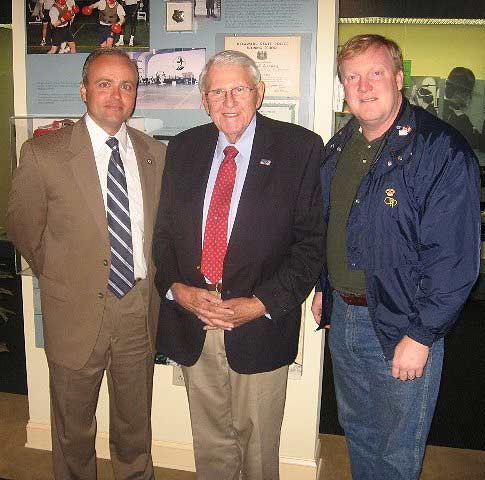
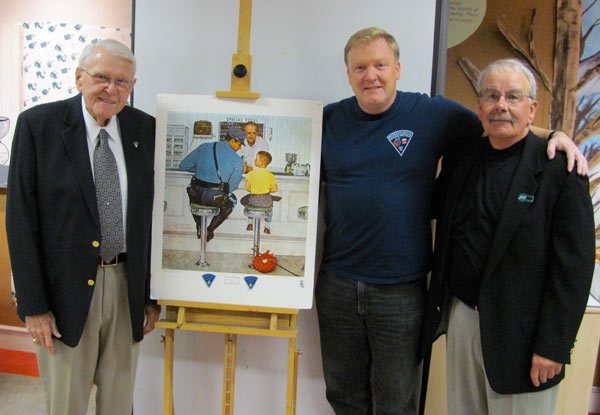
S/Sgt Richard "Dick" Clemens, Norm Ratcliffe and Eddie Locke taken at Norman Rockwell Museum, Stockbridge MA- September 2010.
When I asked him if he was tired from all the attention and action at the picnic the day before, he told me how he felt so over-fed. For a man in his eighties, he seems to still be in good shape and holds a conversation well. Nice cologne too! We should all hope to look and sound so good when we cross into our eighties. There was a special signing event for copies of the painting held in the ante room of the museum shortly thereafter which was covered by some local media. There were only so many signings of copies of "The Runaway" that were possible, but I at least had a chance to say "I met the officer from that painting and shook his hand".
(Original Scoville photos from the Howard Johnson's session in Pittsfield seen below)
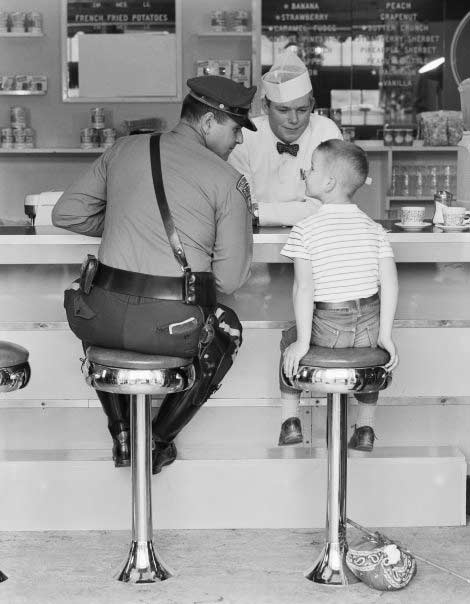
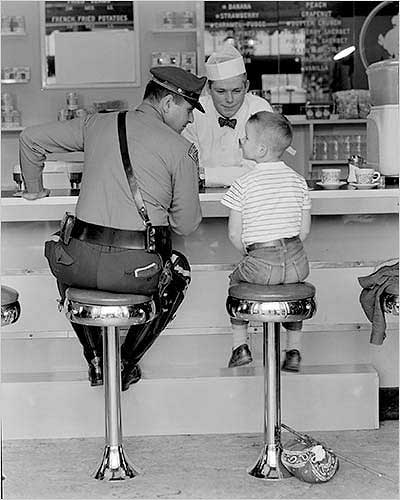
Once I had returned home from Delaware, I had sent out an email describing my encounter with Dick Clemens to some close friends of mine along with some photos. One of the friends forwarded my message to some of his friends and they did to their friends so on. One of those people down the line was a man responsible for the publishing of a newsletter for the MSP retirees.
That person then asked me for the go-ahead to use my email and photos for an upcoming edition of the publication to which I readily approved. I composed a more detailed story to read better than the original email which eventually made its way to the man himself, Dick Clemens at his home in Clifton Park NY.
S/Sgt Clemens was so pleased with the story, that he offered to sign a print of The Runaway for me!
Soon after his promise to sign a print of the famous illustration, it arrived at my home:
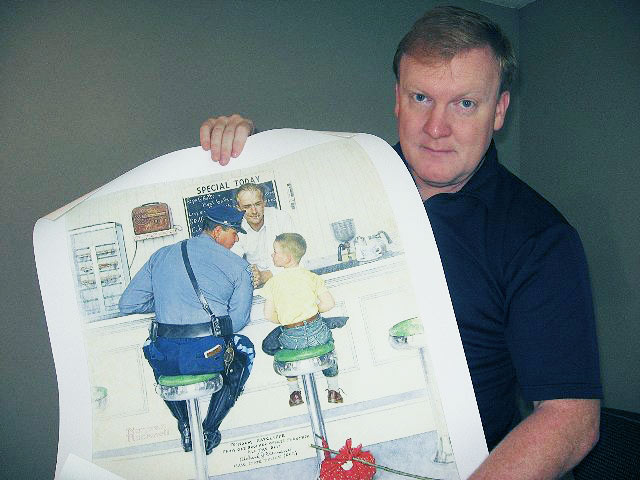
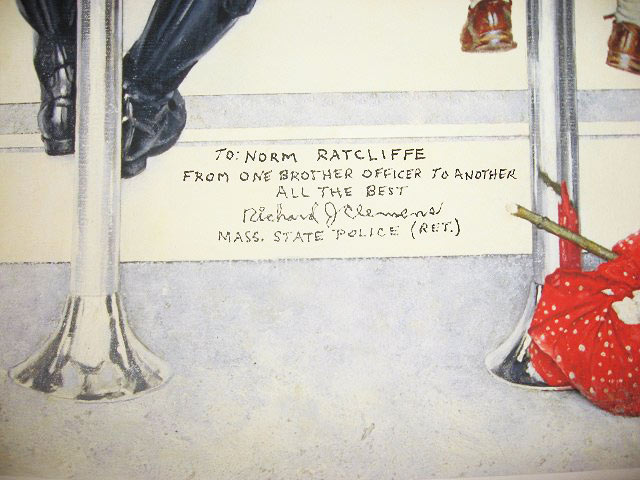
Not long after this, word had spread to my superiors with the Ontario Provincial Police about this great story. The publisher of the O.P.P. magazine, The Review had requested to publish a full-page article about my encounter which went to press in late 2011.
This whole chapter of my life made me realize that it is not often where we get to meet someone who is "iconic", although I am sure that Dick Clemens would have bristled at the sound of that heavy word. I am sure that when that painting was done, the last thing he thought of was "immortality" for himself, but being the subject matter of one of the titans of modern American Art makes you immortal whether you want to believe it or not.
Needless to say, the personalized signed print will be a treasured heirloom to pass from generation to generation in my family. What a consummate gentleman and friend he had turned out to be for me.
Despite his advanced age, this old Staff Sergeant in retirement was pretty computer-savvy, as him and I emailed each other back and forth often for the next couple of years.
Then one day, the emails stopped coming in.
On May 6th 2012, retired MSP Staff Sergeant Richard J. Clemens passed away at the age of 83. He will always be remembered by me and many others that he embodied everything that generations will view as the ideal police officer: Strong, Helpful, Diligent, a Protector and a good friend.
Rest well my good man!
